In this post, I am going to look at a range of potential vehicles that…
- Might meet the Light Mobility Vehicle (LMV) requirement, at high level
- Might exceed it
- Might meet only some parts of it
Vehicles in category 2 and 3 are if the requirement for a common base vehicle was changed, and the Tactical Mobility Vehicle (TMV) variant was competed separately, given it is a specialised user group.
As I discussed in Part 1, the benefits of a common base vehicle across all roles and variants are obvious, but they can lead to a narrowing of vehicle and vendors choice, reduction in innovation, and the exclusion of SME’s.
There will be less familiar vehicles in this list, but I thought it worth casting a wide net, and it is a long post.
AEBI Transporter MT760 and TP410
The AEBI Transporter is a good example of a vehicle unlikely to meet the LMV requirements for many reasons.
However, like a few other examples in the rest of this post, they are worth looking at because they offer an interesting alternative approach, especially for the upper end of the payload requirement and beyond.
The permanent 4-wheel drive Aebi MT760 has a payload of 3.5 tonnes with a maximum vehicle weight of 6.5 tonnes, and can also tow a trailer weighing 3.5 tonnes.
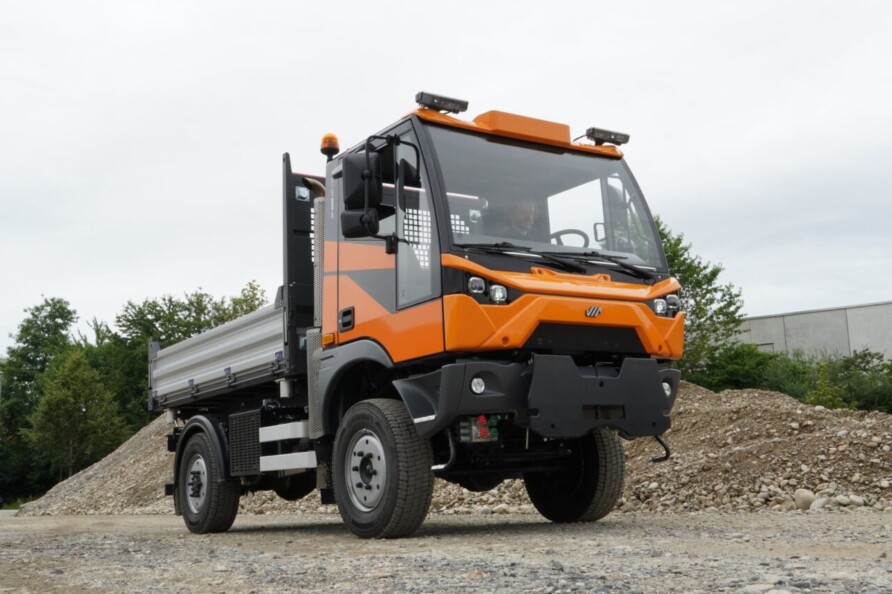
Top speed is 89kph, and at 1.7 m wide, transportable side by side in an A400M
The TP410 improves on this, with a GVM of 6.5 tonnes and kerb weight of 2.35 tonnes, with a payload of 4.15 tonnes, an excellent 64% of GVM.
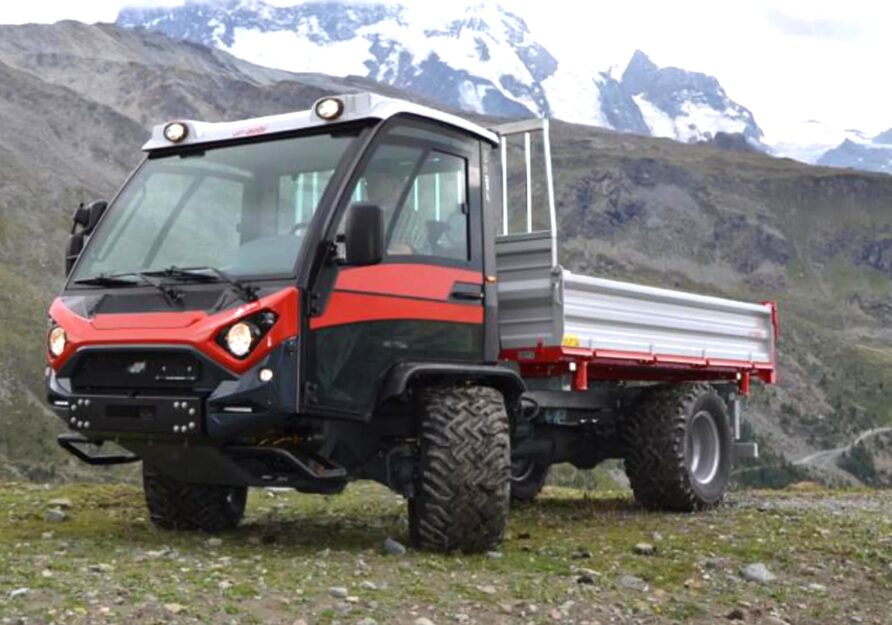
Although, speed is reduced to a leisurely 40kph, so not that useful in this context.
Agrale MARRUÁ
Agrale from Brazil has a wide range of utility vehicles.
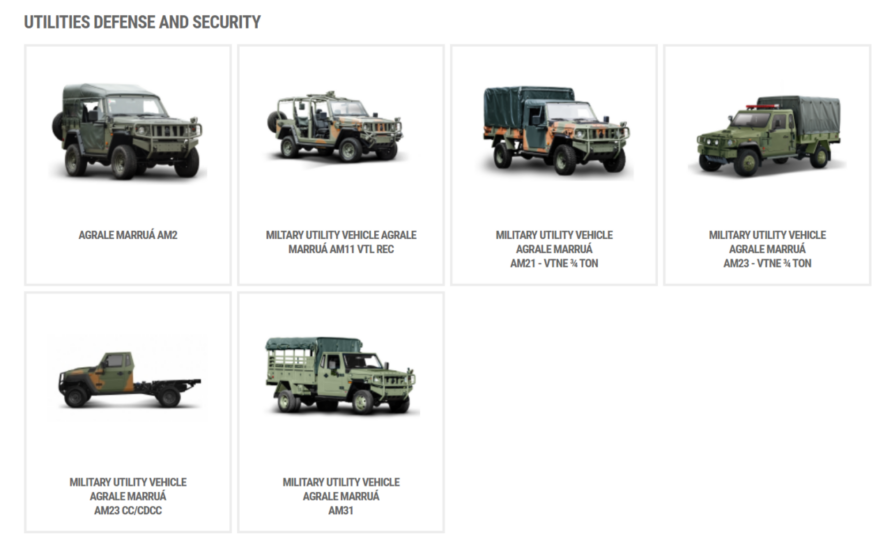
The smallest is the AM2, only two seats, and with a small payload of 770 kg in a vehicle with a GVM of 3.32 tonnes, not brilliant.
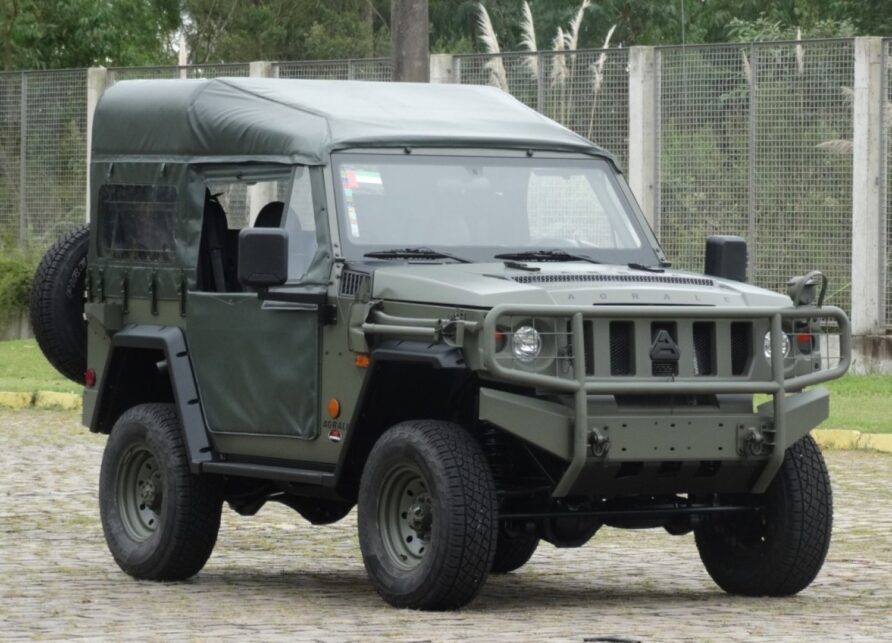
The longer wheelbase models all exceed 3.5 Tonnes Gross Vehicle Mass, the AM23 variant below, for example.
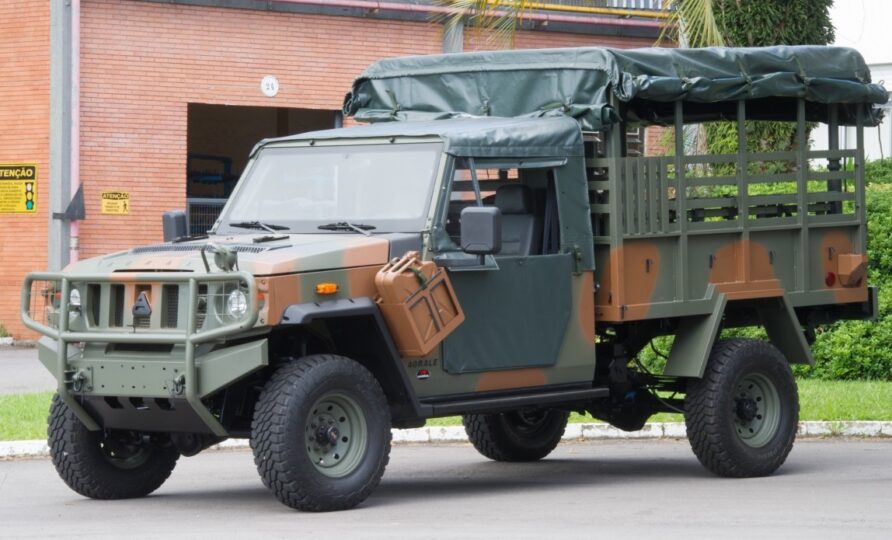
This has a GVM of 4.6 tonnes with a payload of 1.737 tonnes (a still not brilliant, 38%)
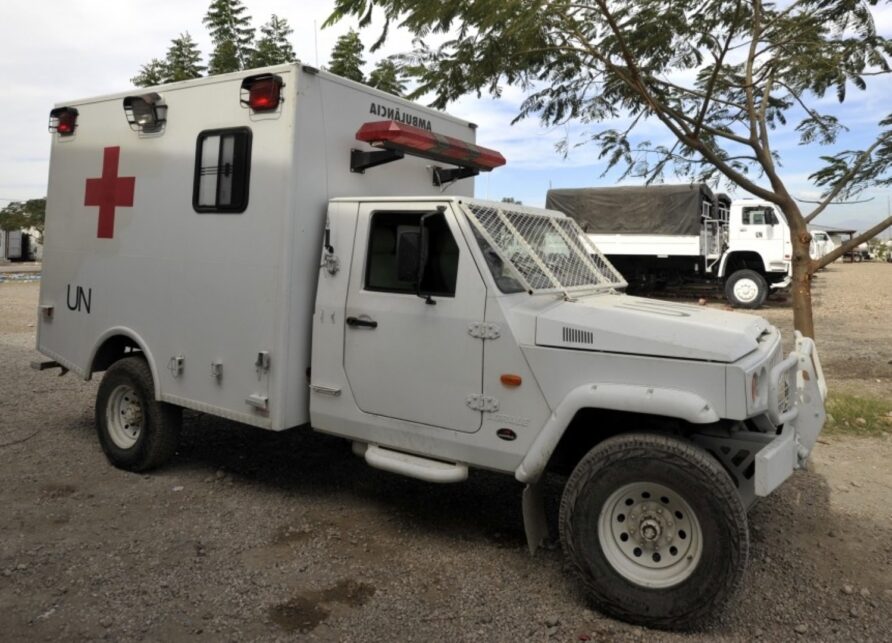
But it is available in a right-hand drive form and numerous variants.
Bonetti FX100
If one is prepared to look at the Utility Variant separately, the Bonetti F100X is typical of a small 4×4 industrial and agricultural vehicle that are common in areas where small size and load carrying capacity are important.
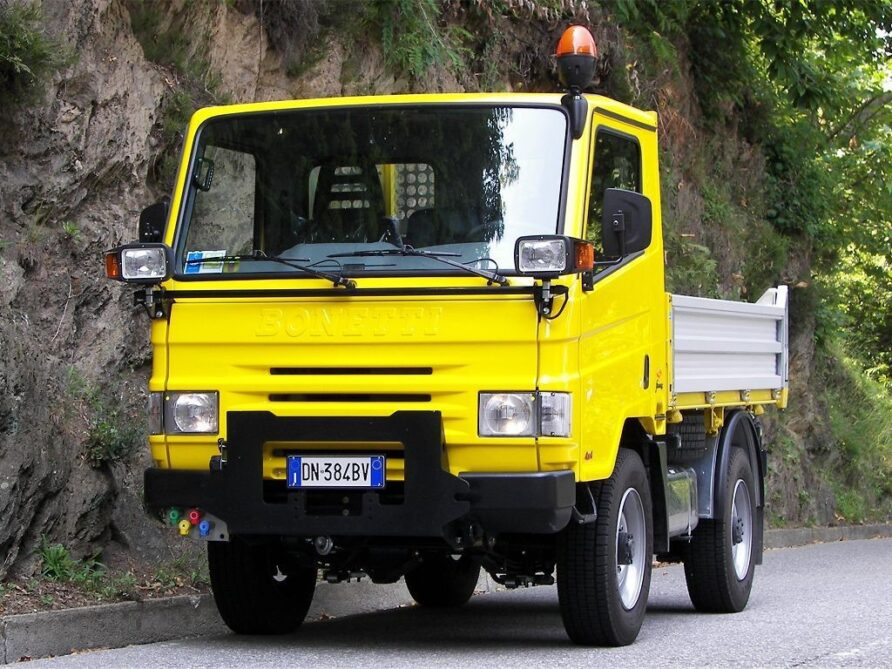
It is available in different wheelbases and models; a chassis cab, three-way tipper, three-way tipper and hydraulic loader crane, and a hooklift.
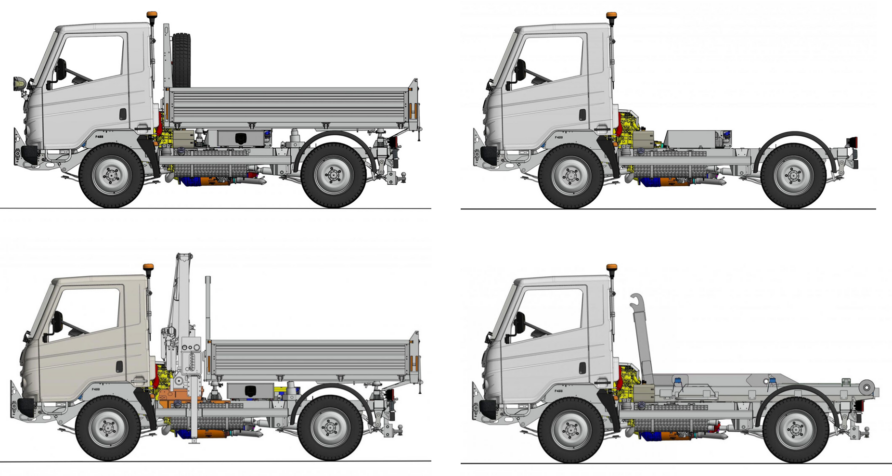
Kerb weight is version-dependent, but the long wheelbase tipper is 2.665, with a GVM of 5.7 tonnes and a payload of just over 3 tonnes, or an excellent 53%.
Mobility is good.
It uses standard 215/75 R tyres, commonly found on all sorts of vehicles, on and off road.
A command or ambulance pod could be easily fitted to the chassis cab variant. It has two seats plus a central jump seat, and can also tow a 3.5-tonne trailer.
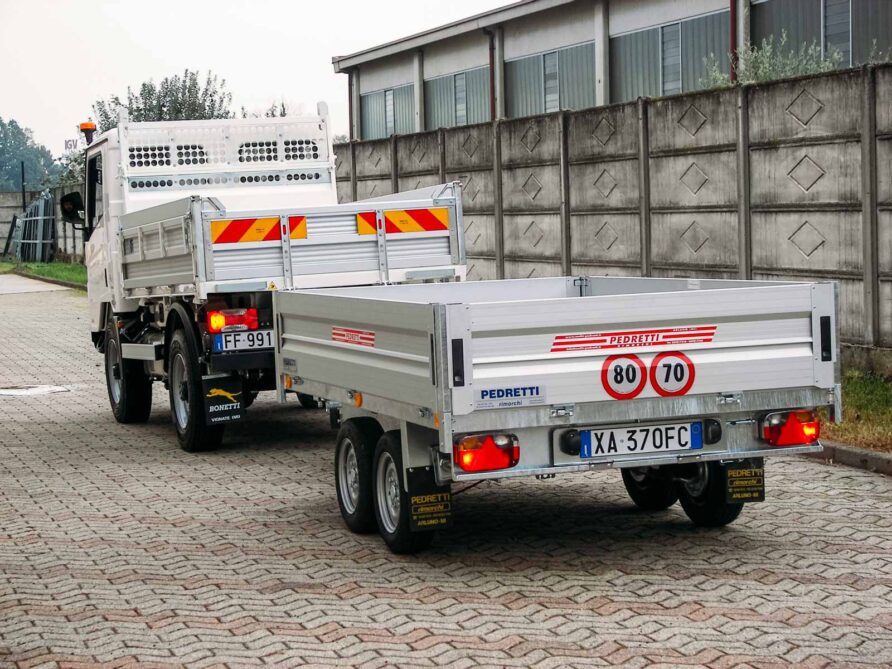
At a compact 1.65m wide, the tipper body load bed is 2.92 m long, in a vehicle that is only 4.6m long, or about the same length at a Land Rover Defender.
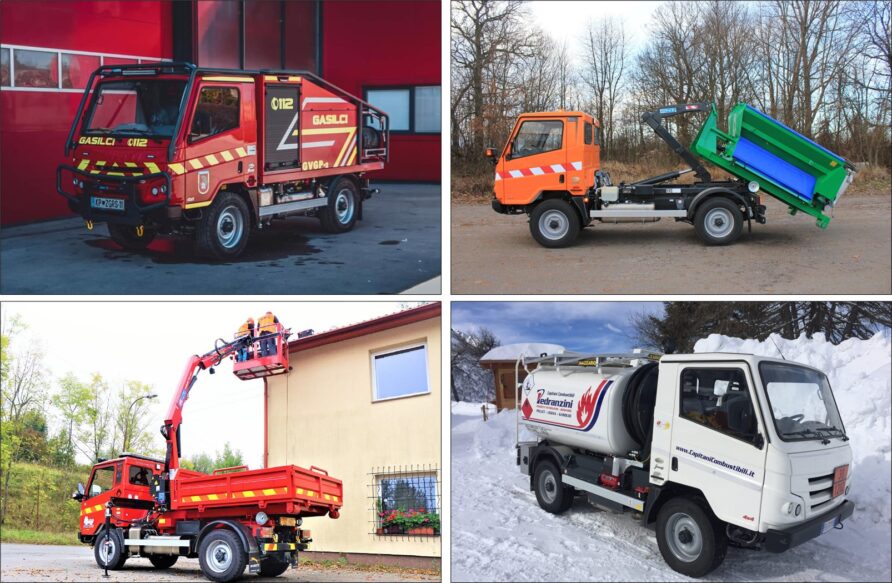
The load bed is large enough for a couple of NATO pallets and JMIC’s, a double CDS, and all the Shark Cage and Rapid Readiness boxes, with double that on a suitable trailer.
That is a lot of gear in a vehicle that can fit two abreast in an A400M and be quite at home in narrow streets and close terrain.
Caron CTK
Like the Aebi vehicles, the Caron CTK is primarily aimed at the agriculture and forestry markets, not known for their love of flimsy and expensive to run machines.
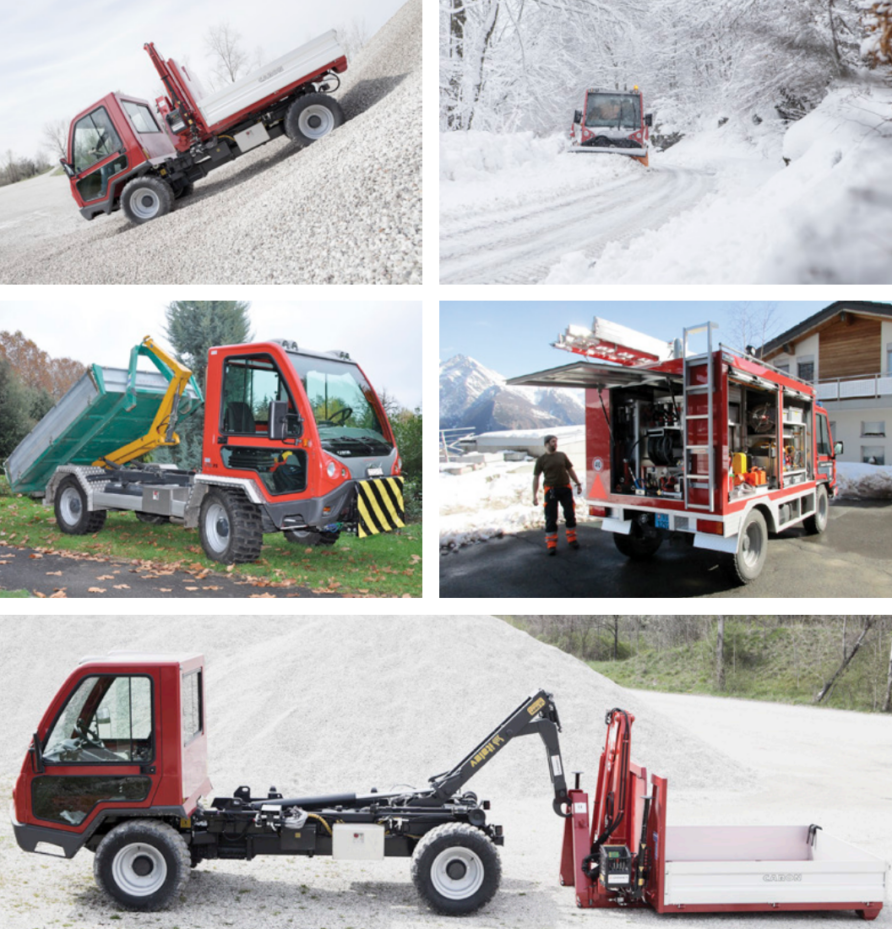
It has a choice of 3 wheelbase variants 2600, 2800, and 3000 mm, and the chassis can be fitted with various bodies and hydraulic equipment.

The long wheelbase variant is 5.29m long and 1.72m wide, with a load bed that is 3.16m long and 1.7m wide, slightly longer than the Bonetti F100X.
Towing capacity is a very high 14 tonnes, with a payload of 5 tonnes in a 7.5 tonnes GVM.
Like the TP410, the maximum speed is a sedate 40 kph, with fixed axles.
The CTK-M is similar, but adds suspension to enable an increase in speed to 60 kph, and also increases GVM to 8.5 tonnes (beyond the limit of a C1/C1E licence)
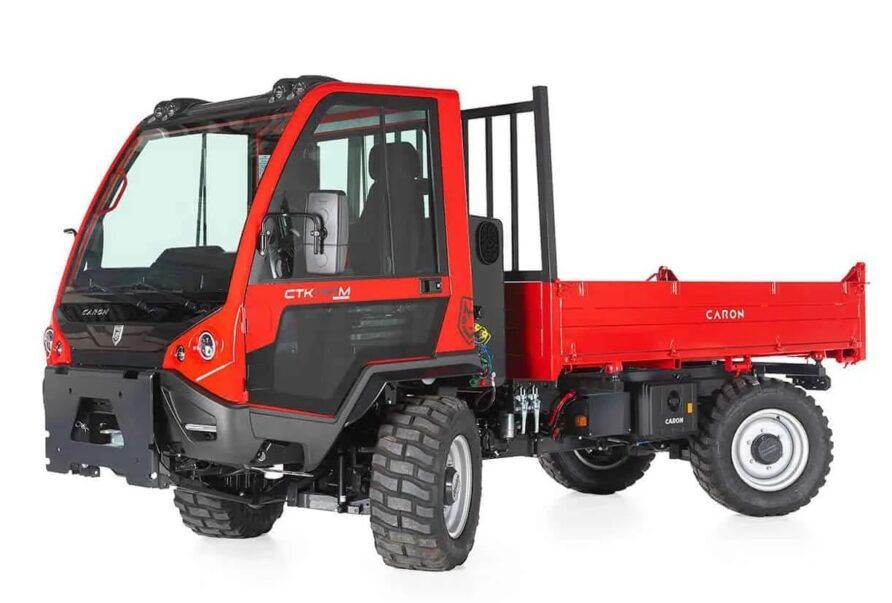
Both can use hydraulic and PTO equipment, and have four wheel steering options.
Comaca Pantera
The Comaca Pantera is not dissimilar to the Caron, Bonetti, and Aebi vehicles above, except it has a GVM of 3.5 tonnes.
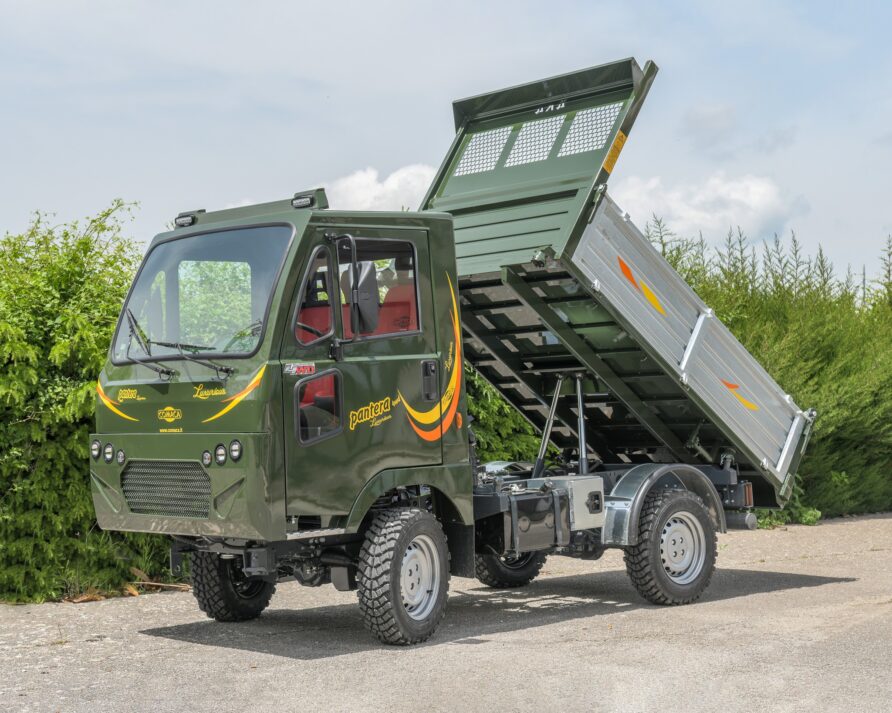
With 4-wheel drive and an Isuzu diesel engine, it has a GVM of 3.5 tonnes but can carry 1.8 tonnes as payload, that’s a whopping 56% of GVM.
Only two or three seats, though, and with a max speed of only 40kph, hardly sporty, but the 2.4m × 1.57m tipping load bed could accommodate a decent size payload.
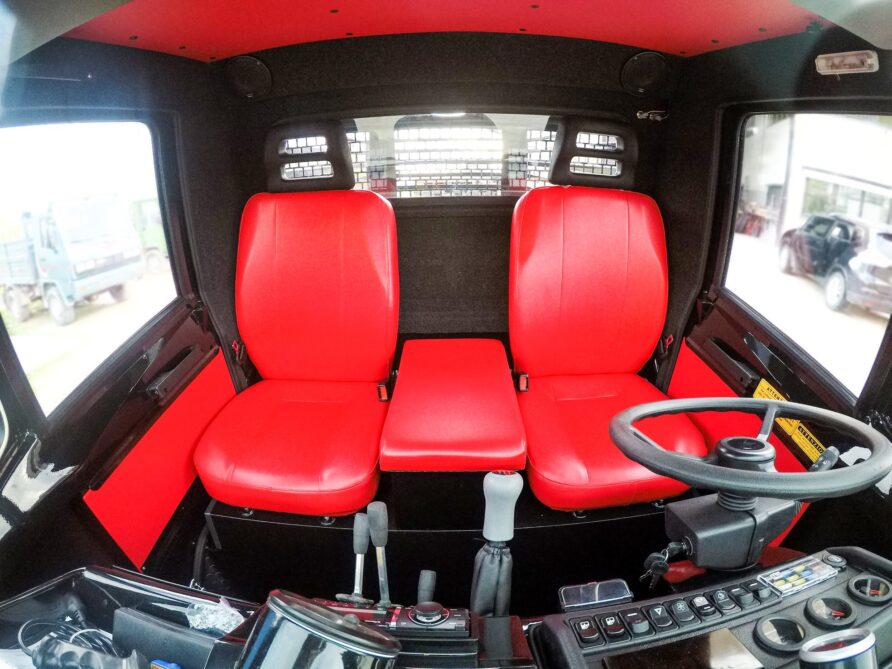
With very few creature comforts or electronic mobility aids, and simple mechanical controls, maintenance, and repairability should be straightforward, and they are eminently transportable, Chinook external and A400M internal.
There are also larger models available, with higher payloads, yet still compact and able to tow a 3.5 tonnes trailer.
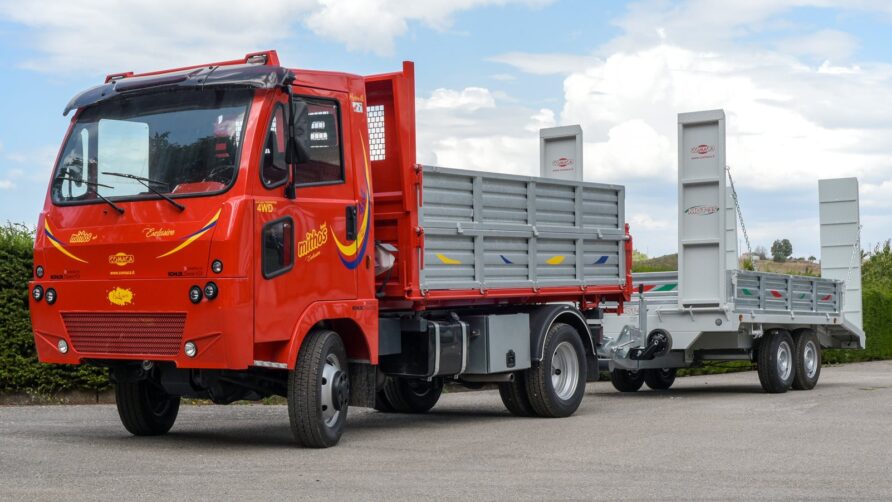
The Mythos has a GVM of 5 tonnes and a payload of 3.2 tonnes, or 64% of GVM.
Defenture GRF
Enjoying a recent run of sales, the Defenture GRF is a bespoke design, not based on a commercial vehicle.
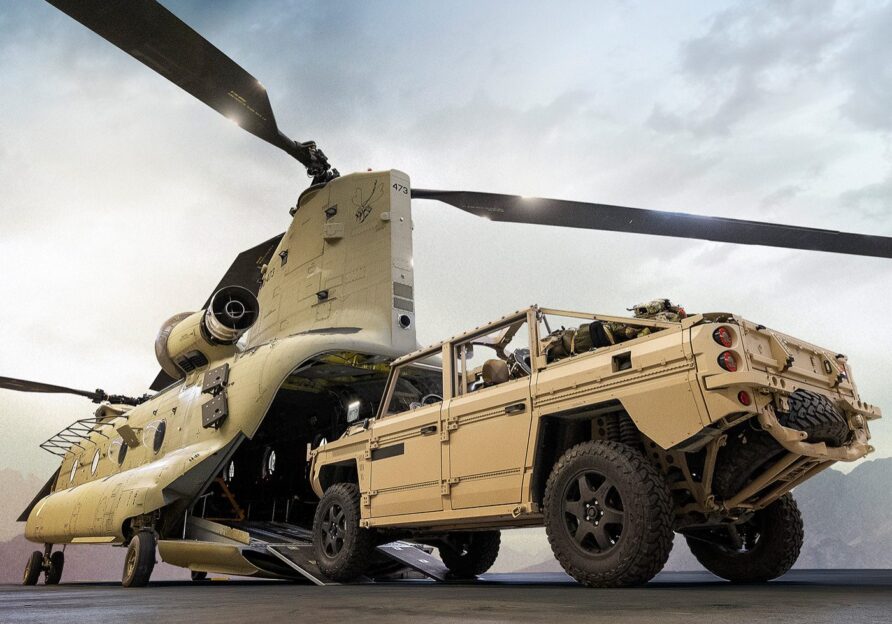
It would only be suitable for the Tactical Mobility Vehicle (TMV) requirement.
Kerb weight is 3.16 tonnes, GVM 4.6 tonnes, and payload, 1.44 tones (31% of GVM).
Fering Pioneer X
The British designed and built Pioneer X is the latest iteration of a remarkable vehicle that has been in development for several years.
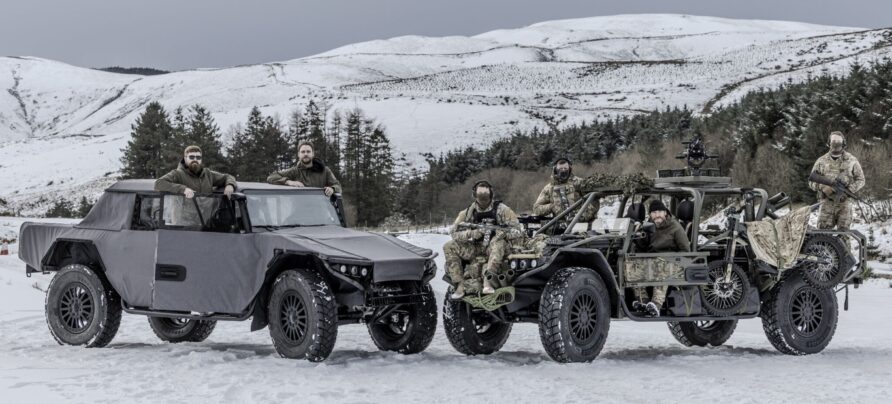
This latest version has centred on the SF type specification that could potentially meet the Light Mobility Vehicle — Tactical Vehicle requirement, although arguably less so for the others.
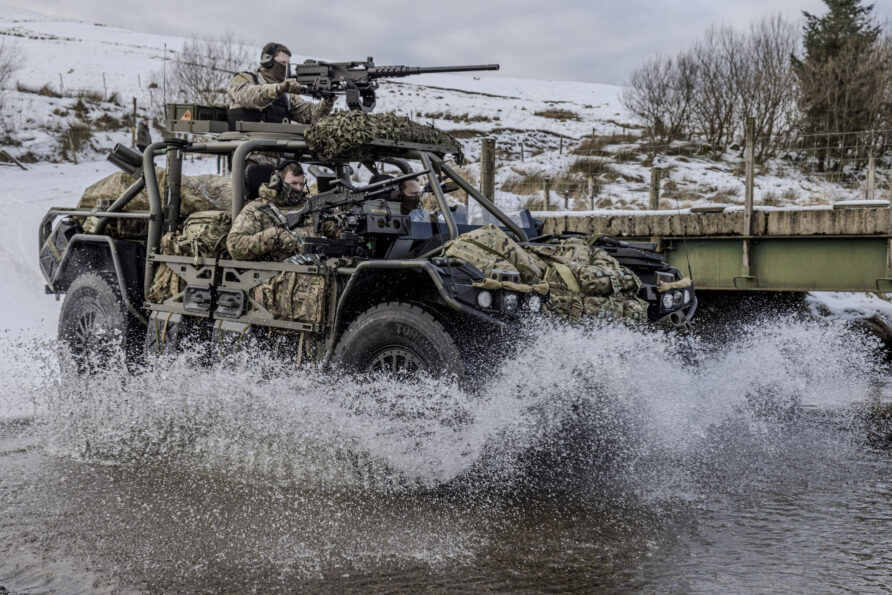
Fering started with a clean sheet design, and built a sophisticated Hybrid Electric drivetrain around a lightweight frame that provides extreme range and 60 kWh of power export.
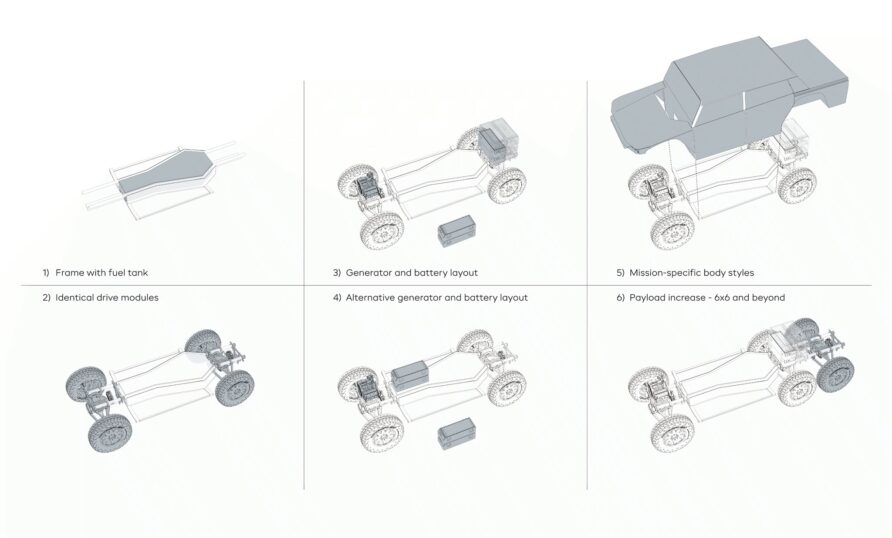
Various body configurations were envisaged, with a simple four-door pickup truck style shown in the image below.
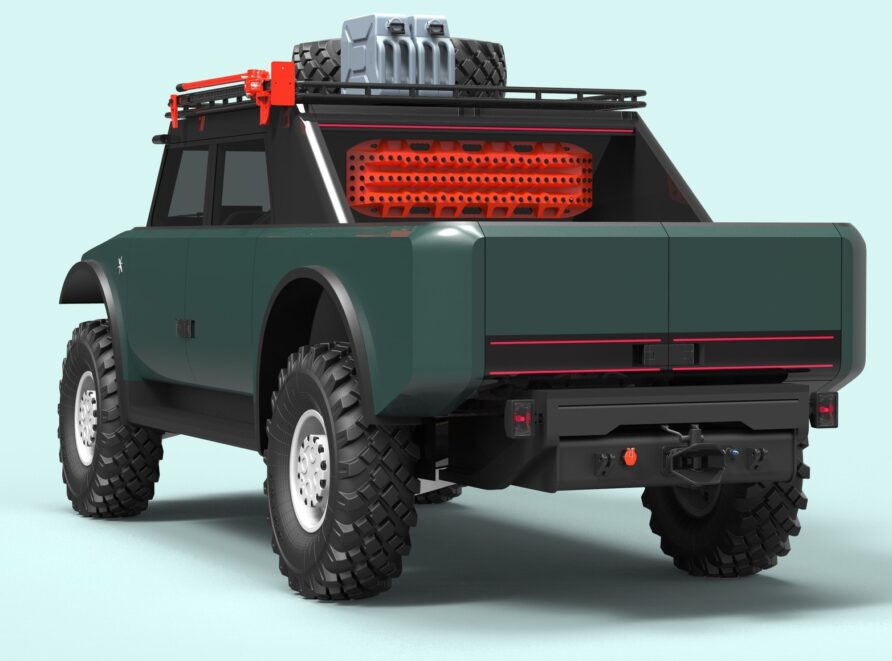
As design and development work commenced, Fering opted for Dyneema fabric body panels, everything was focussed on weight reduction, a kg less on steel door panels is a kilogram more payload.
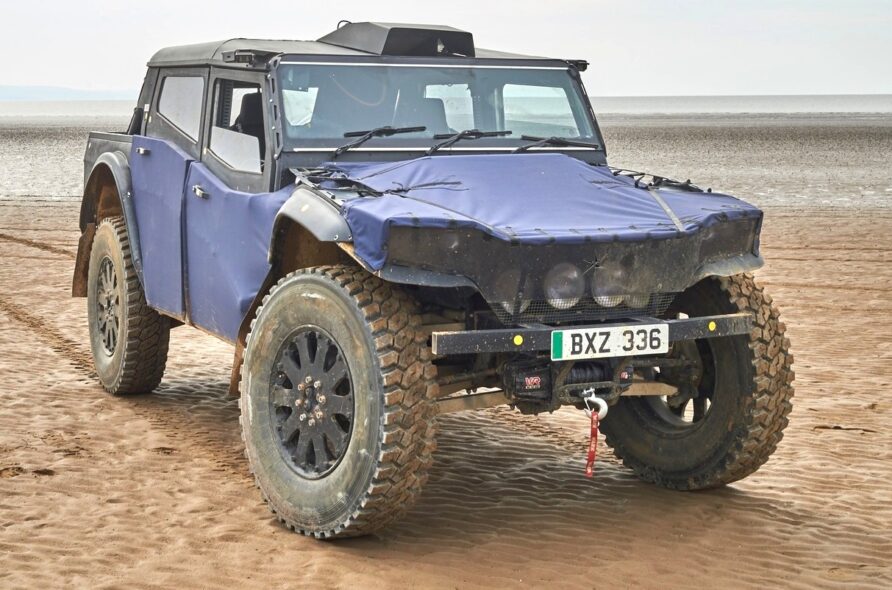
High strength fabric body panels are an excellent idea and provide a good level of damage resistance in the outdoor environment, they are easy to repair, and have good insulation.
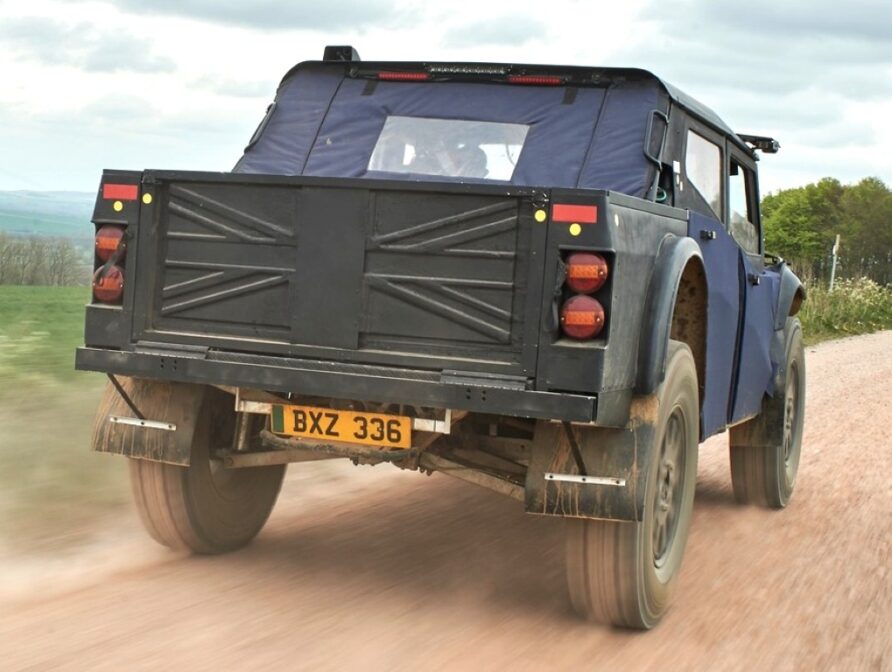
With a GVM of 3.5 tonnes and Kerb Weight of only 1.65 tonnes, the payload is 1.85 tonnes, an exceptional 53% of GVM.
With variable height active suspension, high torque (650 Nm per axle), and large wheels, mobility is also excellent.
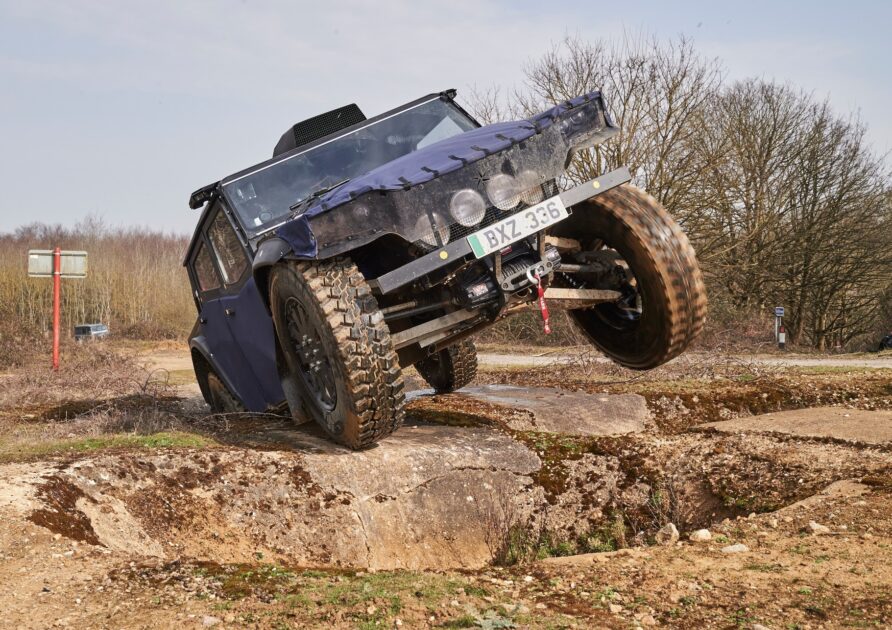
If less extreme range were needed, one could image the weight saved being traded for additional payload or equipment, although some reporting indicates that the large 470 L fuel load is not included in the payload figures above.
The vehicle’s unique features are its modular spine, the battery system, the suspension system, the hybrid electric power train system and a fabric body system.
The load bed can accommodate a standard pallet or small shelter.
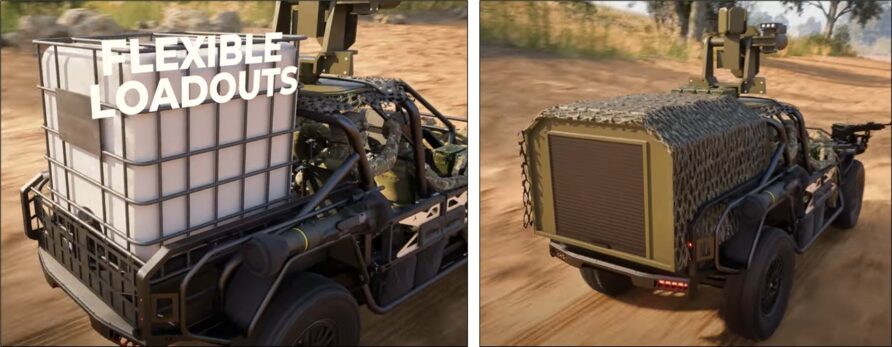
They are working on a 6×6 variant that, and although it adds 250 kg to the kerb wight, it increases payload by a tonne.
Flyer Defense 60 and 72
The GD/Flyer Defense Flyer 60 is a specialised vehicle designed for internal carriage inside a V-22
Available in standard, up-gunned, as a rescue vehicle with stretcher attachment points, and an armoured version, providing basic small arms and blast protection for the crew and passengers.

Whilst it might make a good future choice for the Royal Marines and their Merlin helicopters, it would make a poor Light Mobility Vehicle.
But if the Royal Marines did select the Flyer 60, there might be some commonality benefits with the larger Flyer 72 and the Tactical Mobility Vehicle (TMV), as part of the Light Mobility Vehicle programme.
Many stars would have to align, and it would mean users like 16 Air Assault Brigade using a specialist vehicle, it might make more sense for them than a pickup-based LR WMIK replacement, especially for Chinook internal carriage.
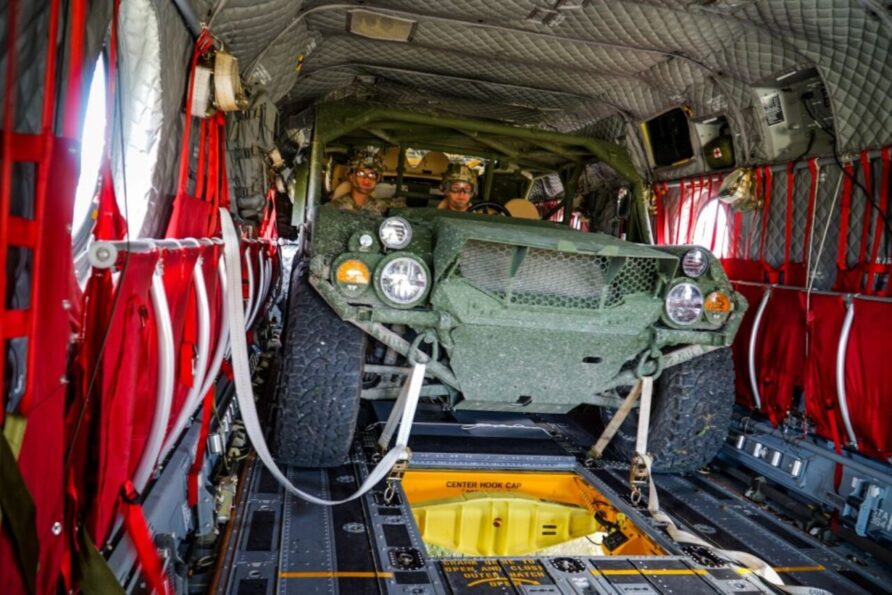
It is in service with the US Army in the Ground Mobility Vehicle 1.1 guise, and the Italian MoD has also recently selected Flyer 72, included local assembly by Tekne.
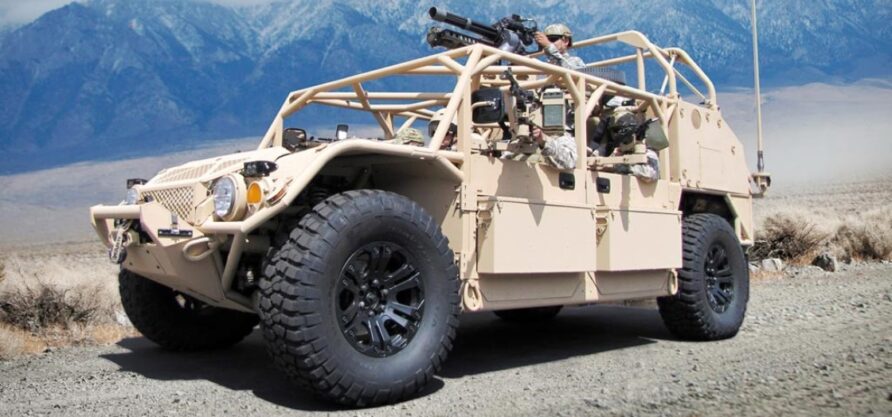
Multiple options and variants are available.
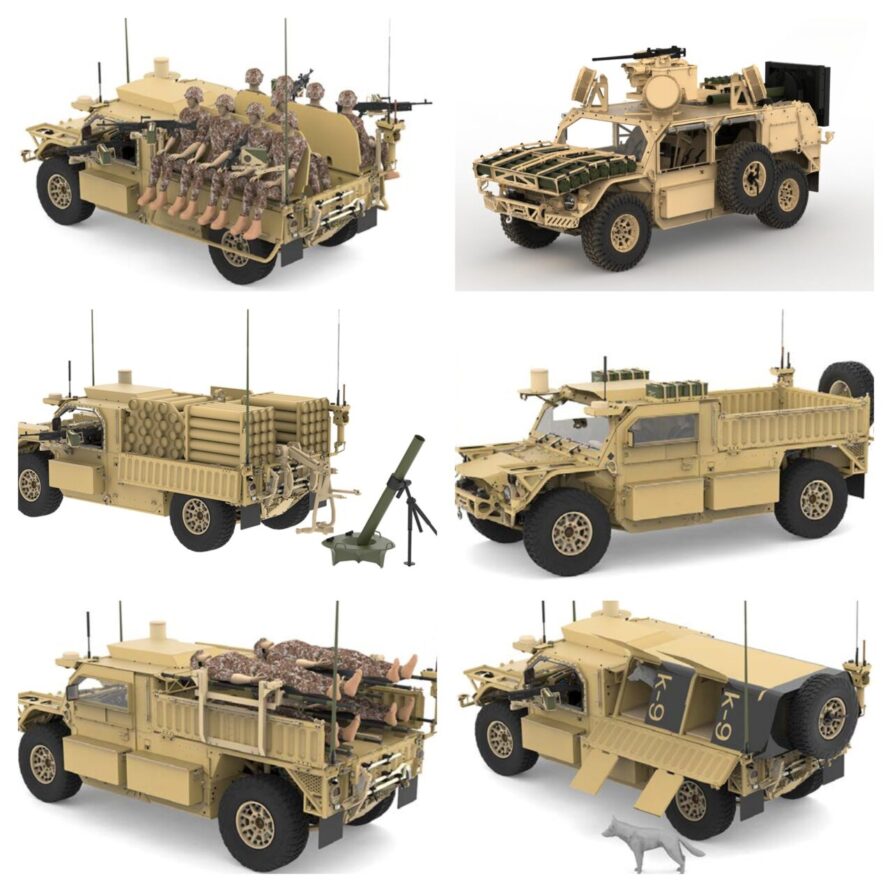
Latterly including C-UAS and loitering munition carriers.
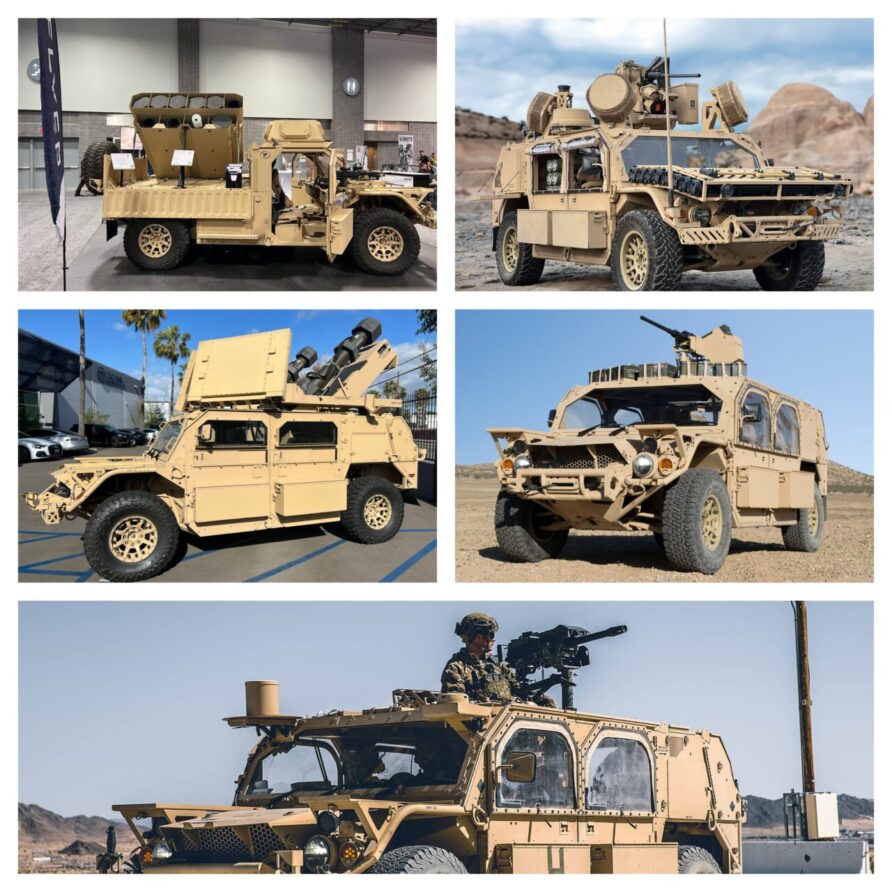
There is a lot to like about Flyer 72, but is expensive, hardly a general service vehicle.
Foers Engineering Ibex F8
Ibex Vehicles are made in Sheffield, with a constantly evolving high mobility design that has stood the test of time. Some of their vehicles are still in service 30 years after being purchased.
The vehicle can be fitted with a unique centrally mounted winch, accessible from the cab, allowing front and rear winching without affecting the vehicle’s profile or suspension.
Different wheelbases and body types are available, the 300 Series shown below.
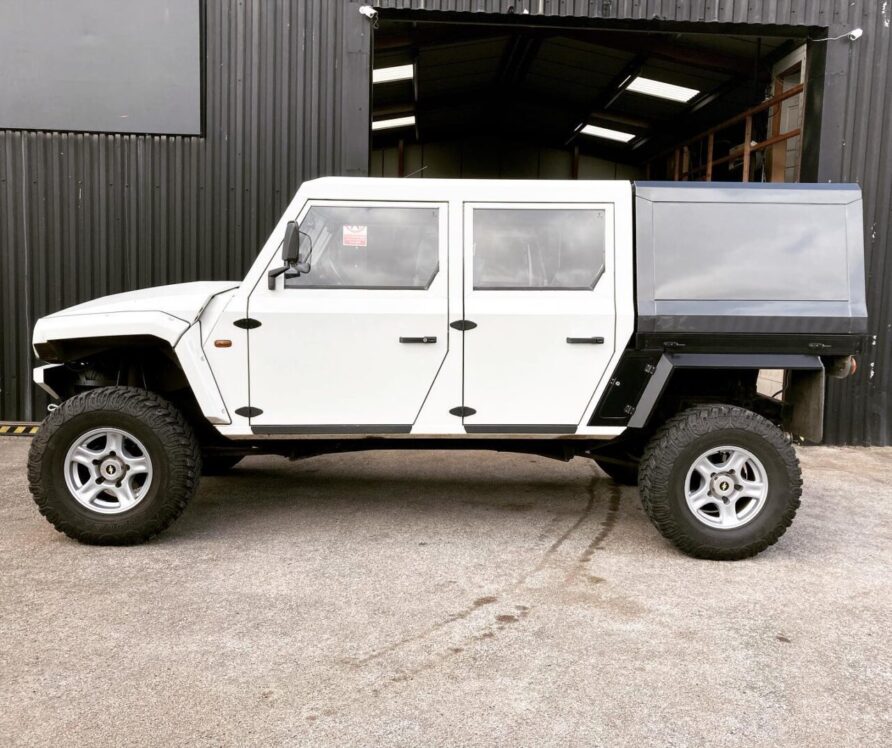
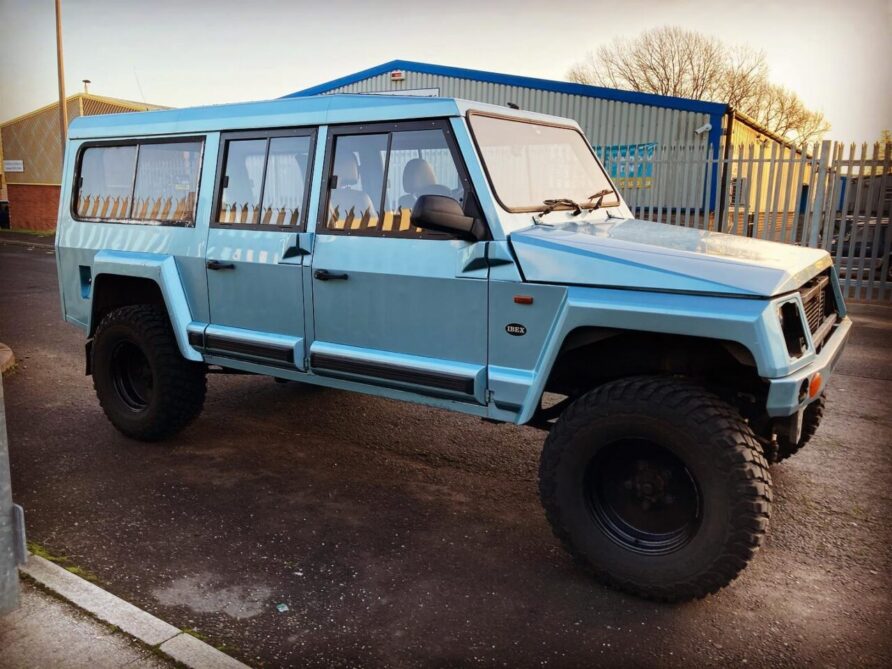
An extra long wheelbase version called the 360 Series is also available.
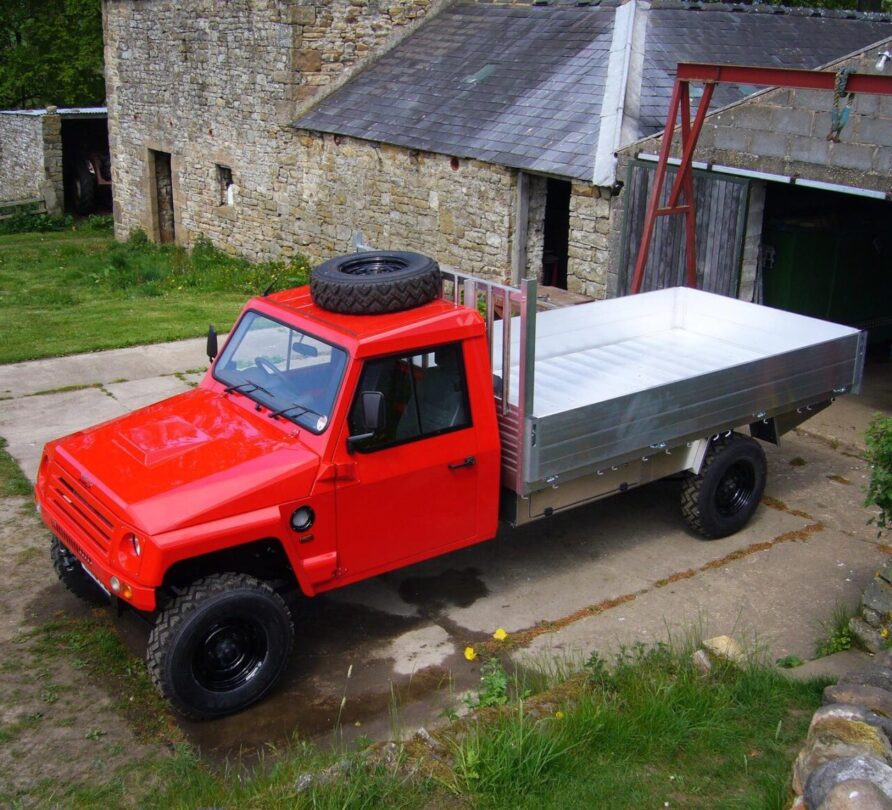
The design could be adapted to suit a box body for the C2 and ambulance LMV requirements.
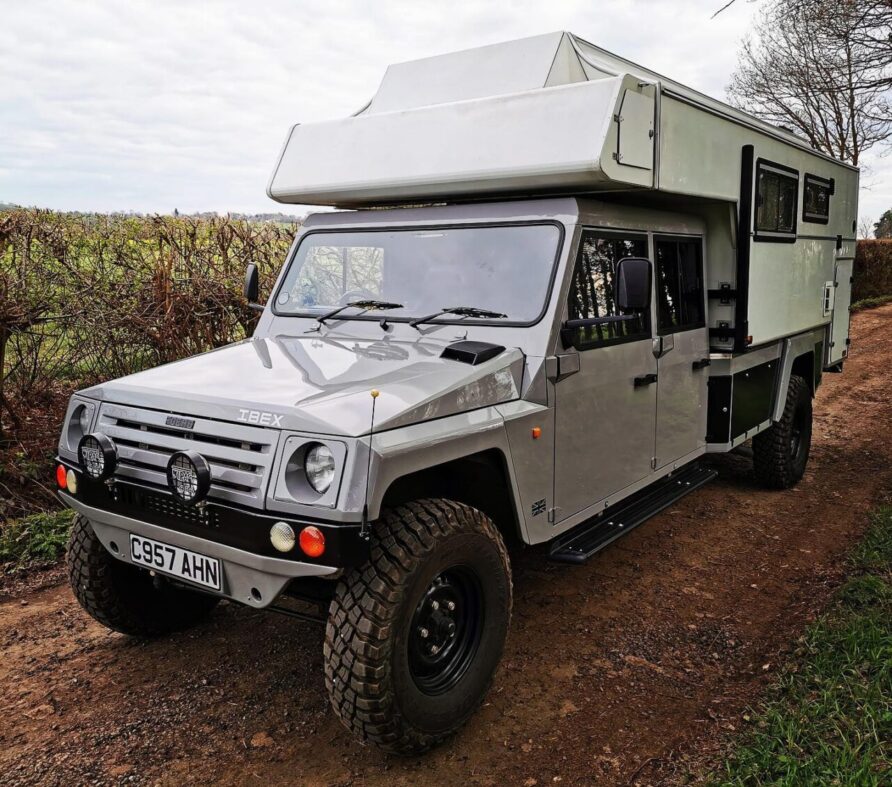
The image below shows an extended 2+2 chassis cab model.
Its rear ladder frame section provides a mounting plane for rear-mounted bodies. It has an enlarged 270ltr capacity fuel tank, air suspension, remote reservoir shocks, diff locks, super heavy-duty axles and drivetrain, full underbody protection and body armour, stealth-mounted winch, and pre-filtered raised air intake.
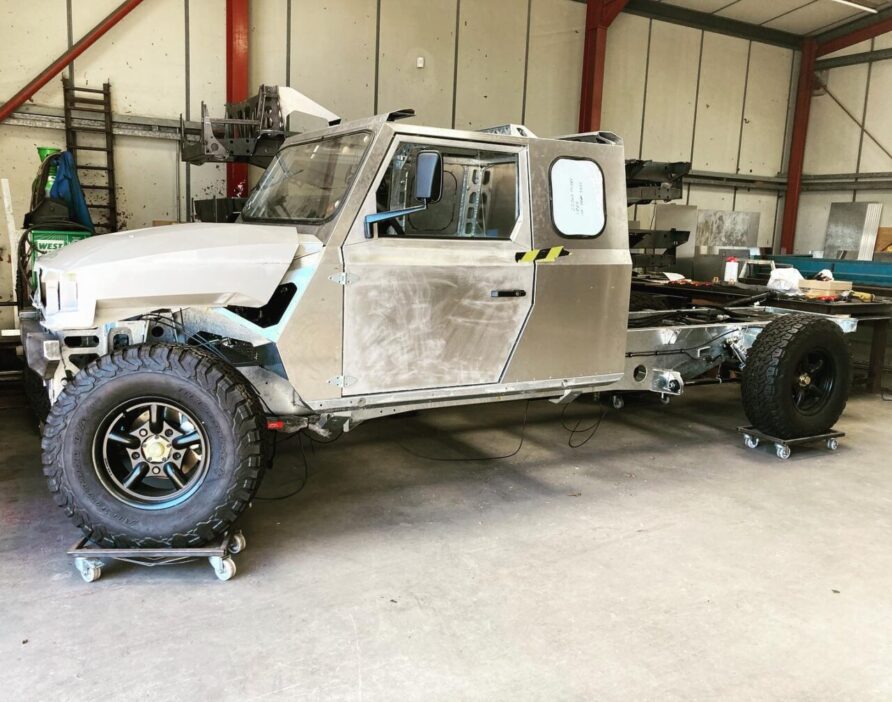
The design is extremely flexible and can use component sets from the global volume market, an important consideration for vehicles that will be used overseas and over a longer period. It can use ex Land Rover parts or new components, for example, the familiar 2.5L Land Rover turbo diesel, or a BMS 3.3L diesel.
Payloads are excellent, the 300, 330, and 360 series can carry 1.48 and 1.55 tonnes, with a GVM of 3.5 tonnes, between 42% and 44%.
A 6×6 variant is also available, with a GVM or greater than 3.5 tonnes.
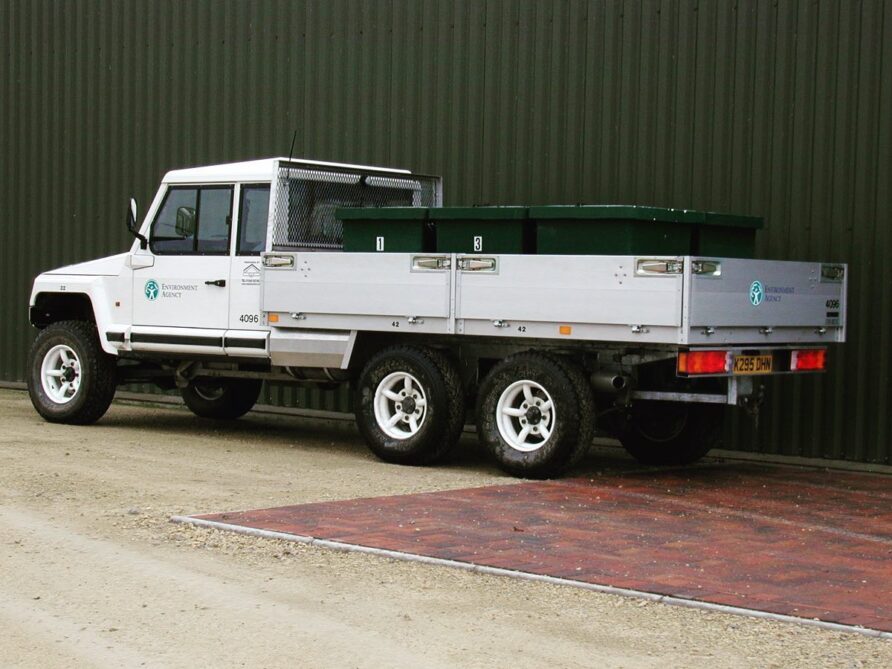
Ibex is an SME and doesn’t produce vehicles at high volumes.
Ford Ranger and Everest
Probably closer to expectations for the Light Mobility Vehicle (LMV), the Ford Ranger is already in service with the Military Provost Guard Service (MPGS).
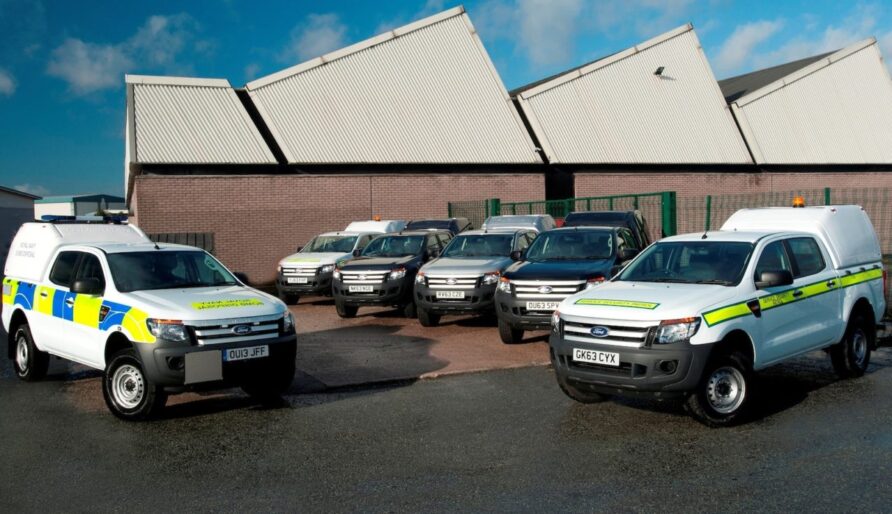
In 2013, the UK Ministry of Defence (MoD) selected the Ford Ranger for a contract to supply 104 Ranger XL models. These were entry-level trim vehicles equipped with dual-range four-wheel drive and offered in various cab configurations (Regular, Super, and Double Cab)
The Polish Army and French Army also use them.
Supplied through Glomex MS Polska (a Polish branch of the Czech company Glomex Military Supplies), the Polish Army has approximately 900 Ford Ranger XLT’s.
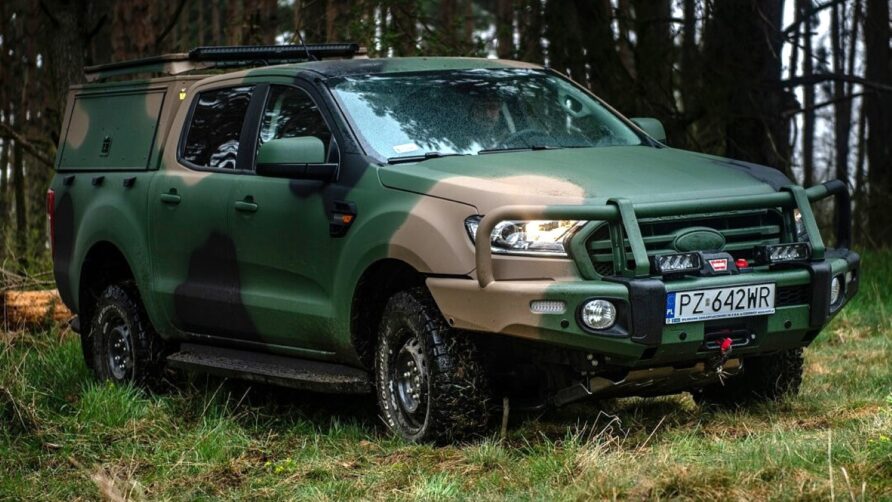
These were obtained in two contracts, the latter being roughly £55k each
The Ford Ranger serves the French Army in two key forms: the 2015 batch of 1,000 civilian XL models for domestic utility and the Arquus Trigger LTV for tactical roles.
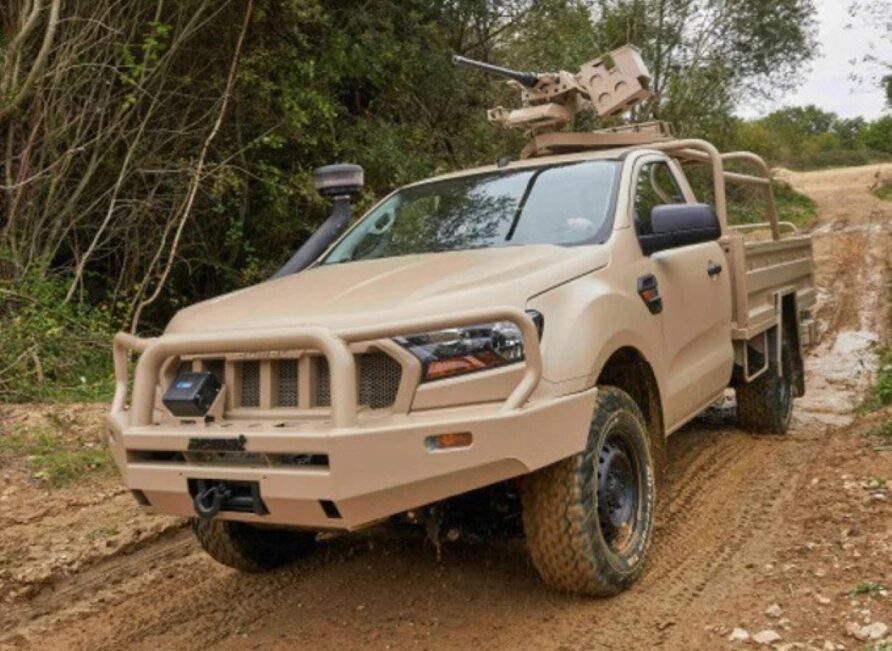
RMA Special Vehicles have marketed the Ranger Light Tactical Vehicle that includes a rear mounted electric motor for 20 km silent running, and similar performance specifications to the Arquus Trapper.
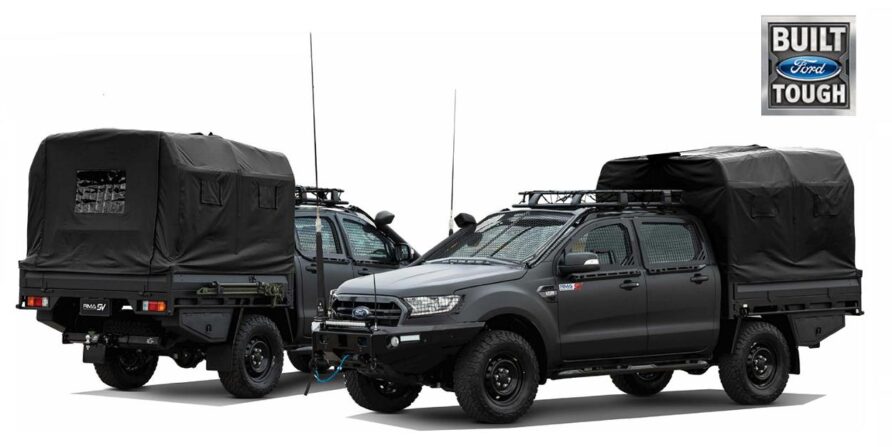
Ricardo also offered a Ford Ranger to the British Army.
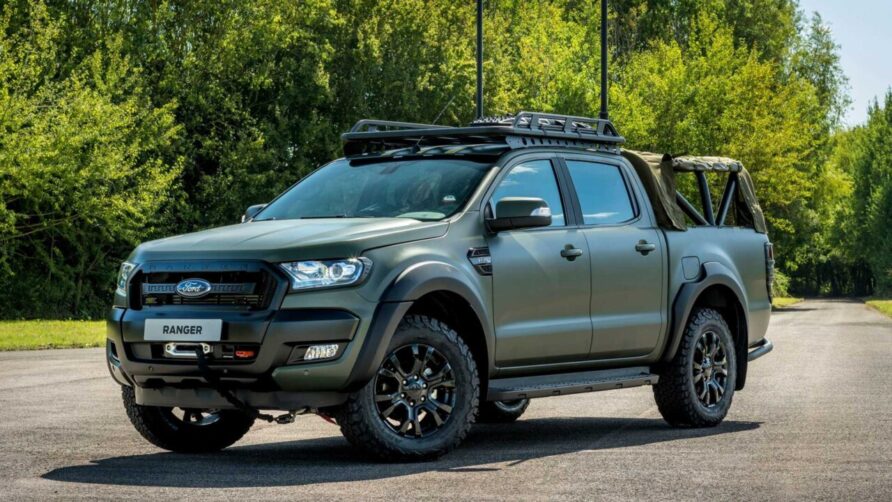
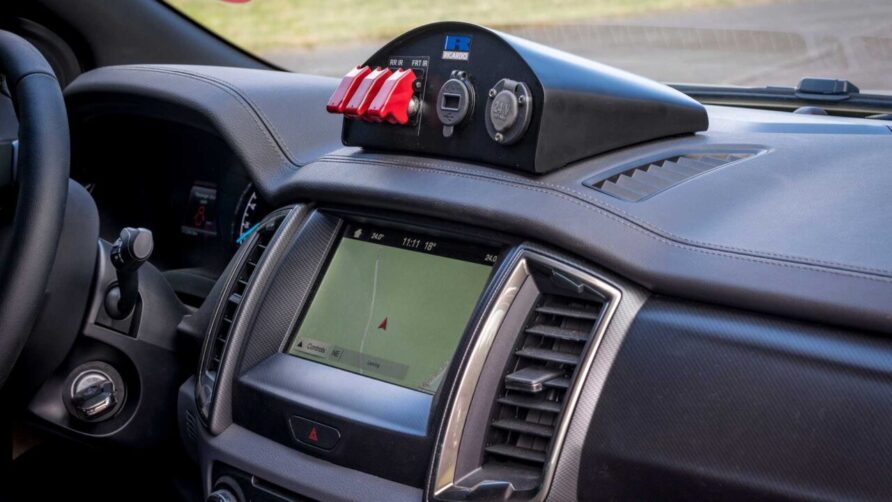
After market integrators like Ulterio Motiv in South Africa, and LTG and 6 Wheeler Conversions in Australia offer 6×4 and 6×6 conversions for the Ford Ranger. These tend to add 1.5 to2 tonnes additional payload, with a commensurate increase in GVM.
More relevant to LMV is that Ricardo has also helped develop the Ford Ranger 6×6 HEX variant.
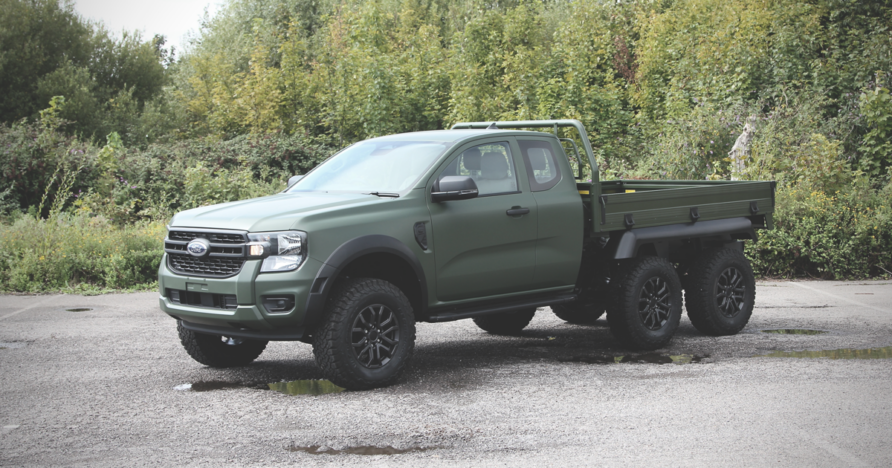
HEX not only includes a hybrid drivetrain, but its bolt on frame does not need any modification to the base chassis, not dissimilar to the Supacat Extenda.
This takes the payload up to 3.8 tonnes, and utilises a De Dion suspension system.

A more conventional mechanical drivetrain using a bogie style pivoting single leaf suspension to improve wheel articulation, ride quality and traction is also available.
Ford Global Sales also has the Ford Ranger FG-P Light Tactical Vehicle.
This is a defence optimised variant with blackout controls, an engine that can use JP-8 and a hybrid driveline.
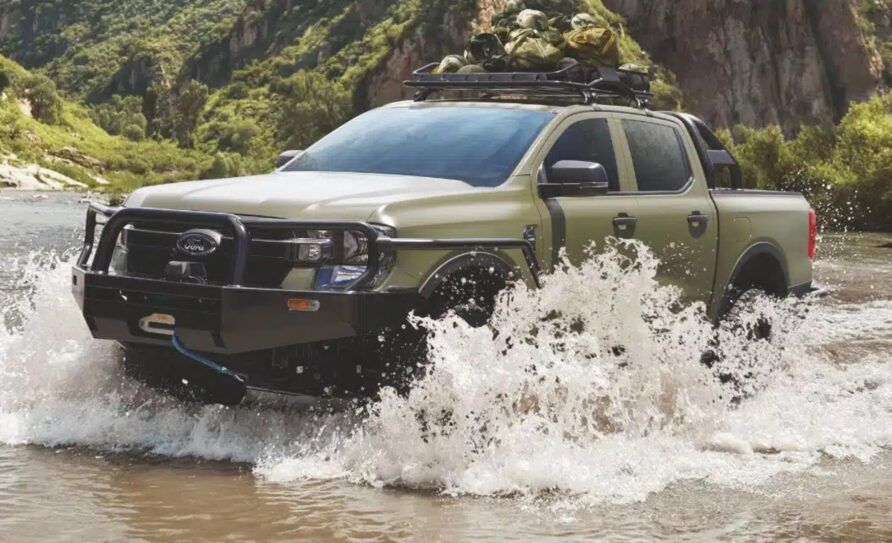
Its GVM is uprated to 3.5 tonnes, a kerb weight of 2.198 tonnes and a payload of 1.3 tonnes (37%)
Launching soon, the Ford Ranger Super Duty increases GVM to 4.5 tonnes and towing capacity to 4 tonnes.
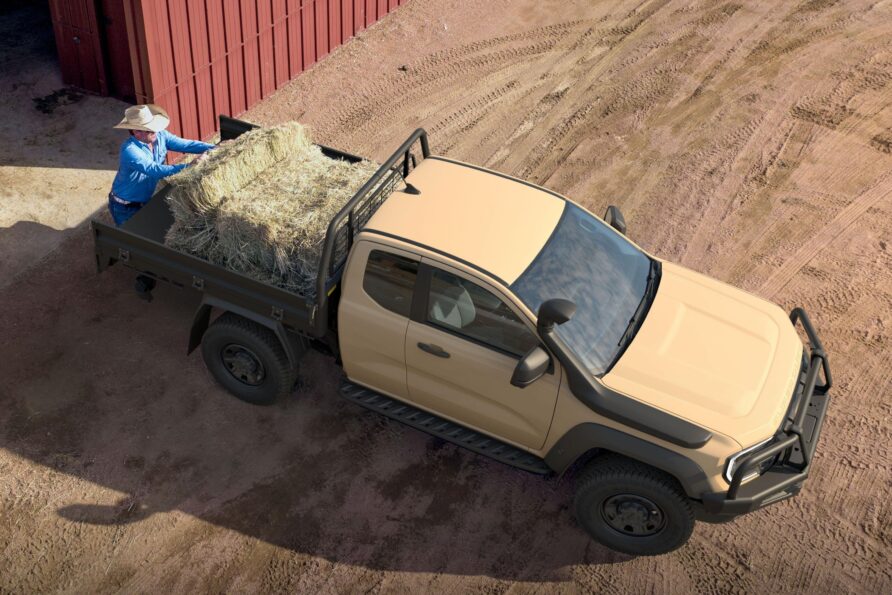
As with the Ranger, Ford Global Fleet Sales has an Everest variant for defence and security markets.
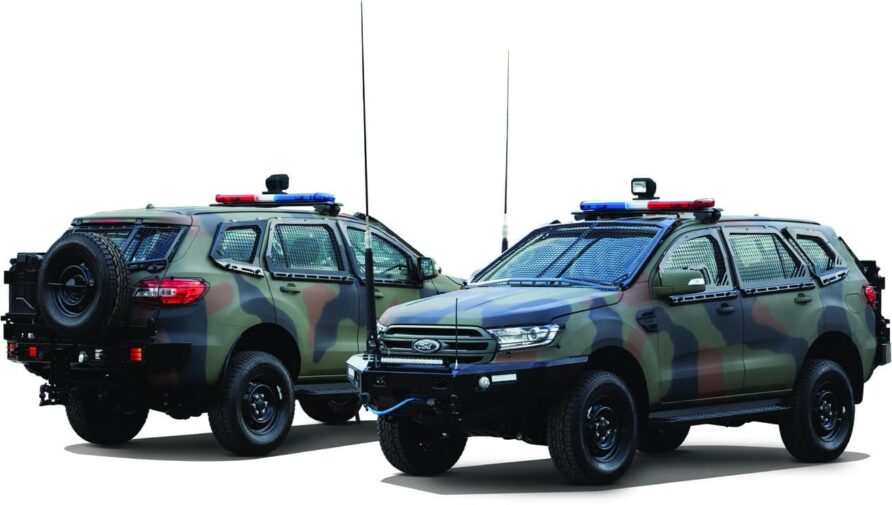
France (also via Arquus) uses the Ford Everest, called the Trapper.
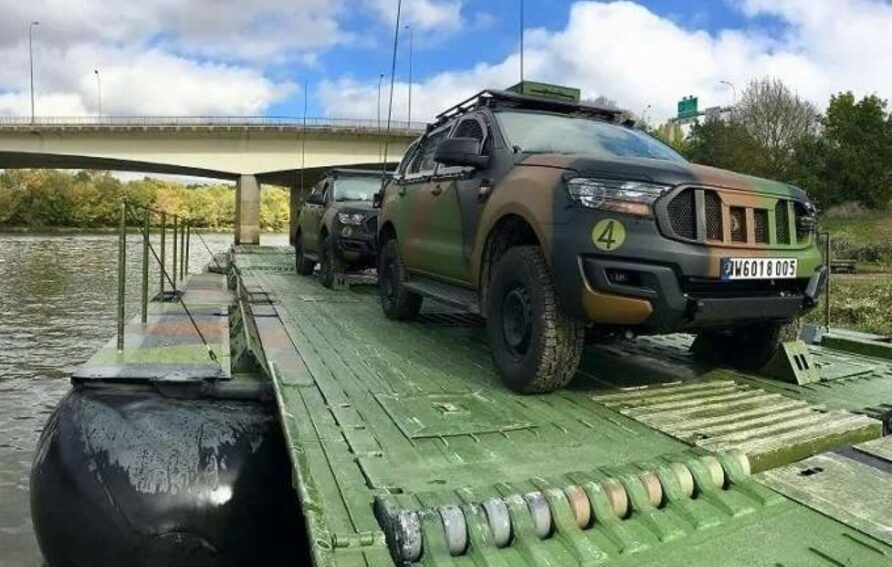
More recently, General Dynamics, Ford, and Ricardo have partnered for the Light Mobility Vehicle (LMV) requirement.
Ford Transit AWD
The AWD Transit has all-wheel drive but relatively low ground clearance, so will be useful for slushy roads and a wet farm track, but not for deep mud or serious off-road use.
It is available in a wide variety of wheelbases, engines, trim levels and cab heights.
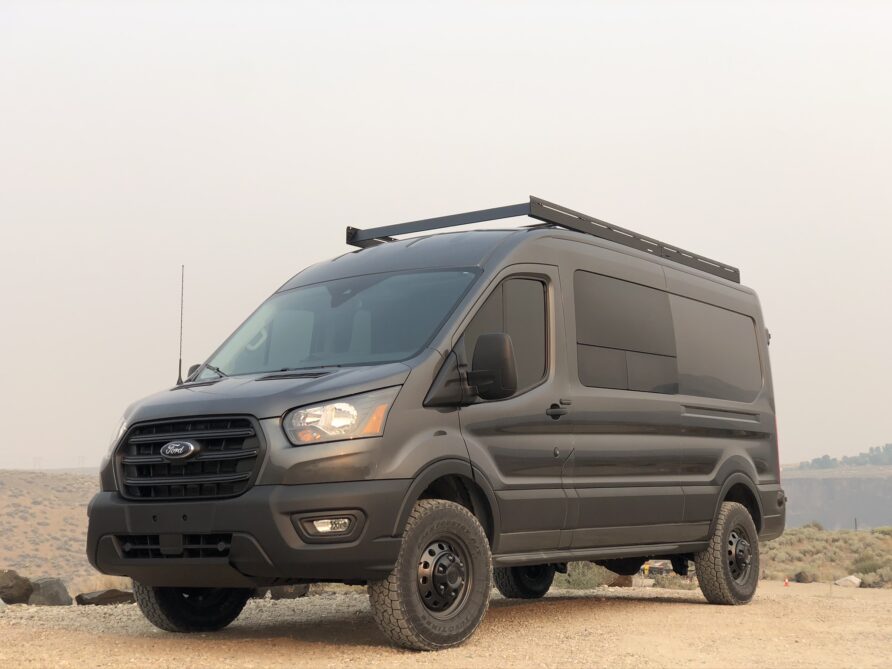
I have selected four models for comparison purposes, the Short Wheelbase 3-seat 340 Van and Long Wheelbase 6-seat 320 Van, and a long wheelbase with both a 3 seat single cab and 6 seat double cab.
Payloads are 1.04 tonnes, 1.46 tonnes, 1.31 tonnes, and 1.54 tonnes respectively (33%, 43%, 37%, and 44%).
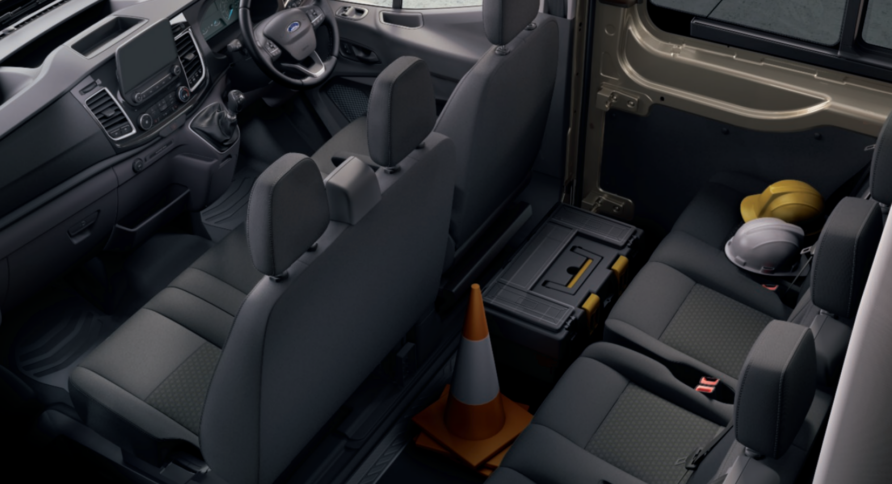
The chassis cab models can have various bodies and load beds fitted.
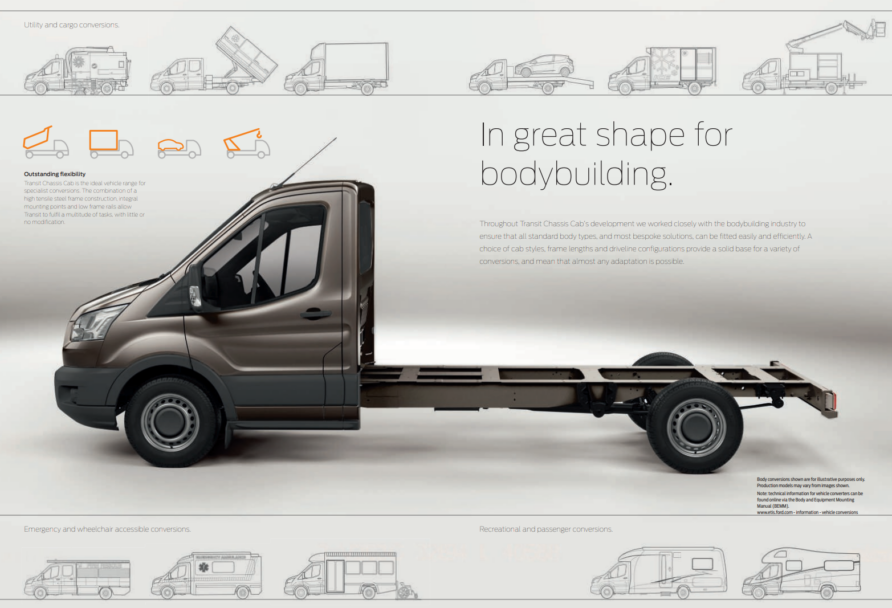
There is a large ecosystem of after market suppliers and integrators for the Ford Transit, there are over a million on the road in the UK alone (although the AWD is much less common)
The cost of ownership is extremely low, and list prices starts at approximately £45k
Ford Global Fleet Sales markets a military ambulance version.
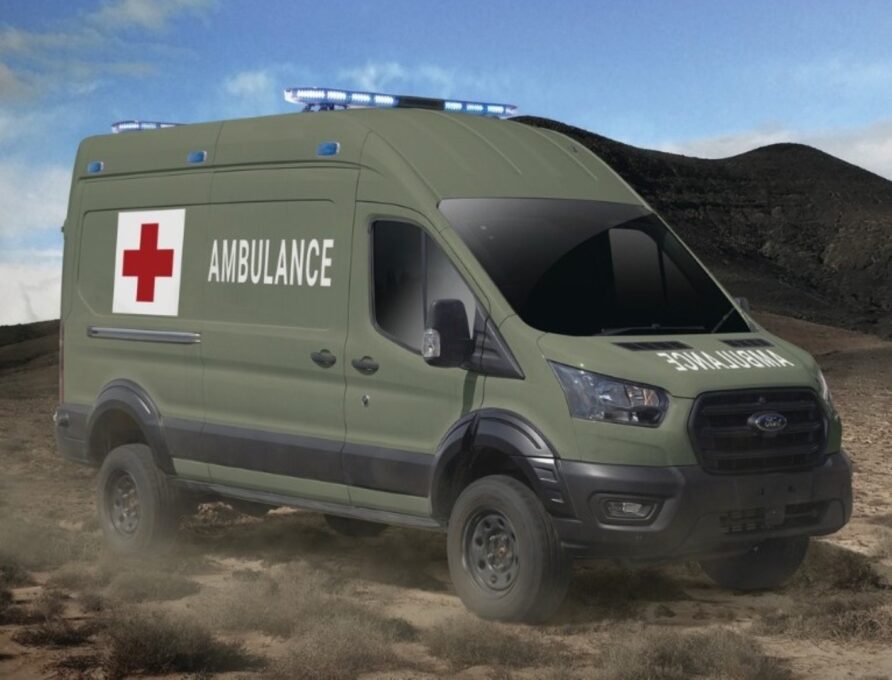
Unlike the conventional two-wheel drive Transit models, none of the AWD models can go above 3.5 tonnes GVM, so they won’t appear in the next post.
Fuso Canter
The 6.5 tonne Fuso (Mitsubishi) Canter is a 4×4 light utility truck available in left and right-hand drive, and with either a 3 seat or 7 seat cab.

Both models can tow 3.5 tonnes.
Each model is 1.95m wide, and available in two wheelbases, resulting in an overall length of 5.19m or 5.94m.
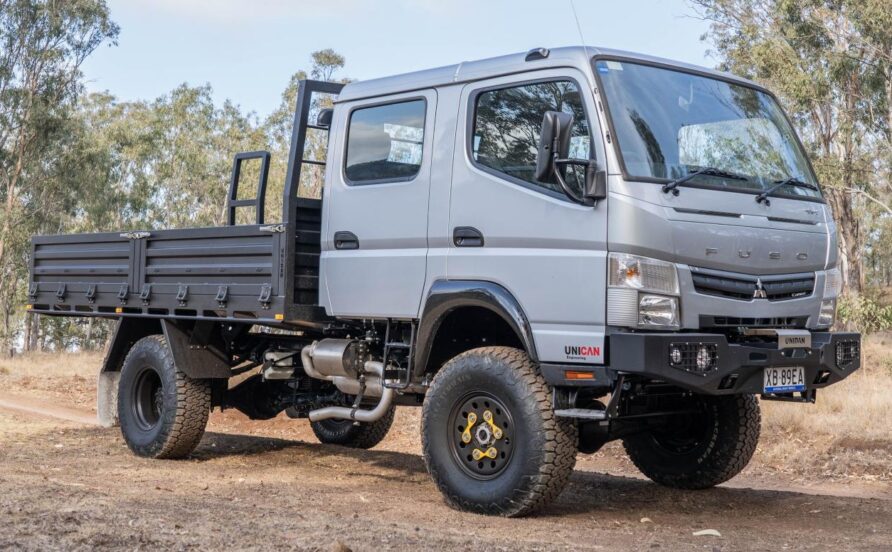
Kerb weight is between 2.85 tonnes for the long wheelbase single cab, and 3.07 tonnes for the long wheelbase double cab.
The usual range of shelters, load beds, and hydraulic equipment can be fitted.
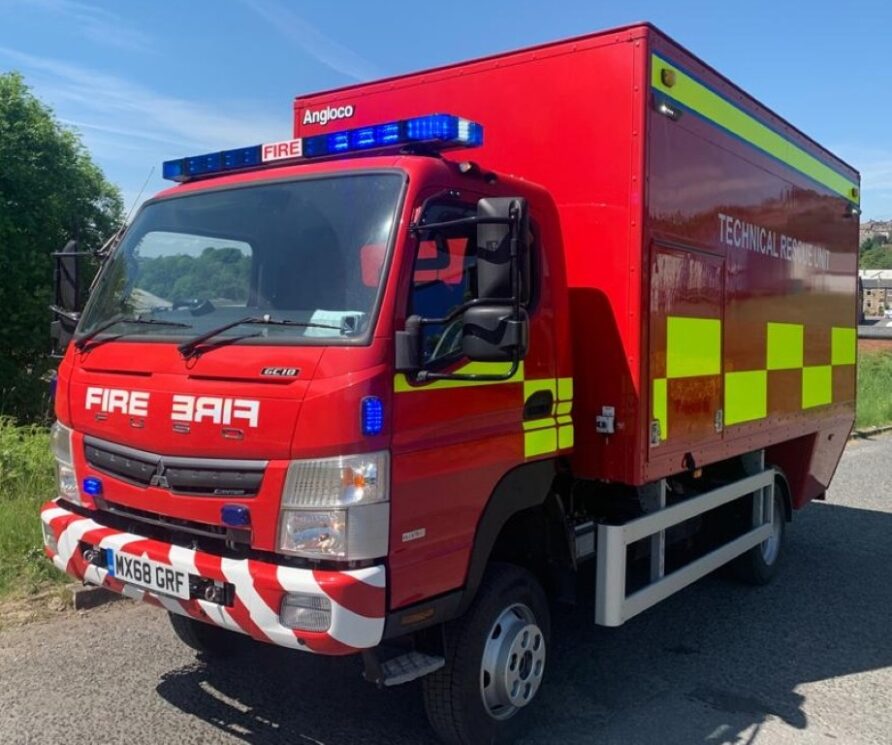
Both have a GVM of 6.5 tonnes, resulting in a payload of 3.65 tonnes and 3.43 tonnes for the single and double cab models respectively.
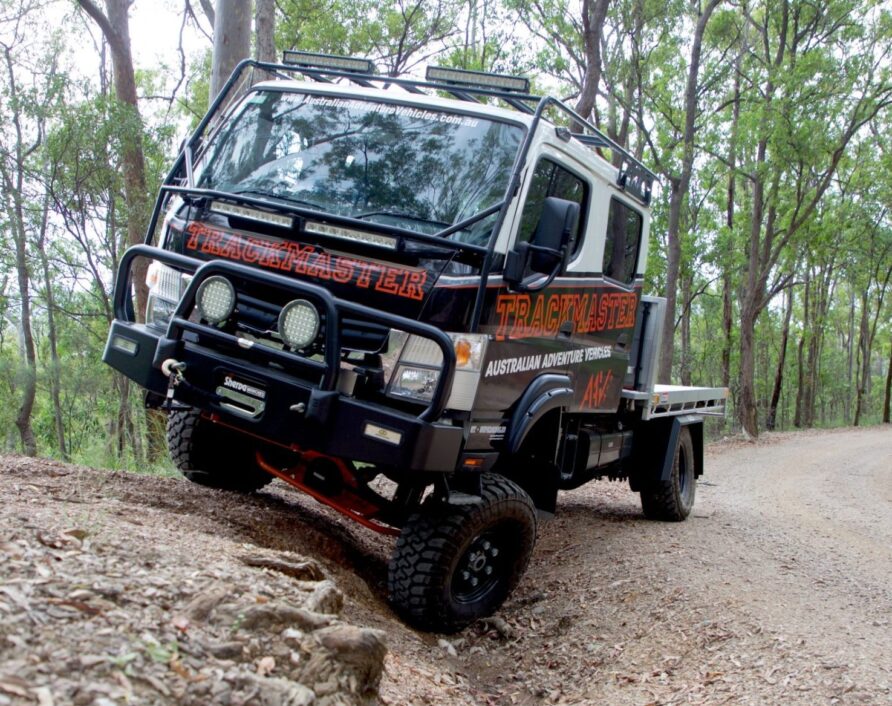
Popular in Australia, they are quite mobile.
GM Defense Colorado
The GM Defense ISV is somewhat of a specialist vehicle for rapid personnel transport, employed mostly by air mobile forces.
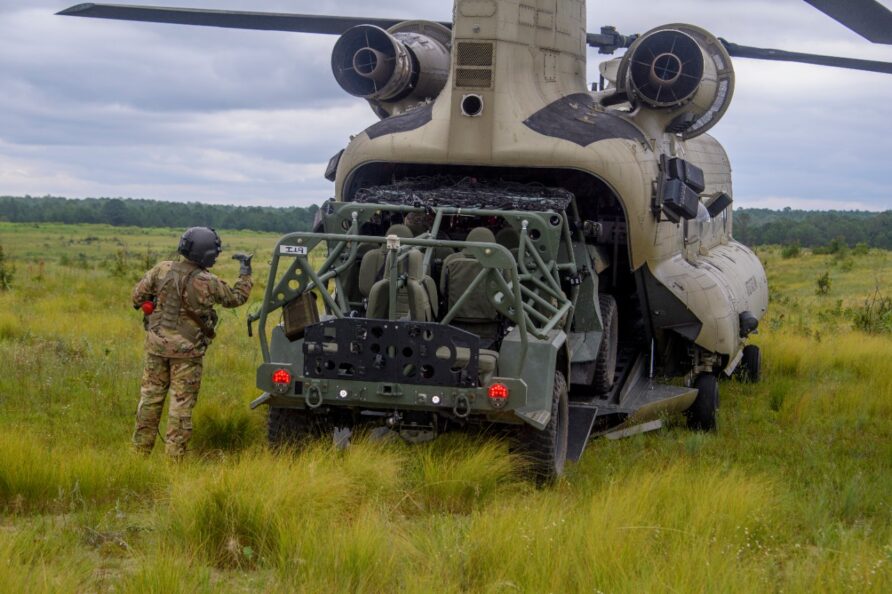
But is based on the Chevrolet Colorado ZR2.
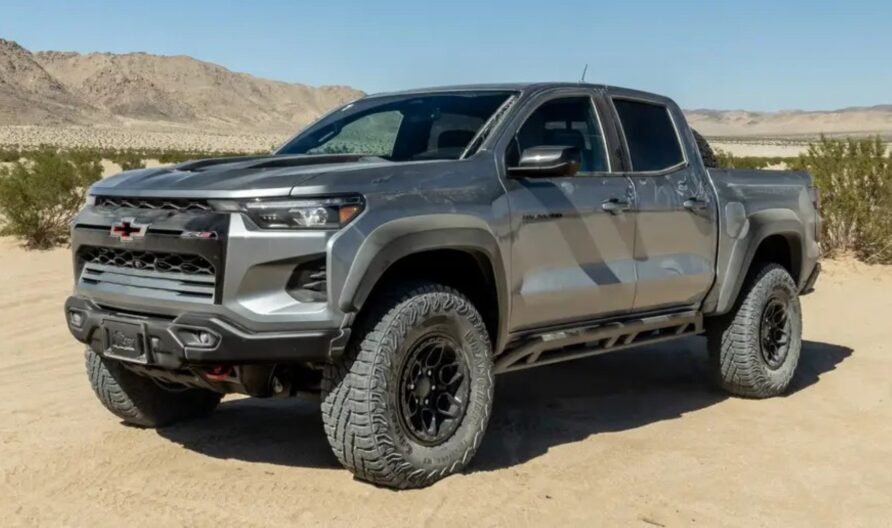
At 3.7 tonnes GVM, the ISV is slightly outside the 3.5 tonnes limit, but if limited to 3.5 tonnes, payload is 1.2 tonnes, 36%.
Other variants include the Infantry Utility Vehicle (IUV).
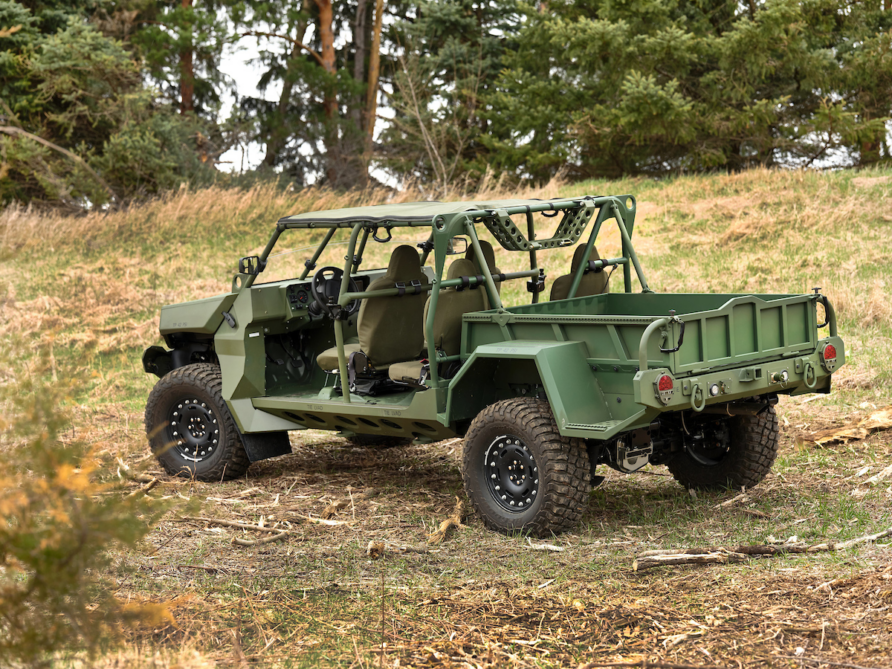
And the Infantry Cargo Vehicle (ICV), shown below with a 463L pallet on the load bed.
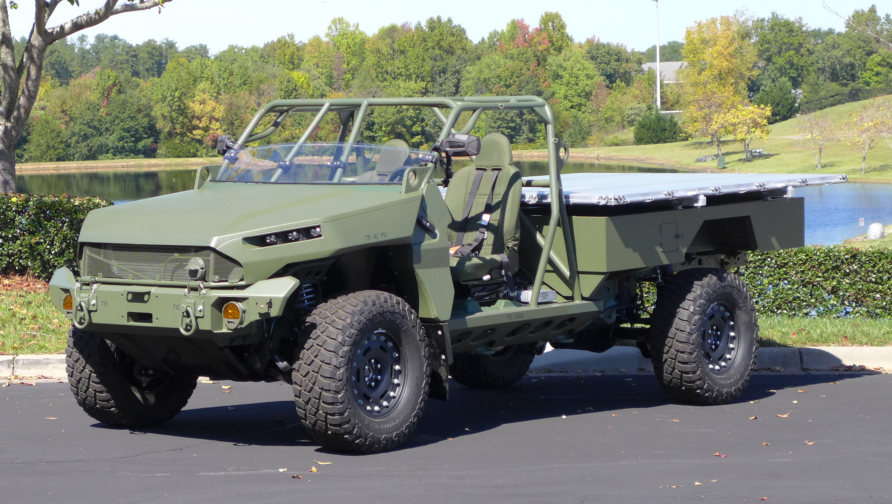
GM Defense is also marketing a military variant of the Colorado, called the Light Utility Vehicle (LUV), aimed at a Canadian Army requirement to replace G Wagons and other Chevrolet vehicles. Although the competition still appears to be open, a Phase 1 Light Tactical Vehicle contract has been placed with GM Defense, mostly for use as parts of the Canadian contingent in the Baltic States.
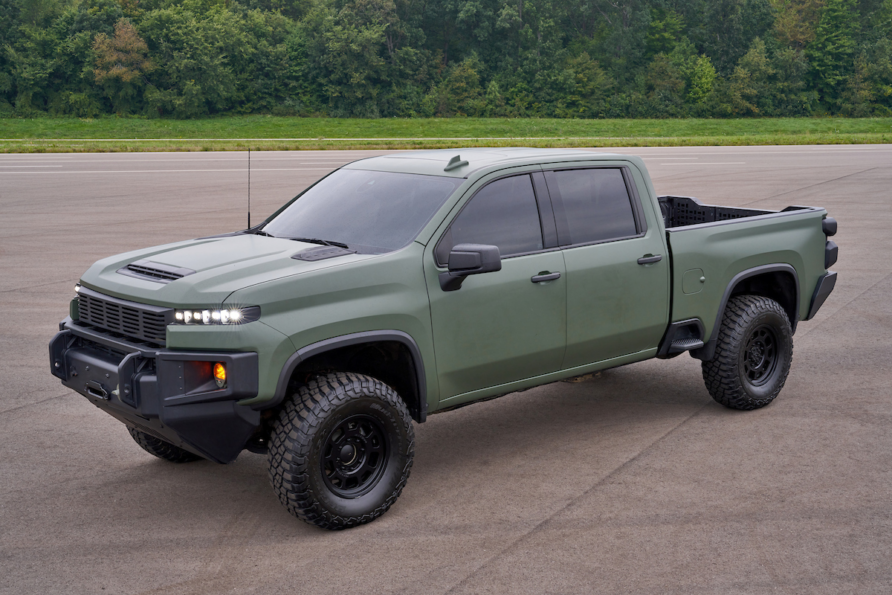
I have included this vehicle in the <3.5 tonne category because although no weights are provided on the manufacturers’ website, indications are that its kerb wight is less than 3.5 tonnes, even though gross vehicle mass is likely to be higher.
Hako M31 Multicar
The KMW Mungo ESK variant has a maximum weight of 5.9 tonnes and can carry 10 personnel and their equipment to a total distance of 500 km with a top speed of 90kph.
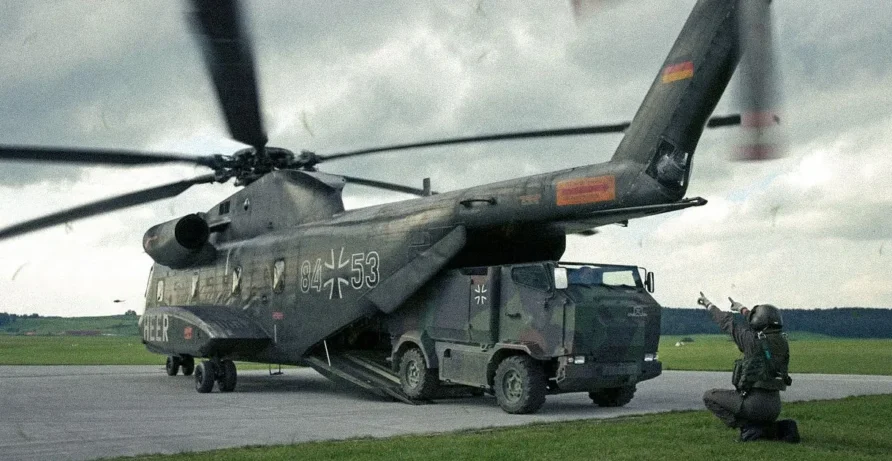
Designed for carrying cargo, the Multi-Purpose Vehicle has a payload of 1.5 tonnes and uses a skip loader rather than a hook lift to reduce height.
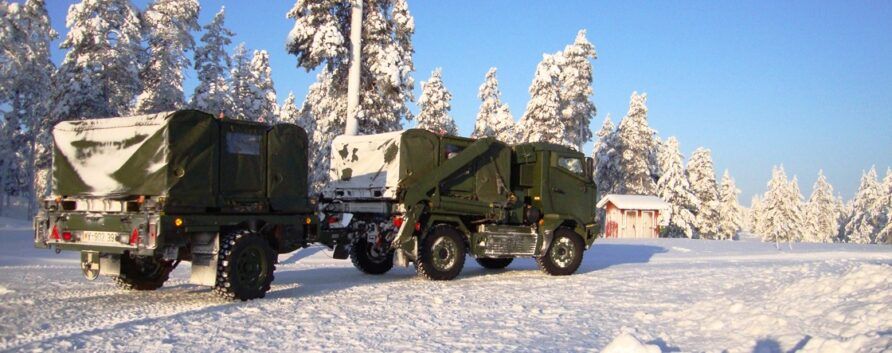
It is based on the Multicar M30 municipal maintenance vehicle.
The slightly larger Hako M31B Multicar has a top speed of 90kph and a three-way tipping load bed with a 3,000 kg payload capacity, it can also tow a braked trailer up to 3,500 kg.
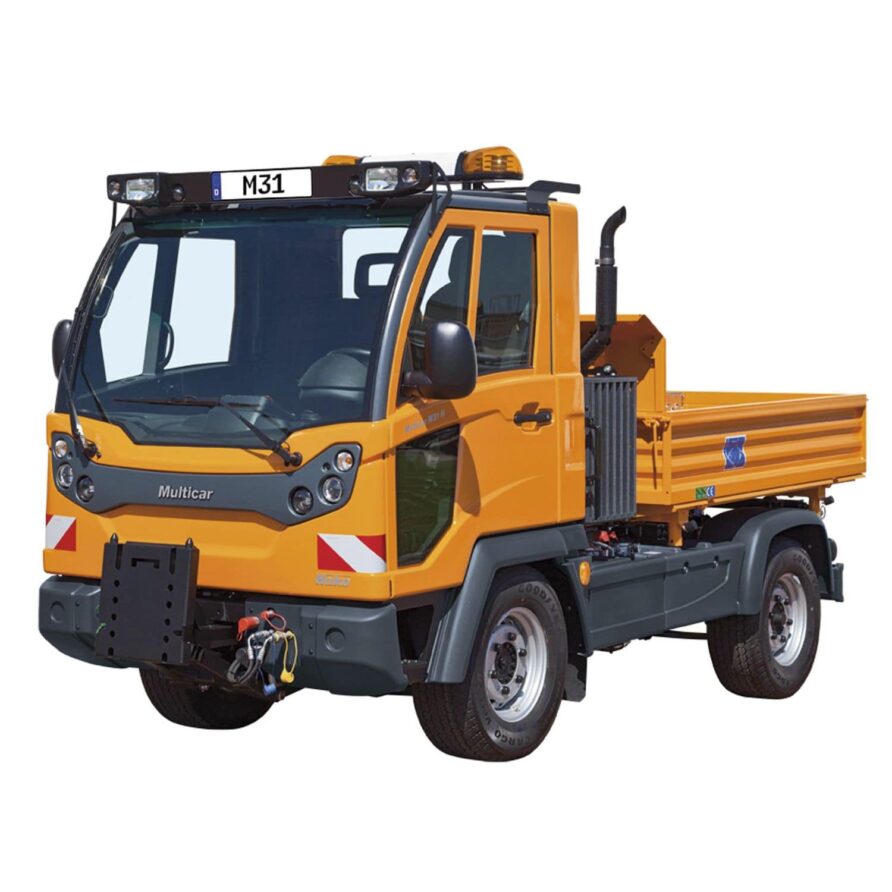
Gross Vehicle Mass (GVM) is 5.6 tonnes.
Ineos Grenadier
Conceived by the owner of the chemical company INEOS, the Grenadier is designed to be a real Land Rover successor.
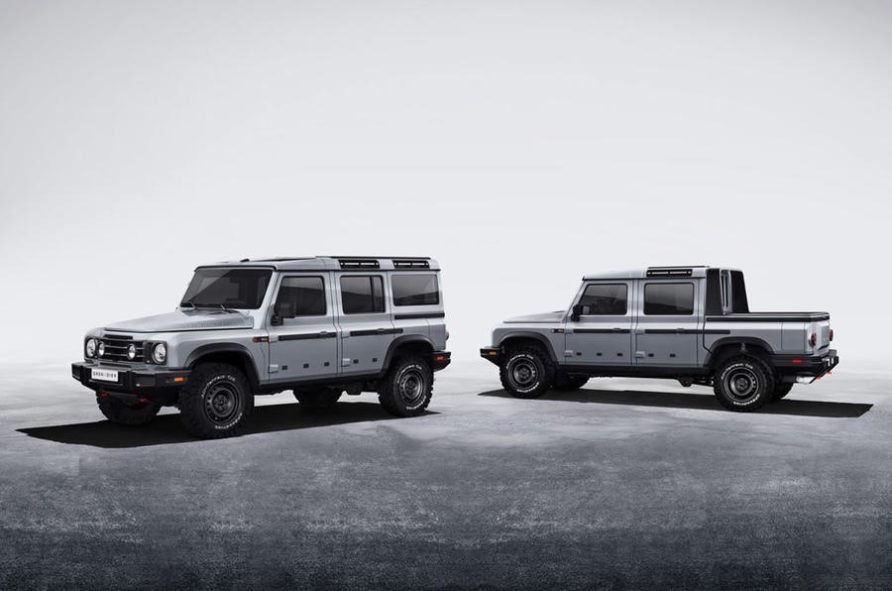
Available in four models.

Supply chain issues aside, the Grenadier is a credible off-road vehicle but despite the 3.5 tonne GVM, the payload is about 760 kg for the diesel engine variants.
This is a rather miserly 22%.
Inkas in Canada have created an armoured Grenadier, but although weights are not published, they are unlikely to be below 3.5 tonnes.
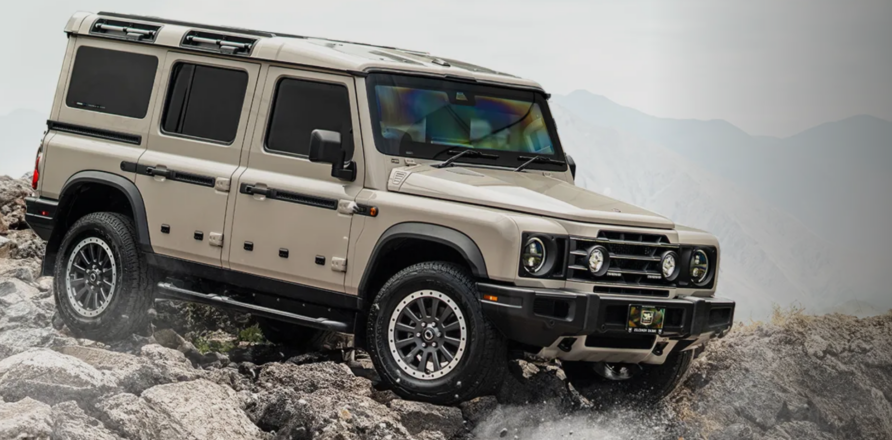
Isuzu D Max
One of the most reliable pickup trucks on the market is the Isuzu D-Max, and this has been demonstrated by its increasing success with large fleet buyers.
e.g., the RAC

Each will be equipped with an innovative All-Wheels-Up recovery system.
D Max vehicles are in service with Ukraine (where they have recently announced local assembly), and the defence forces of the Philippines, Thailand, Malaysia, Malta, India, and Bangladesh.
The Singaporean Army Agilas Light Utility Vehicle (LUV) is shown below.
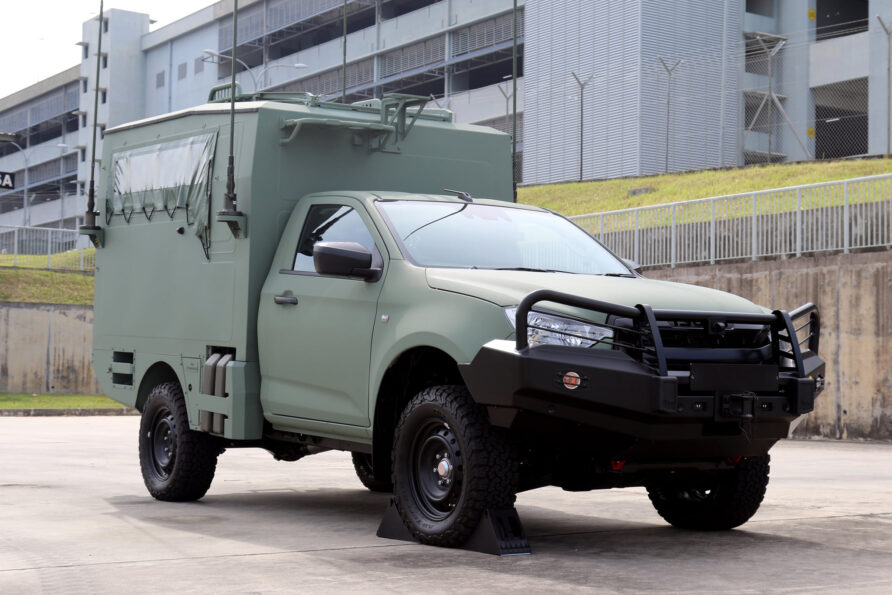
In the FFR command role.
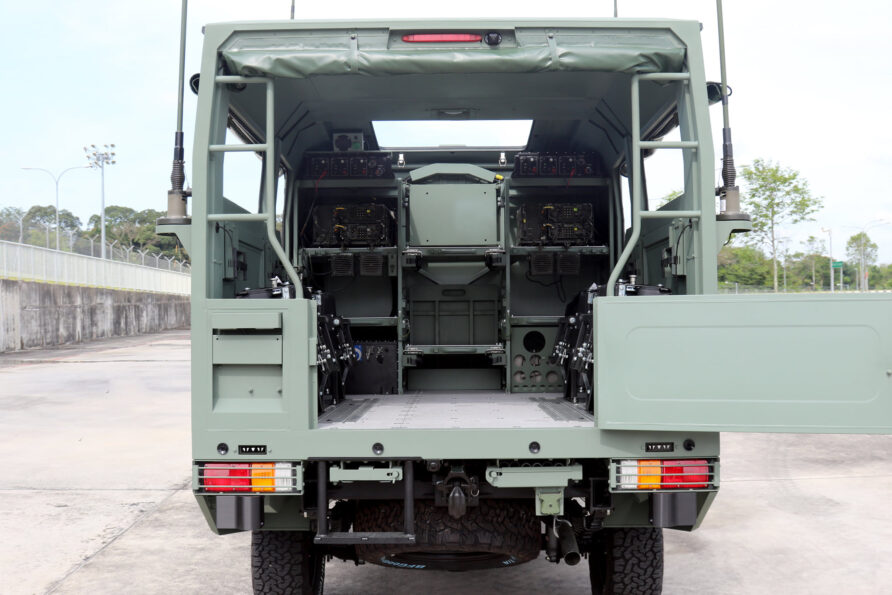
The RAF use the D Max for Mountain Rescue.
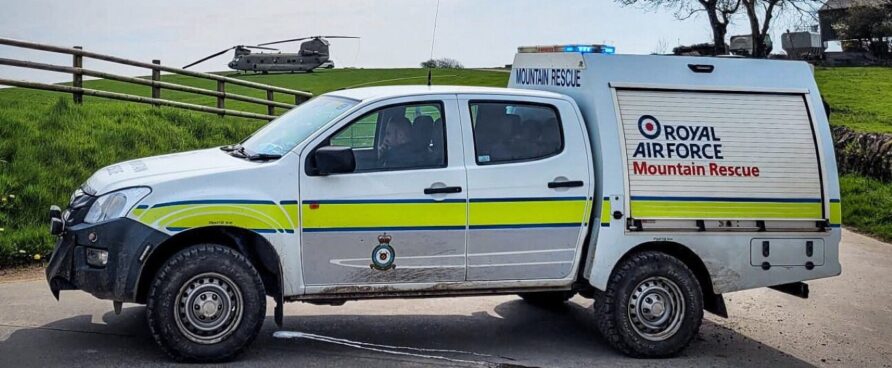
The double cab DL40 model has a GVM of 3.2 tonnes, kerb weight of 1.995 tonnes, and payload of 1.2 tonnes (38%)
Although not available in the UK, Isuzu have recently released a new vehicle based on the D Max called the Traviz, but it is only two-wheel drive.
Iveco Daily 4×4
The Iveco Daily 4×4 is available in All Road and Off Road models, with differing wheelbases, GVM’s and cab configurations.
The latter includes van, chassis, crew cab, and double cab.
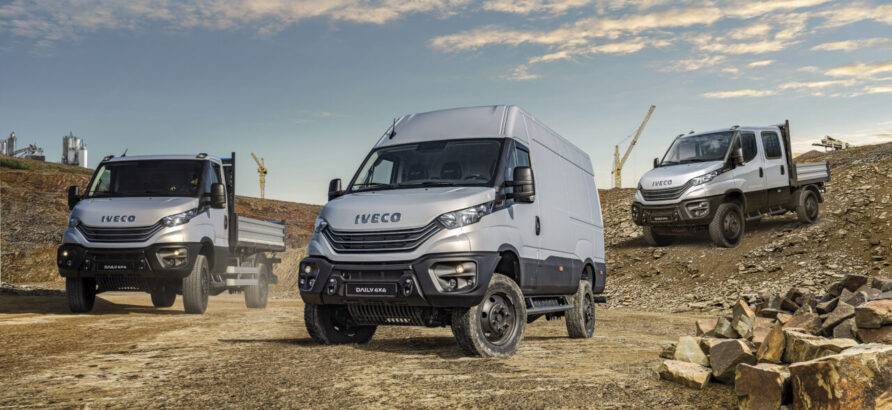
The long wheelbase 5.5 tonnes GVM single cab has a payload of 2.6 tonnes (48%) and the 7 tonne GVM model, 4 tonnes (57%)
The double cab reduces payload, to approximately 3.6 tonnes in the 7 tonne GVM model.
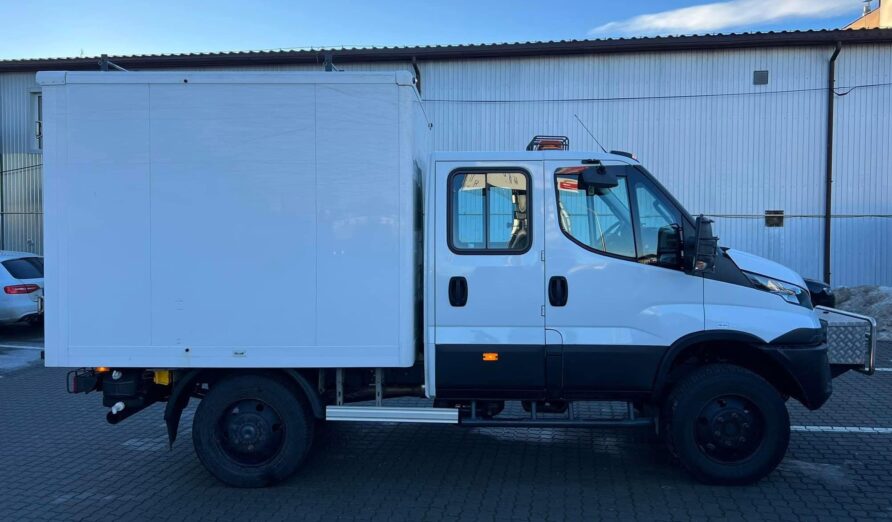
A 6×6 version is also available.
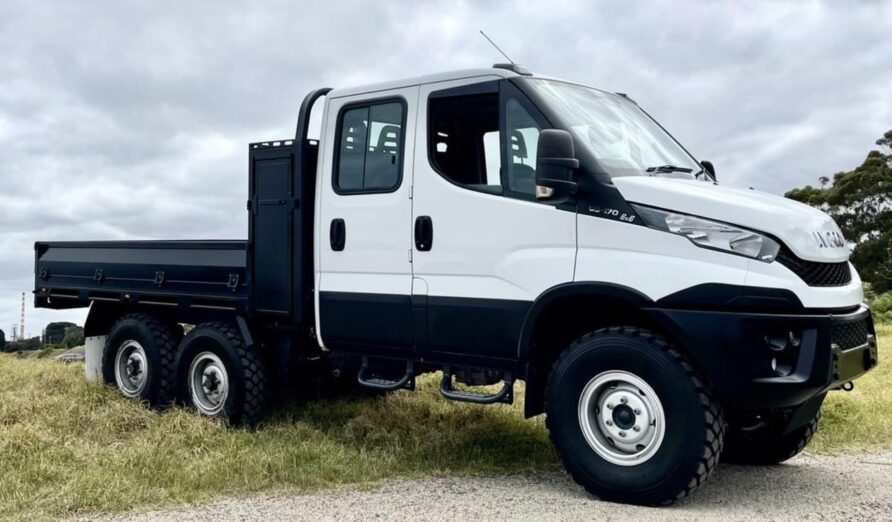
Derived from the Daily 4×4, the Military Utility Vehicle (MUV) is available in several cab configurations and even a minibus, but most of these are over 3.5 tonnes.
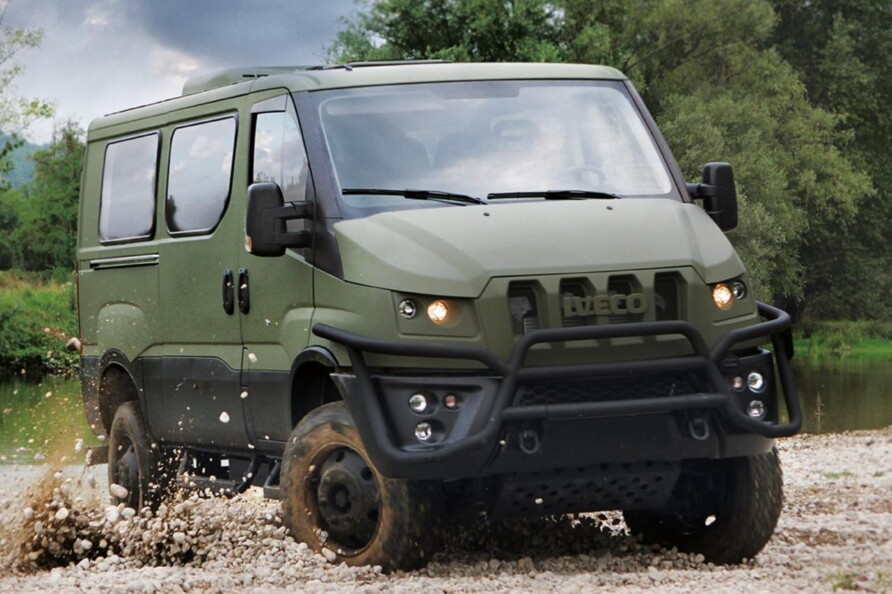
Van, single (chassis) and crew (double) cab models, shown below.
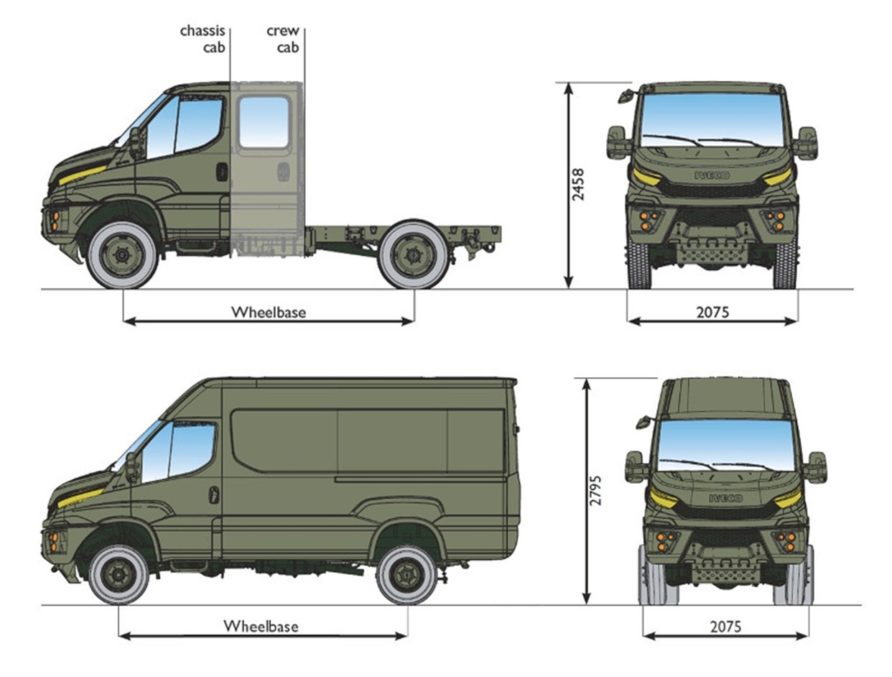
Like the civilian versions, they are also available in 5.5 and 7 tonne GVM, with similar payloads.
The vehicles all have blackout lighting, NATO standard towing facilities, night vision-compatible instruments and other military features.
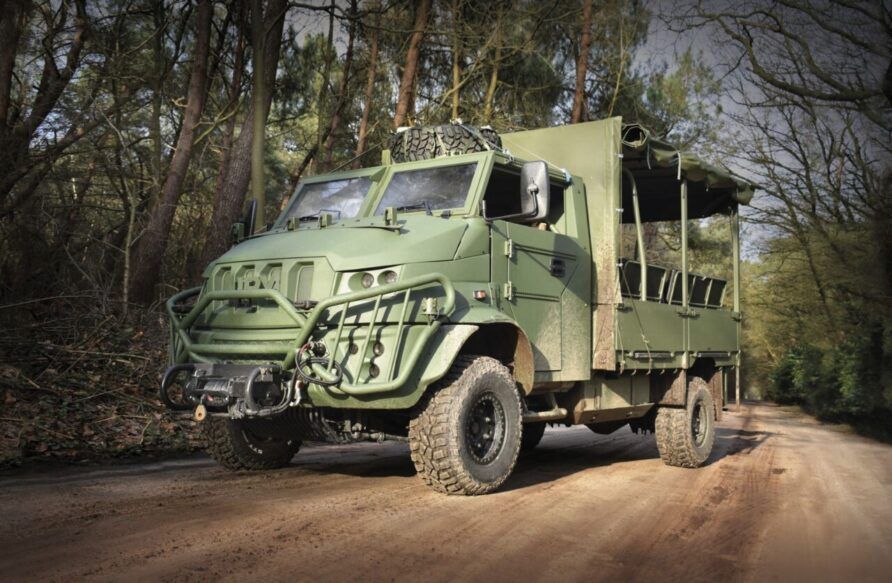
A Special Forces variant completes the mix.
The Dutch company DMV also uses the Iveco Daily platform,
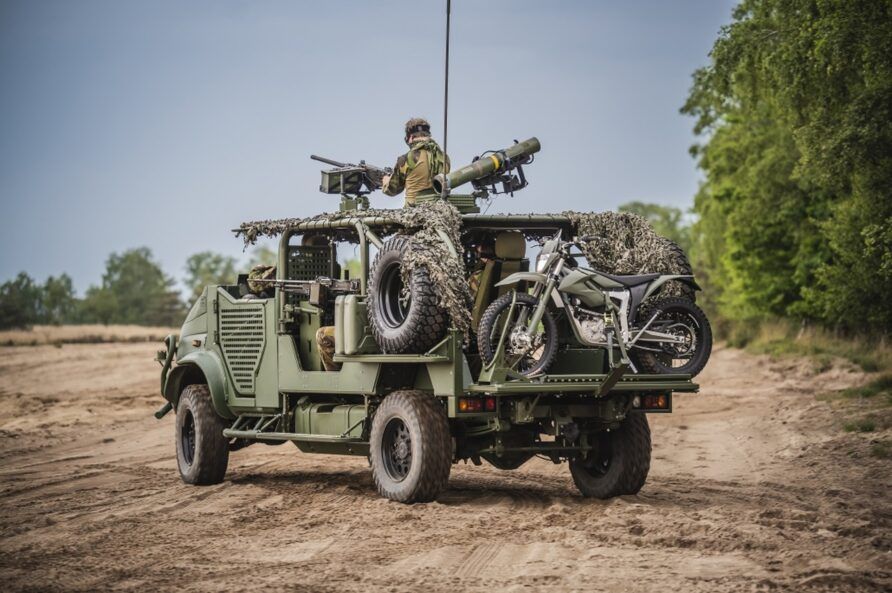
The latest version being the Anaconda, entering service with the Royal Netherlands Korps Mariniers.
Sweden recently ordered four hundred Iveco Daily 4×4 in troop transport, medical, and cargo variants, total contract value of approximately £62 million, £155k each.
Ambulance variant, shown below.
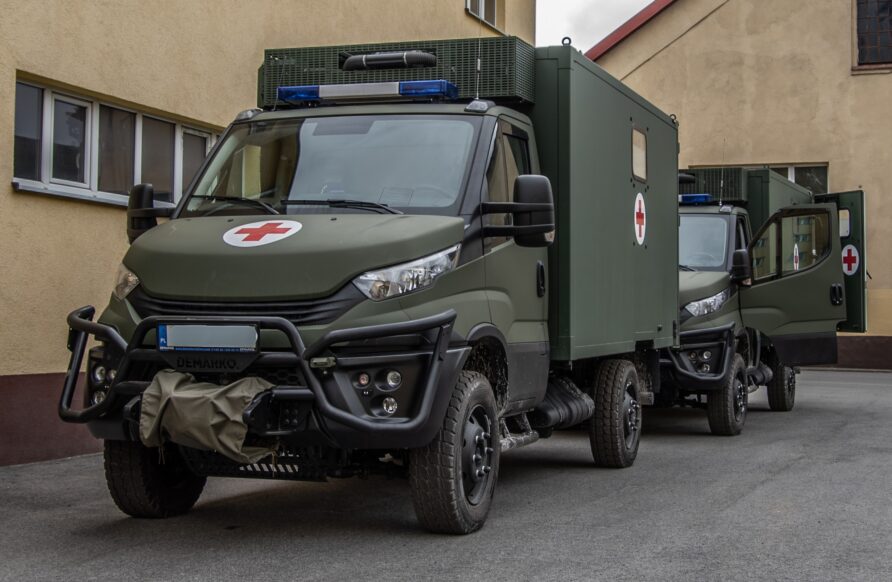
In service with the Polish Army.
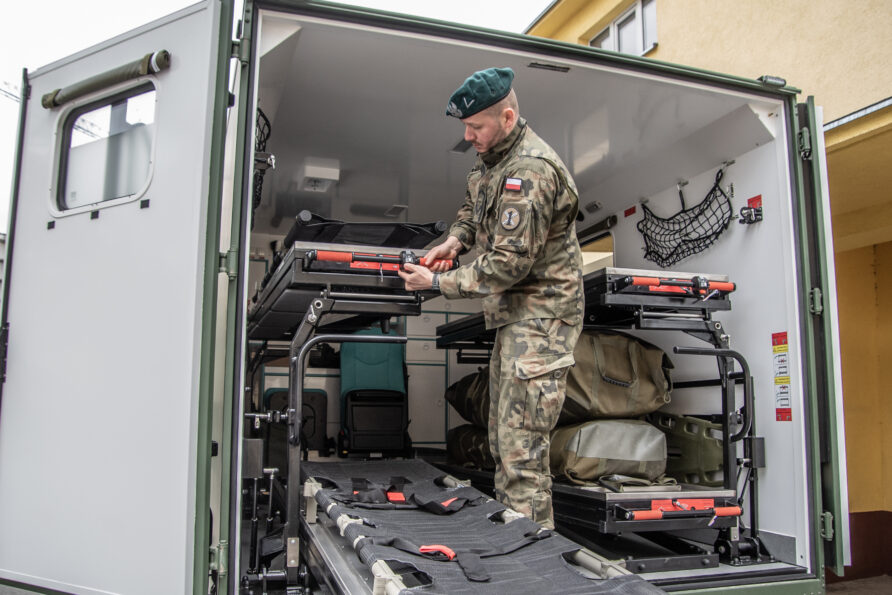
Austria has also ordered just under 200 MUV’s to replace the Pinzgauer.
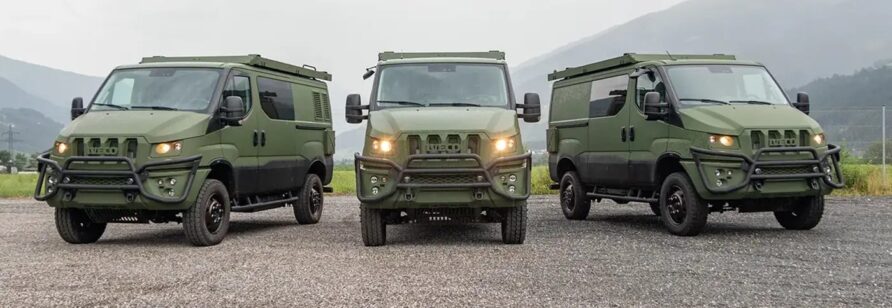
Jeep Wrangler
Supacat partnered with Jeep for the GSUP requirement after previous attempts to offer a Land Rover Discovery-based Light Role Vehicle, but Supacat has now moved on to another platform for LMV.
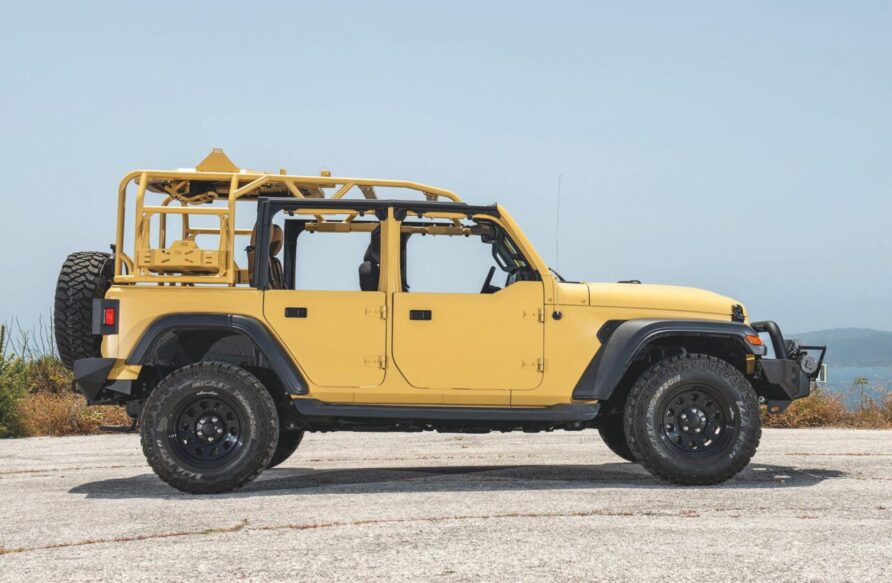
The J8 is 4850 mm (L) x 1877 mm (W) x 1995 mm (H), Weighs (GVW) 3200 kg and has a payload of 1000 kg (32%) and towing weight (braked) of 2495 kg.
Based on the Jeep Wrangler JK platform, it is assembled in Gibraltar by AADS
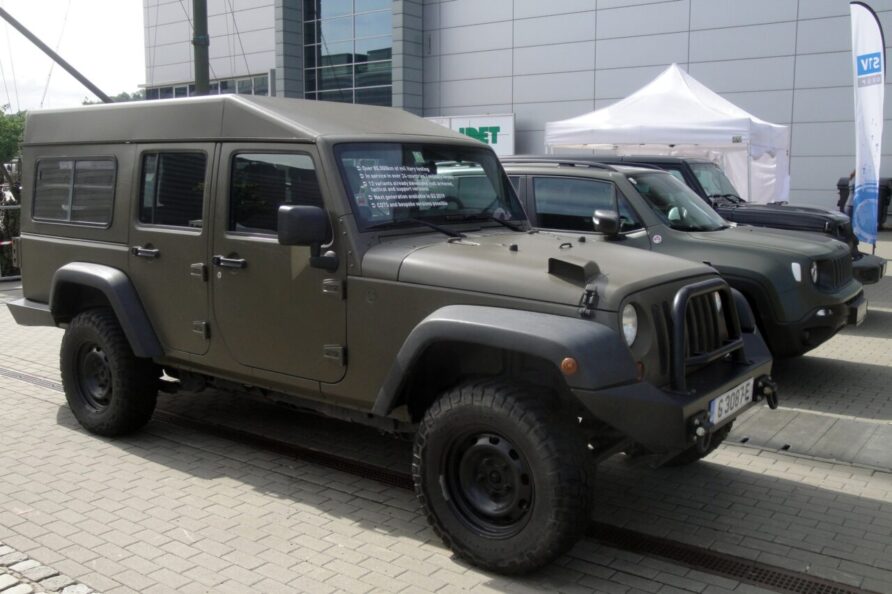
Available in six variants, including ambulance and armoured.
Lidner Unitrac 72
The Lidner Unitrac 72 is another agricultural load and municipal tool carrier that would be useful as the Utility Vehicle.
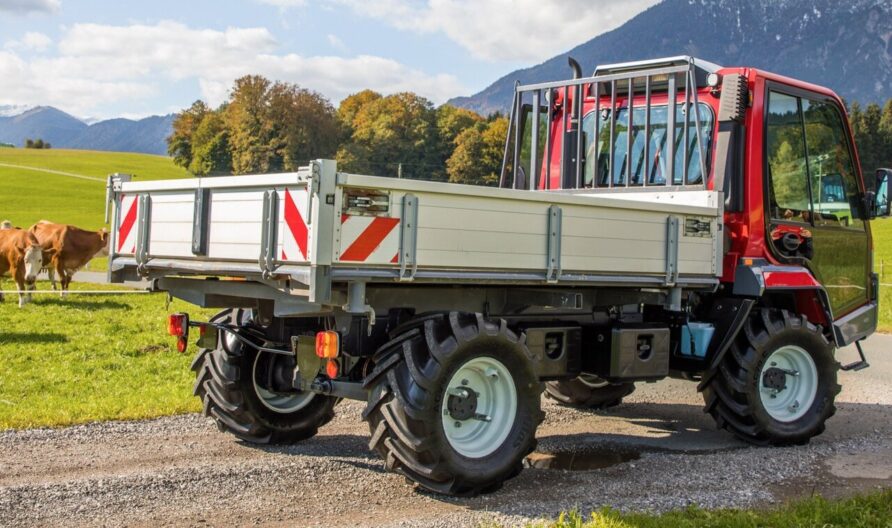
With a kerb weight of 3.35 tonnes and a GVM of 7 tonnes, it has a payload of 3.65 tonnes (52%)
MAN TGE 4×4
The MAN TGE 4×4 is similar to other 4×4 vans in this post.
The AWD system provides additional traction but limited ground clearance.
For higher GVMs, Obereaigner and Torsus take the standard vehicle and enhance mobility and payload.
The Torsus Terrastorm is a good example, with suspension from JRZ in the Netherlands.
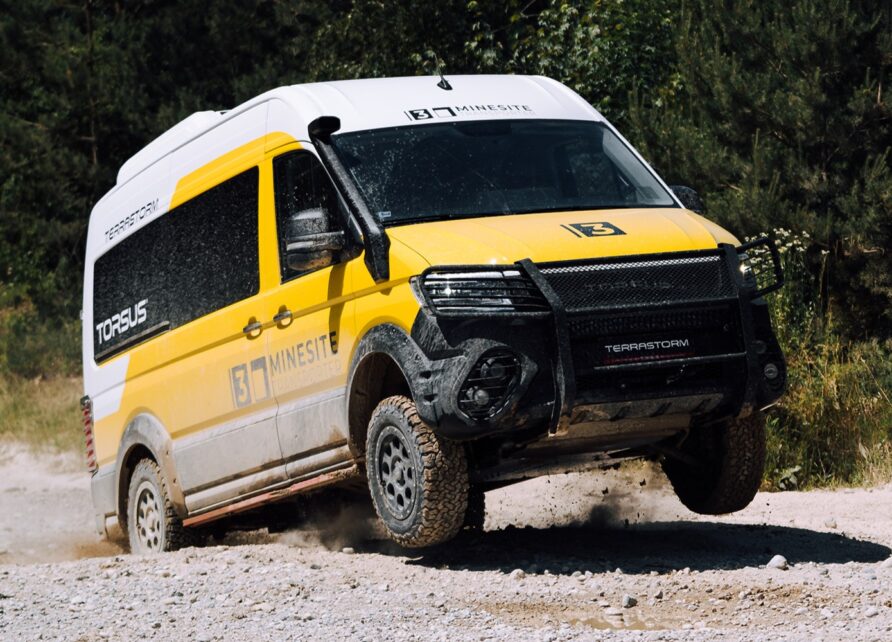
The basic cargo van version has a maximum GVM of 3.5 tonnes, and kerb weight of 2.3 tonnes, leaving a payload of 1.2 tonnes (34%)
They also have an ambulance and chassis cab version.
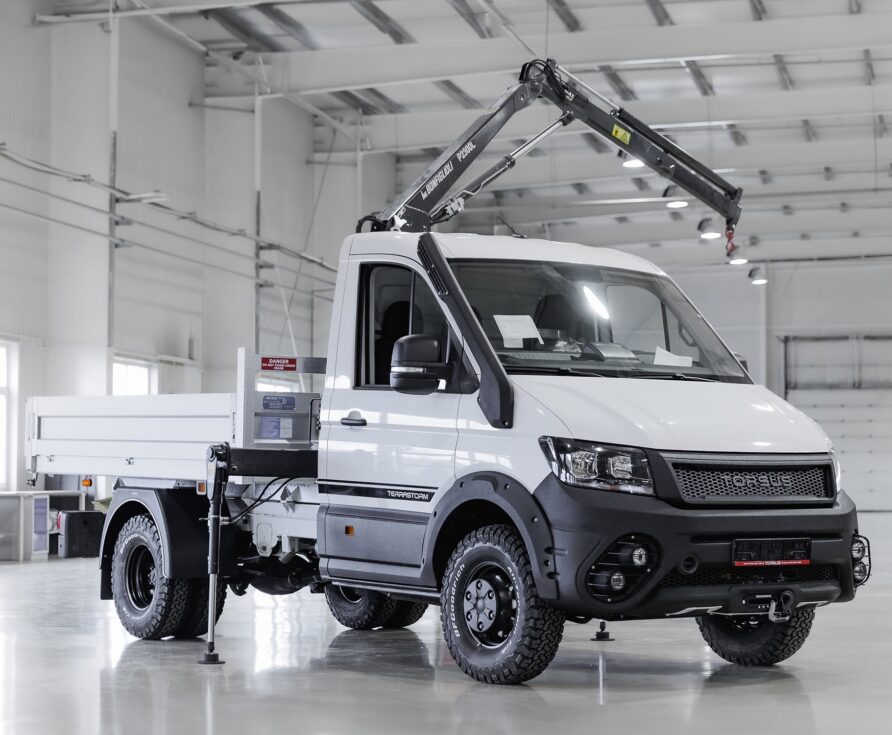
The higher weight version has a GVM of 5 tonnes, and a payload of 2.7 tonnes (54%).
MAN, Torsus, and Rheinmetall have recently partnered to create a military version of the Terrastorm, with a 6 seat double cab.
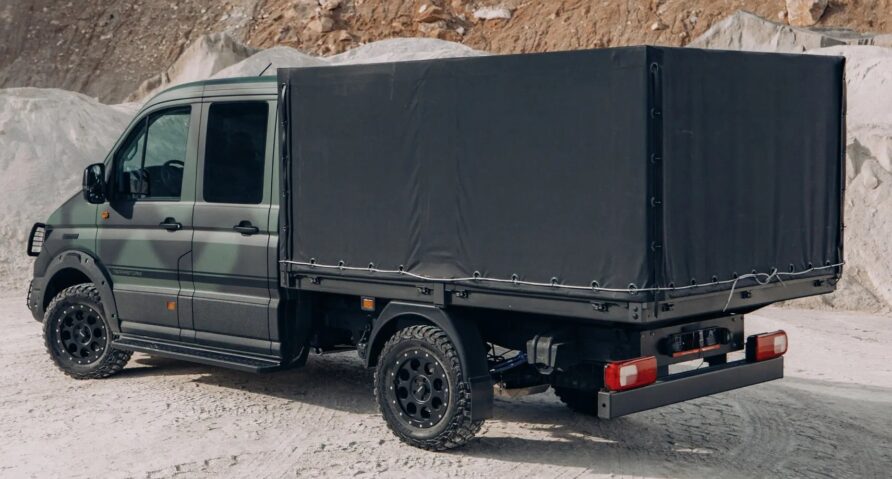
Various payloads can be fitted to the rear load bed.
Mercedes-Benz G Class
The G Class for Rescue and Special Operations is available in two variants, a station wagon and a two-door Chassis cab.
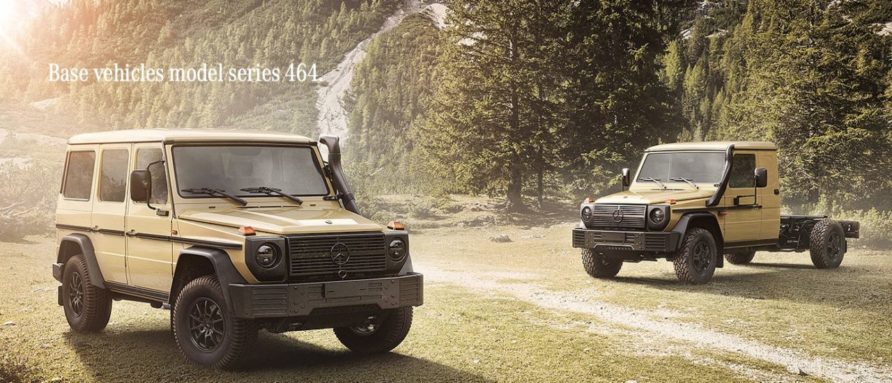
Both Models are designated as G350d with a 249bhp 600 Nm diesel engine (also known as the series 464)
The station wagon designated has a maximum authorised mass of 3500 kg, kerb weight of 2.5 tonnes, and a payload of 1 tonne (29%)
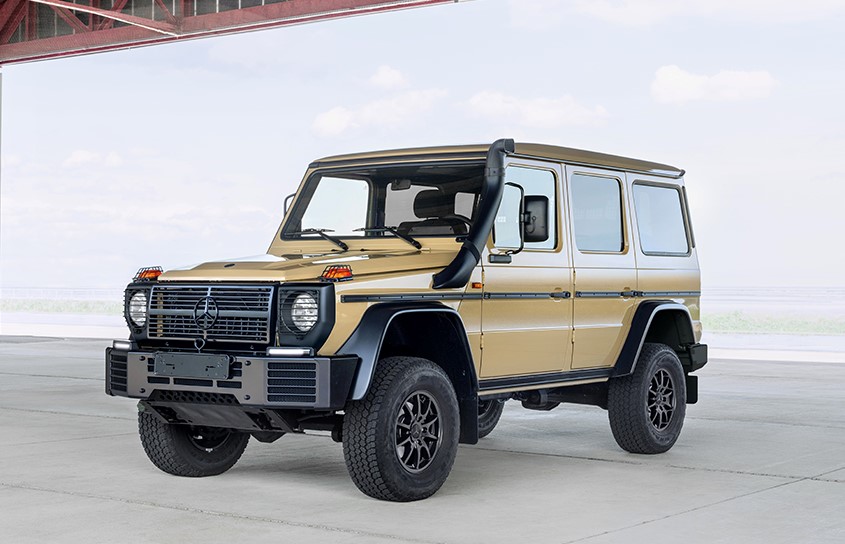
The Chassis cab is designated as the BA09, with a stretched wheelbase of 3650 mm. The gross vehicle mass is increased to 4.9 tonnes with a payload of 2.5 tonnes (51%)
Load bed trays and other equipment are included in this payload figure.
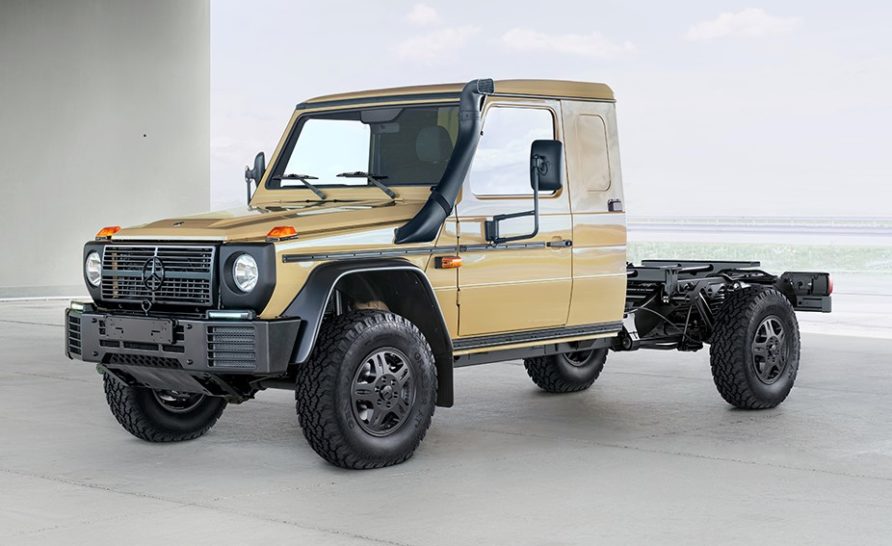
The two seat chassis cab variant has an enlarged passenger cab, with more space for the occupants and storage for equipment.
Both vehicles have a towing capacity of 3500 kg.
Mercedes-Benz has demonstrated a troop carrying variant.
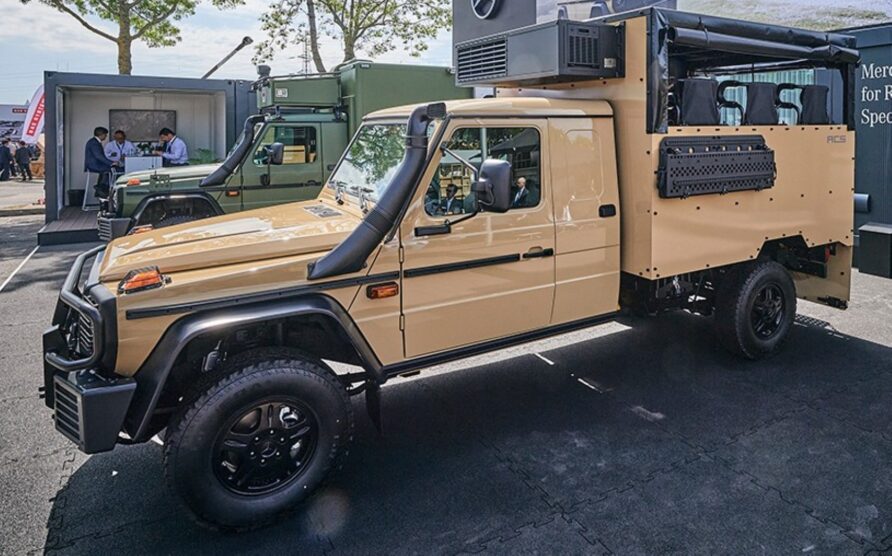
And an ambulance variant.
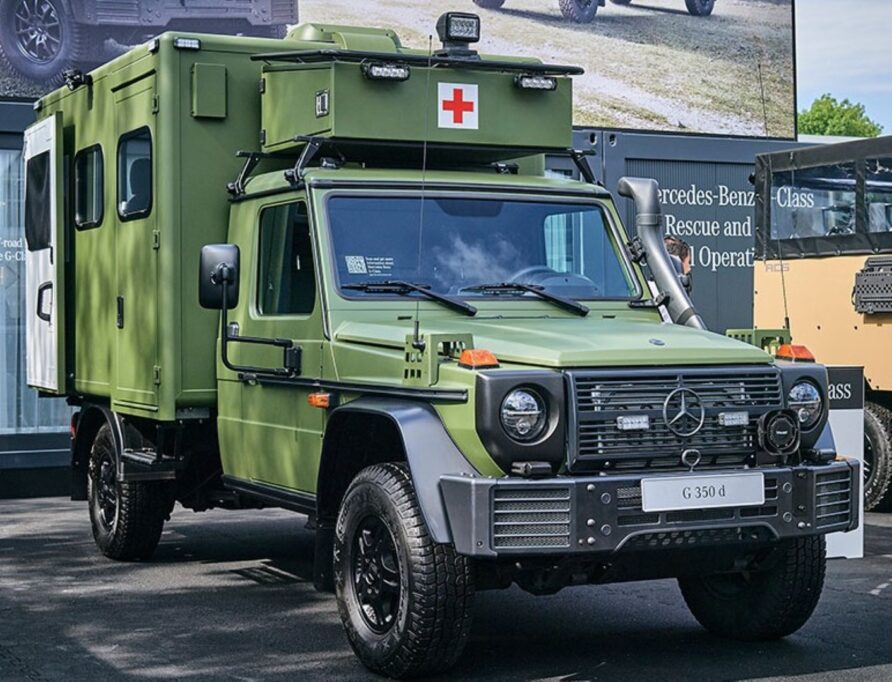
The image below shows a Rheinmetall Caracal, based on the G-Class 464 series chassis. Germany and the Netherlands have ordered the Caracal, the contact was for just over three thousand vehicles at 1.9 Billion Euros, approximately £530k each (accepting programme costs divided by quantity is not always a reliable indicator of unit cost)
Delivery will commence in 2025.
Ukraine also has a small number in service.
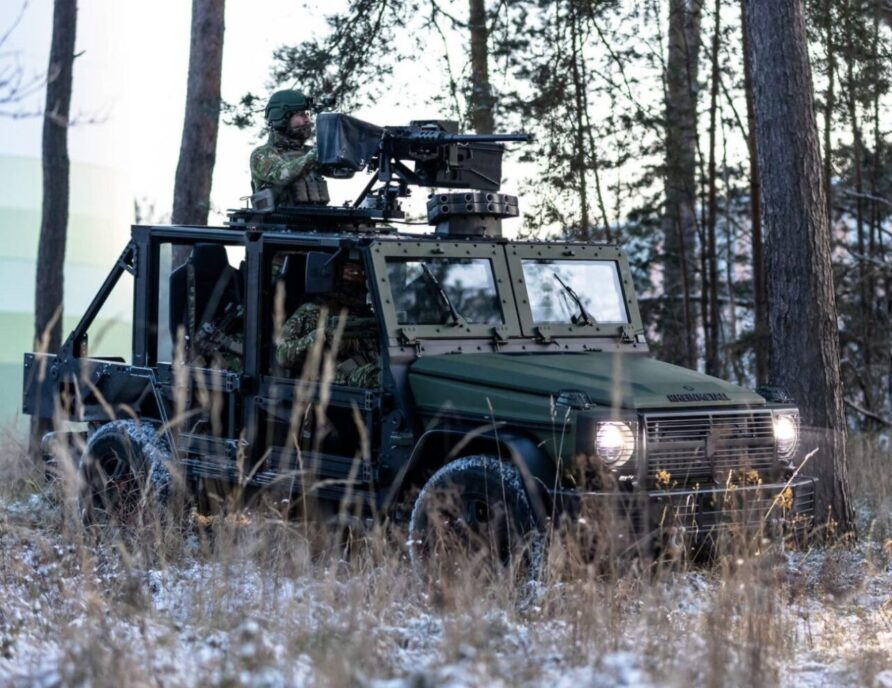
Plasan has also demonstrated a protected variant.
The W464 series is not available in right-hand drive
Mercedes-Benz Sprinter AWD
The Sprinter AWD is an enhanced mobility version of the standard chassis cab and van.
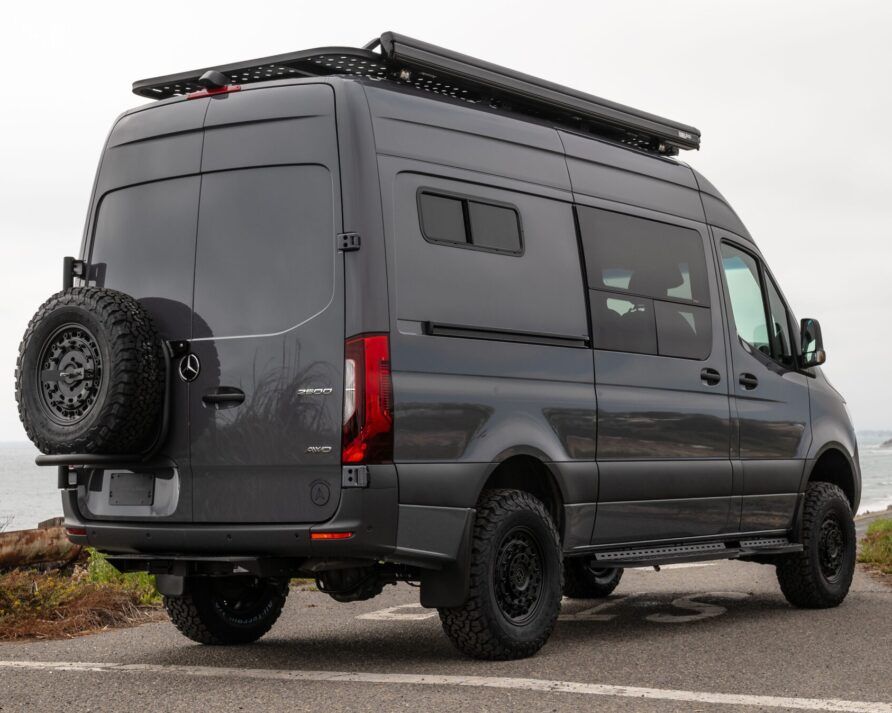
The Sprinter AWD has a payload of 1.3 tonnes
Munro Series M
The Munro M Series is an all-electric 5-seat 4×4 utility vehicle designed and built in the UK.

With a GVM of 3.5 tonnes and kerb weight of 2.45 tonnes, it has a payload of 1.05 tonnes (30%)
There are two models, the M170 (170kW of power and starting at £76k) and the M280 (280kW of power and starting at £90k), and in utility, chassis, and truck variants.
OKA All Terrain Vehicle
The OKA ATV has an interesting history, but its origins were in the Australian mining sector, and it is designed with extreme mobility in mind.
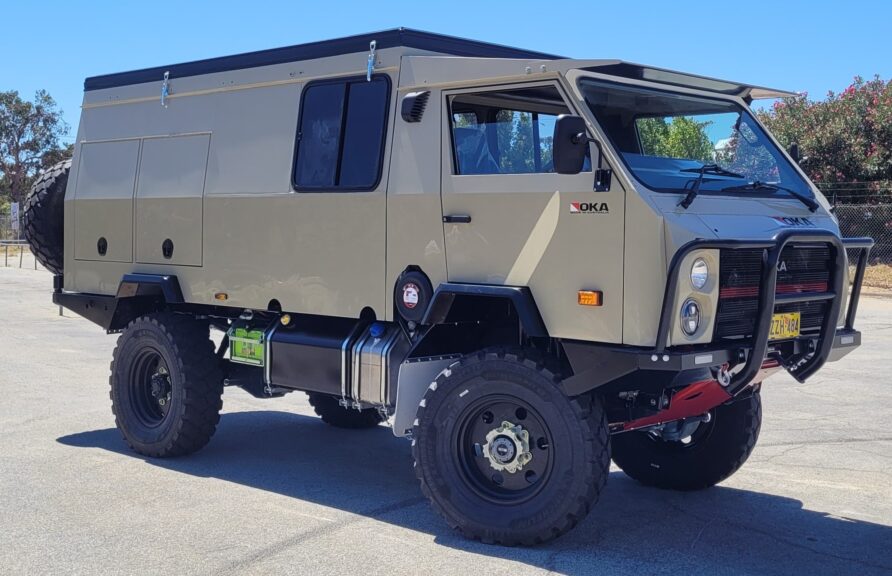
It is available in single cab, dual-cab, multi-cab, van, and bus configurations.
A 6×6 version is also available.
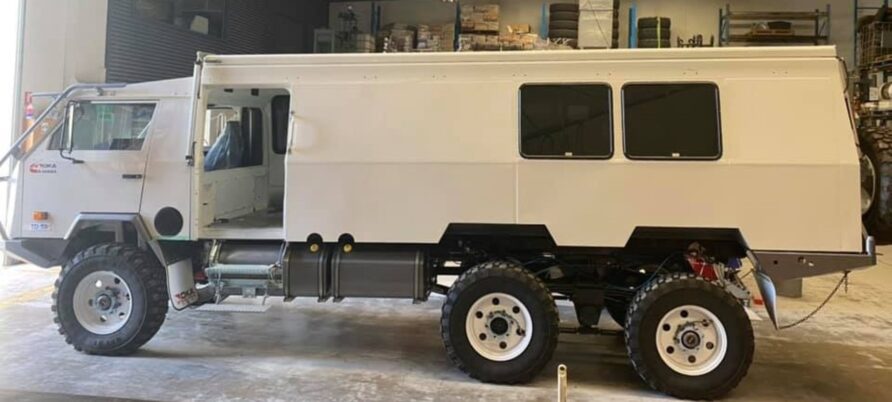
And a standard chassis cab.
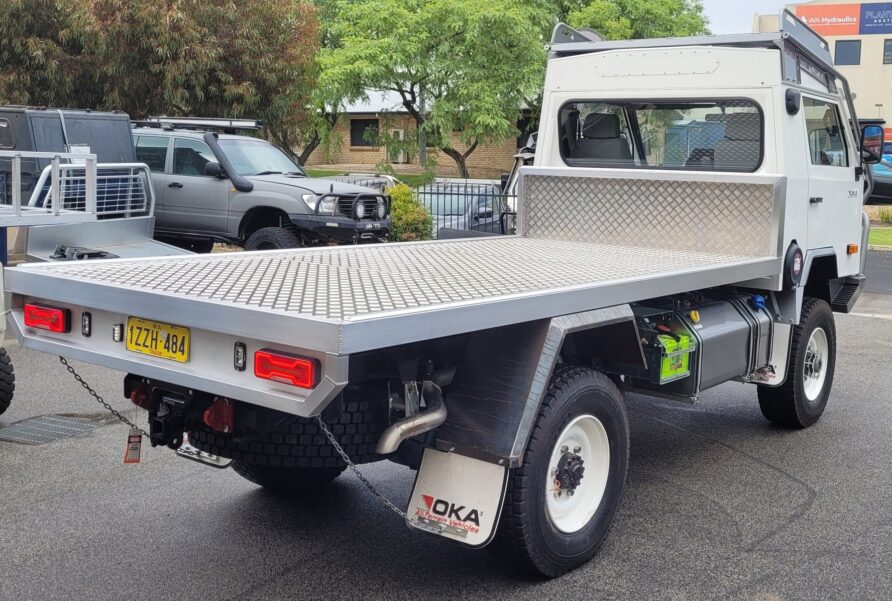
GVM is 6.5 tonnes, kerb weight, 3.6 tonnes, and a payload of 2.9 tonnes (45%)
Polaris Dagor (Deployable Advanced Ground Off-road)
The Dagor seems to be overlooked in many of these conversations, but it is a good fit for the Tactical Vehicle requirement.
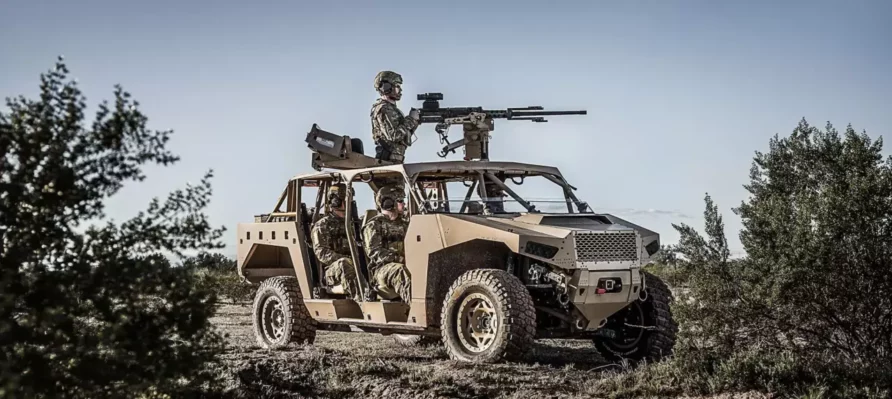
Dagor has four seats plus a load bed that can also be used for seating, taking the capacity up to 9. Or 6, plus some stores and equipment, i.e. half a 12-person team.
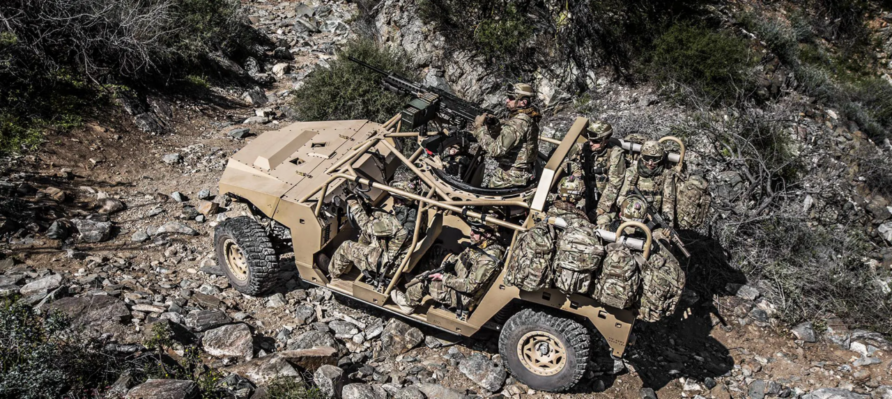
There is even a bridging variant :)
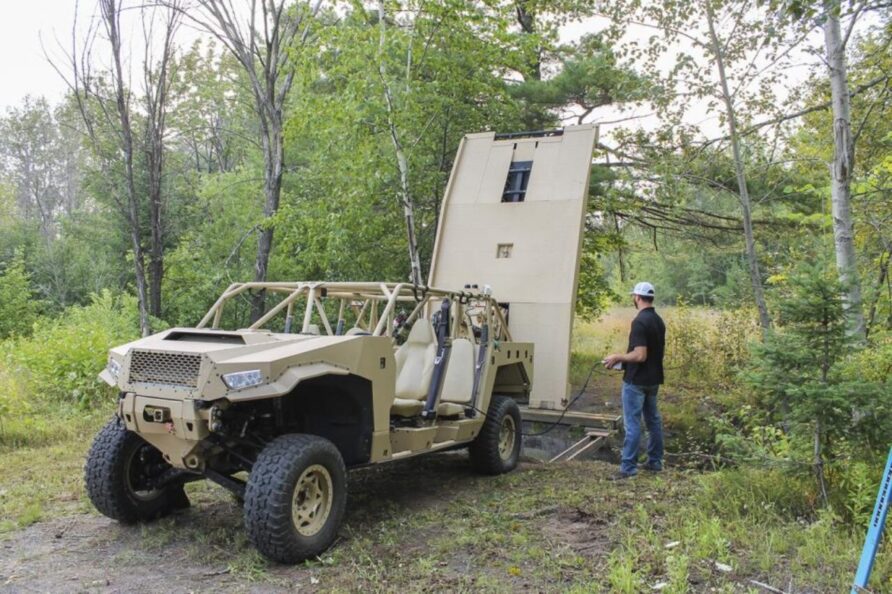
And if extra firepower is needed

The Dagor is 15 kg over the 3.5 tonne GVM limit for a B/BE licence, at 3.515 tonnes. Payload is 1.474 tonnes (42%)
Reform Multi T6
Last of the industrial and agricultural tool and cargo carriers in this list, the Reform Multi T6.
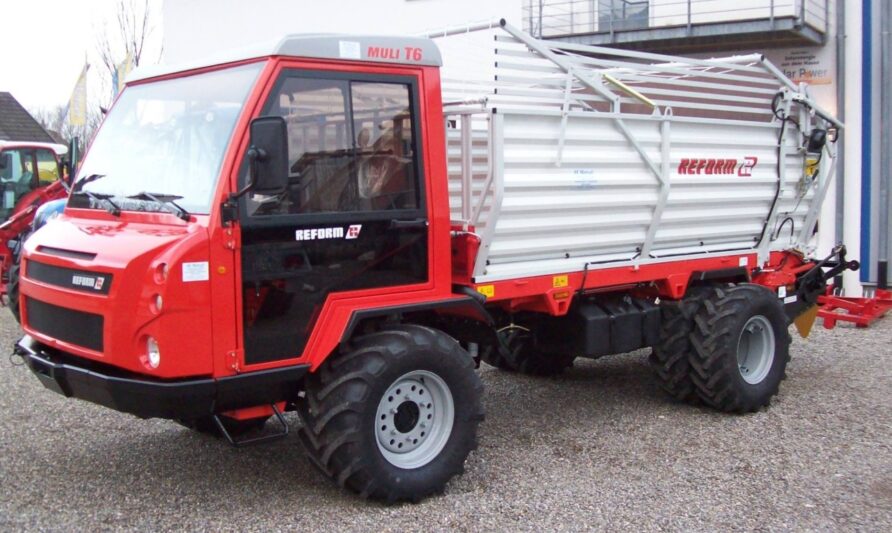
GVM is 7 tonnes, and a kerb weight of 2.56 tonnes, leaving a payload of 4.4 tonnes, a very impressive 63% of GVM.
Various bodies and hydraulic tools can be fitted.
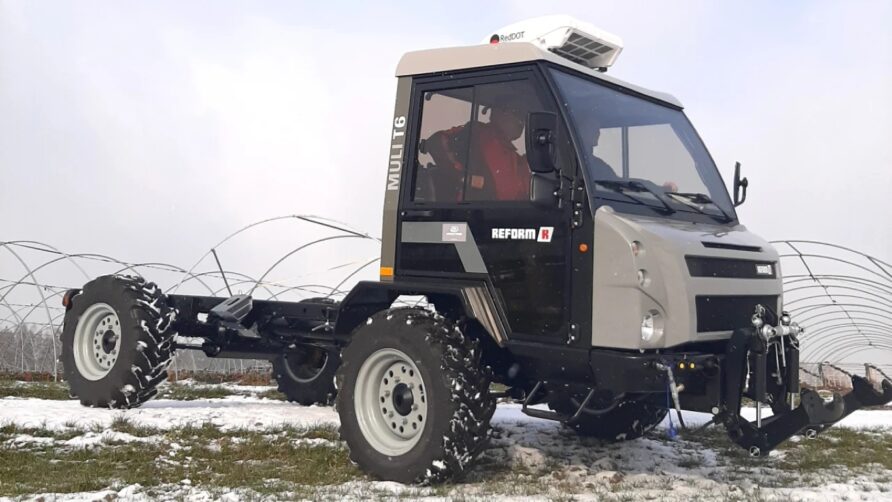
GVM is 7 tonnes, and a kerb weight of 2.56 tonnes, leaving a payload of 4.4 tonnes, a very impressive 63% of GVM.
Like many of its contemporaries, slow, maximum speed is only 40 kph.
Suzuki Jimny
The well known Jimny is no longer marketed in the UK and continued manufacture is uncertain.
Tecnamm in France showcased the three seat Fennec 2 last year, based on the Jimny 4×4.
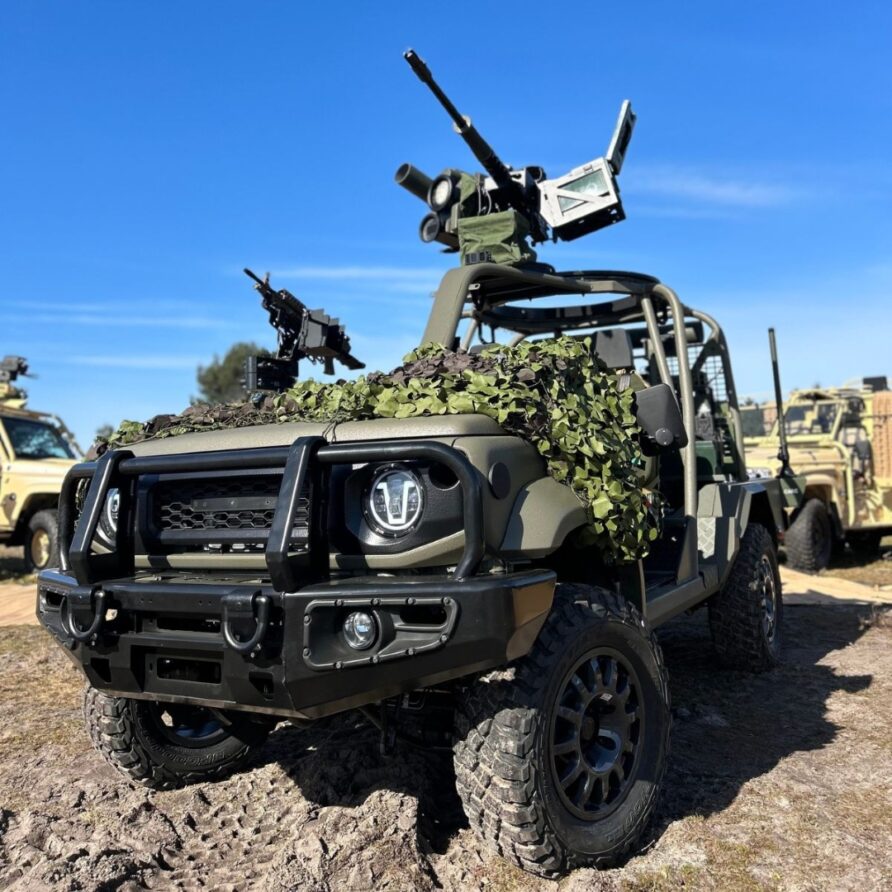
With a GVM of only 1.65 tonnes, two could be lifted by a Merlin, although with a payload of less than 600 kg.
They even put a set of tracks on it.
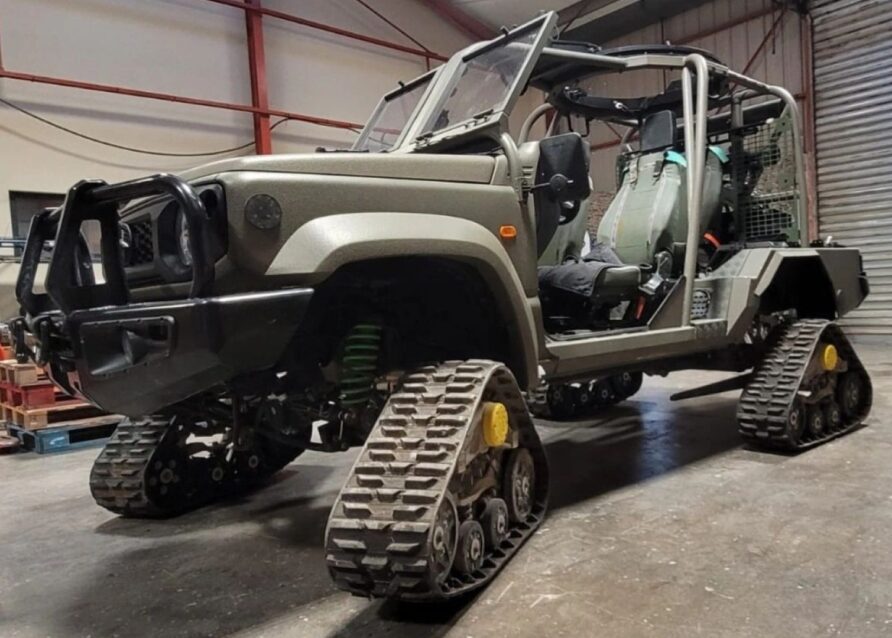
Closer to home, Samson Engineering in Yorkshire offers the Yomper.

This conversion provides a fixed or tilting load bed, and 500 kg payload on the back.
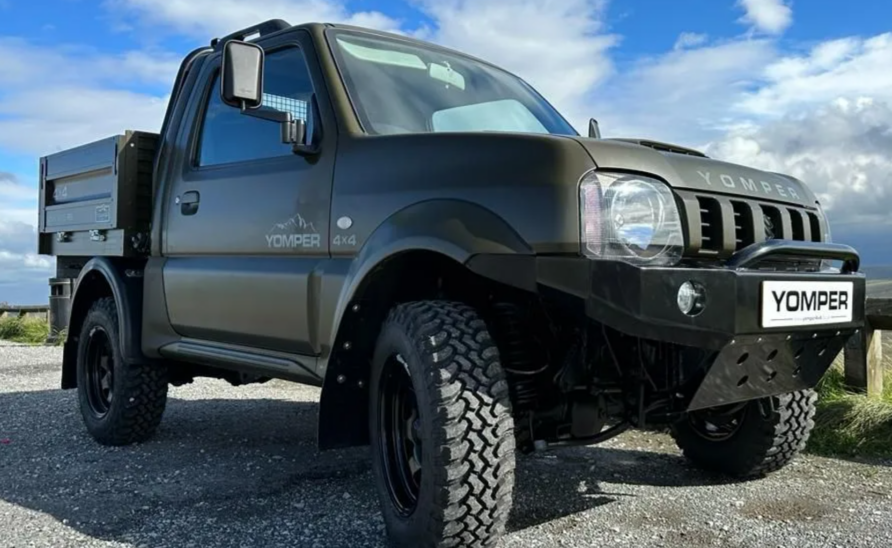
A short wheelbase model with the same payload is also available.
Torgo CP9
Torgo Electric Vehicle are based in Spain and produce two rugged electric utility vehicles, the CP9, and CC3.
The CP9 can be fitted with different cab and load bed configurations, including the 6+2 pickup arrangements in the image below.
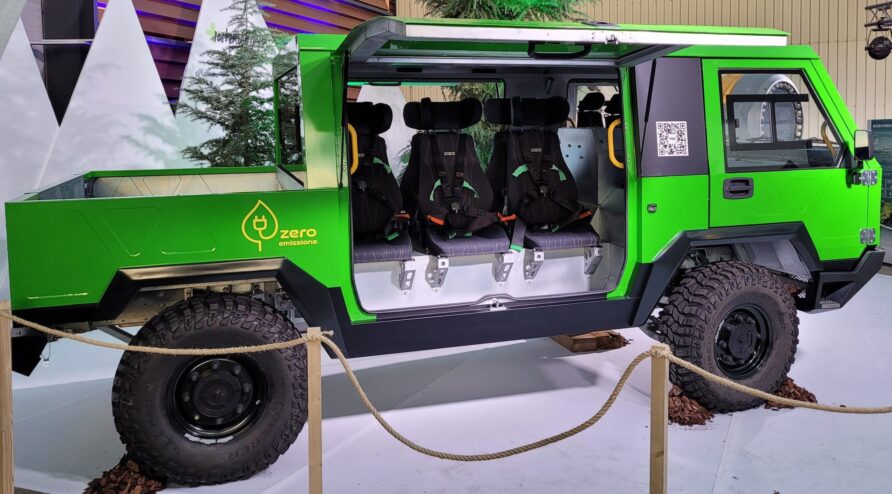
The payload is 2.0 tonnes, with a GVM of 6.4 tonnes.
The range is limited to 100 km.
Toyota Land Cruiser Series 70
The Land Cruiser is currently manufactured in Japan, although local assembly for European and other markets is also carried out at the Caetano Portugal Plant.
The 70 series is not to be confused with the 250 series, built on Toyota’s GA-F platform, as currently sold by Toyota UK.
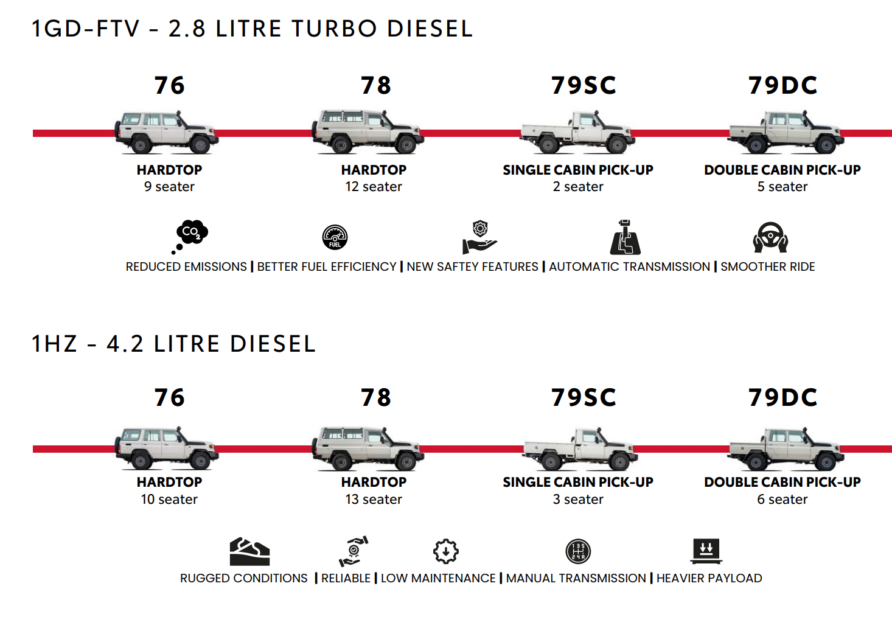
The 78 and 79 series in the image above, with the 2.8L turbo diesel engine, each have a GVM of 3.3 tonnes.
The 12 seat hard top and double cab pickup has a payload of 0.995 tonnes (30% of GVM), and the single cab pickup, 1.09 tonnes (33% of GVM).
All are available in left and right-hand drive.
Toyota Gibraltar Stockholding (TGS) sells the 70 series to humanitarian and government organisations.
A standard, podded, or pickup ambulance is made by TGS
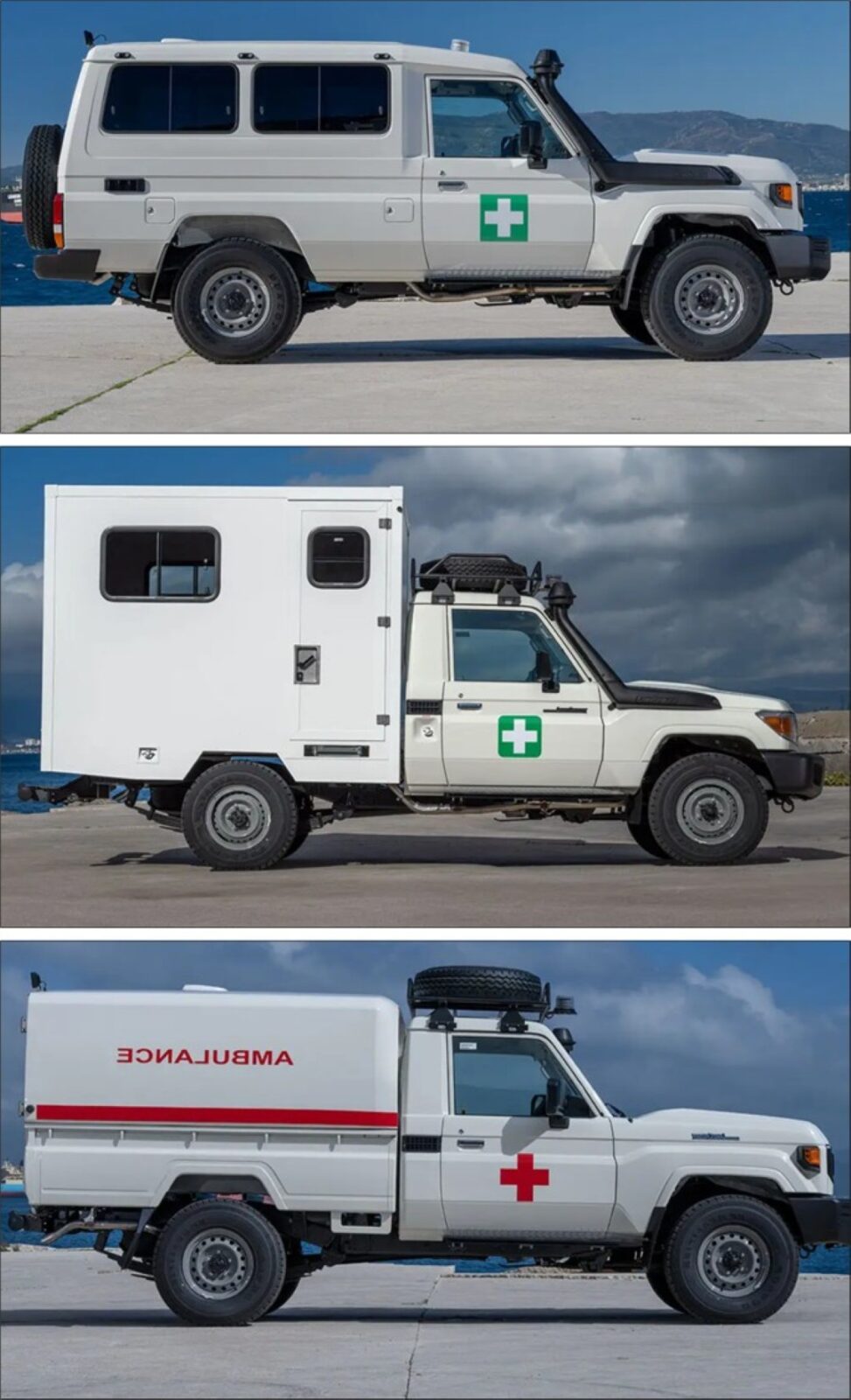
The Land Cruiser 70 Series is extremely popular in Australia, where the standard models all have a GVM of 3.5 tonnes.
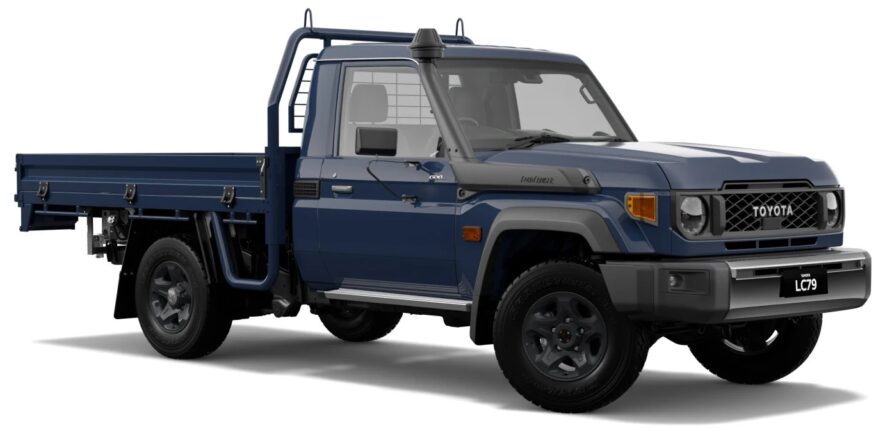
The Single Cab GXL (AUS), Double Cab GXL (AUS), and Wagon GXL (AUS) have payloads of 1.315 tonnes (37%), 1.27 tonnes (36%), and 1.21 tonnes (34%) respectively.
There is a large after market of integrators, who sell everything from portal axles and equipment shelters, to custom load trays
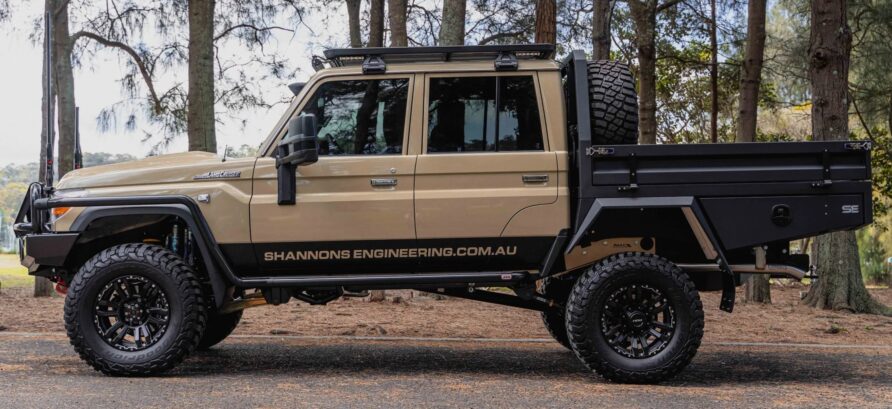
and 6×6 conversions.
A 6×6 single cab conversion from Multidrive ups the GVM to 5.75 tonnes with a payload of 3 tonnes (53%).
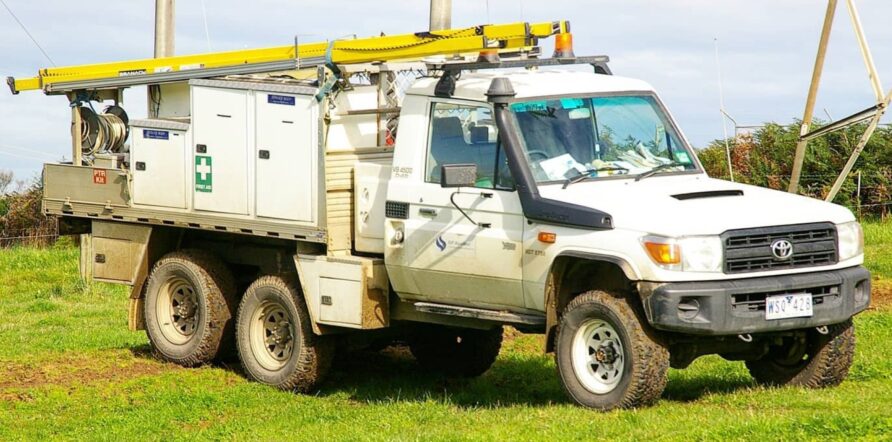
The double cab increases the kerb weight by a small amount.
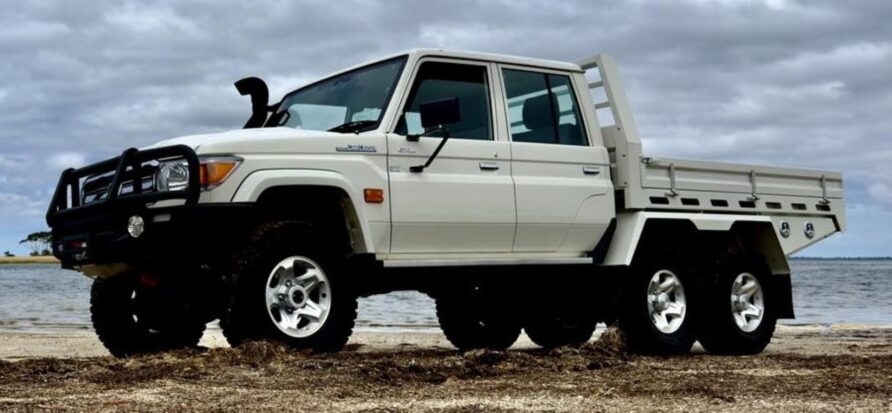
There are numerous military users of the Land Cruiser, including UK Special Forces.
Dajbych in the Czech Republic has recently shown a box body Land Cruiser 79 series box body ambulance.
Jankel created and sold various Land Cruiser 70 series special forces vehicles, with the IP now owned by NP Aerospace.
Ukraine uses them, in a protected variant.
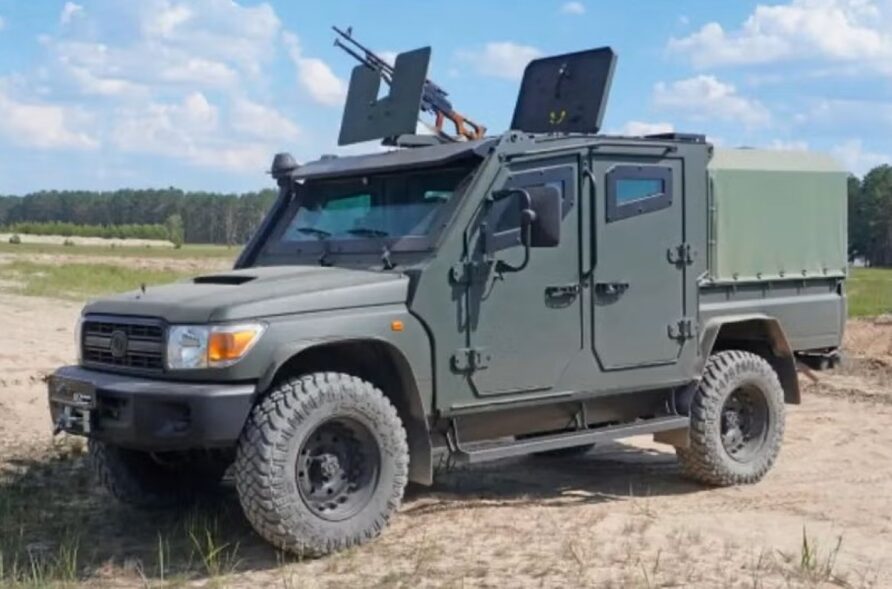
The Canadian company, Roshel, markets the Captain STANAG Level I/II 8-seat protected vehicle, based on the Land Cruiser 70 series.
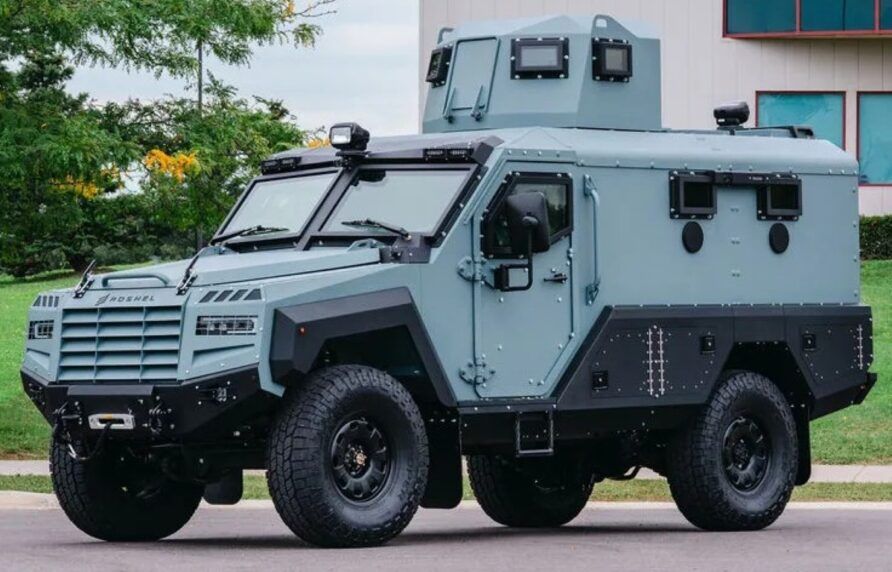
Recently delivered to Haiti, in a container.
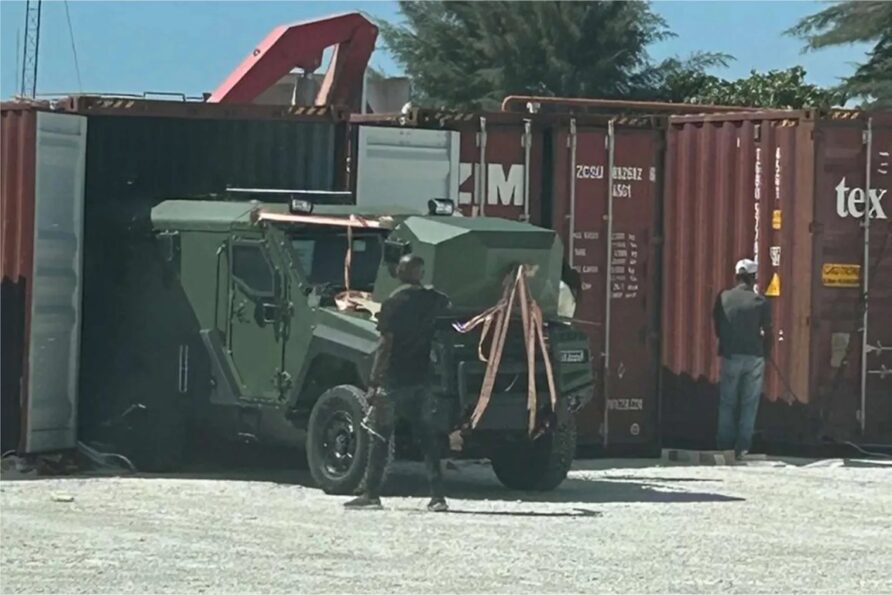
Armour Max in South Africa has created the Tac 6 6×6 vehicle, based on the LC79, but using a custom designed and built chassis extension, and upgraded components, some from DANA.
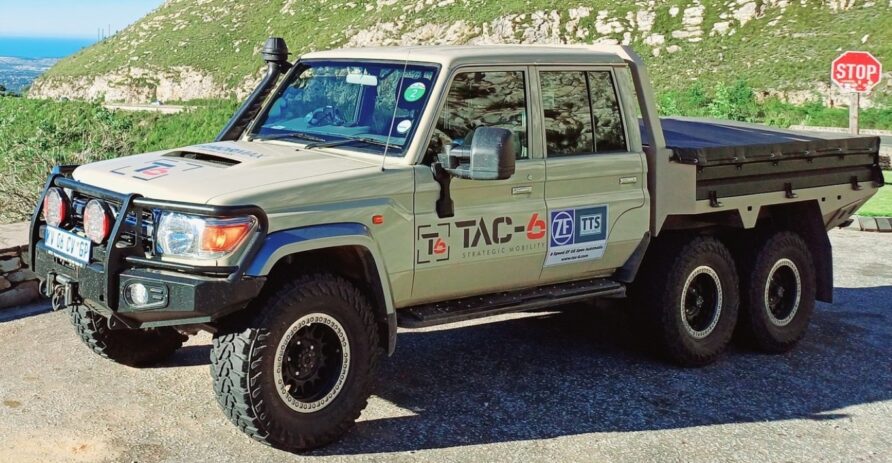
The Tac-6 GVM is 7 tonnes, with a kerb weight of 2.95 tonnes for the single cab, and 3.08 tonnes for the double cab.
This provides a payload of 4.05 tonnes (58%) and 3.92 tonnes (56%) respectively.
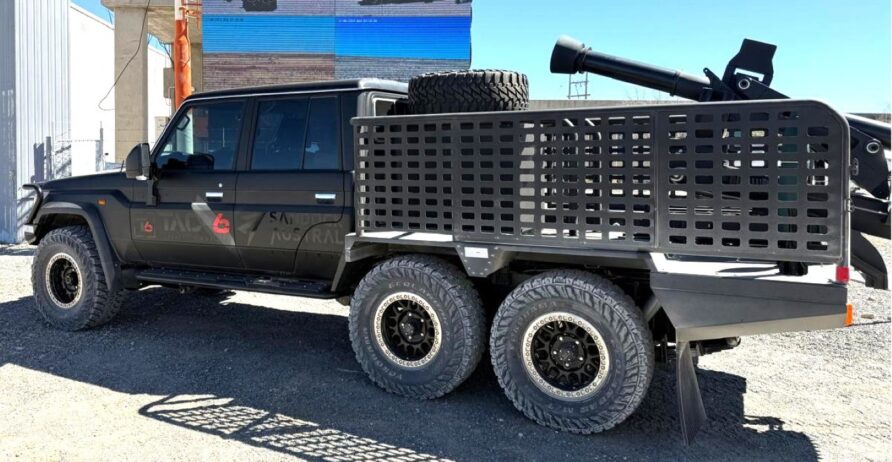
Aside from the basic utility variants, Tac 6 has been tested with a RWS and automatic cannon, and swing down mortar.
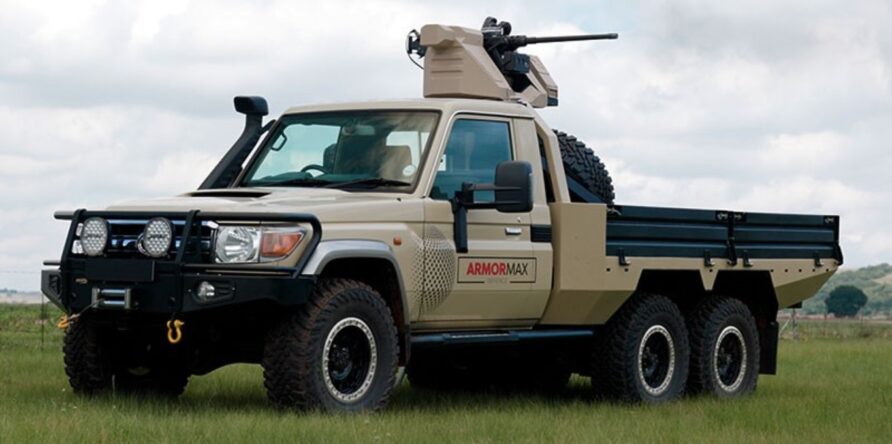
For the LMV competition, Babcock offering, the General Logistics Vehicle (GLV), 1.79m wide and several wheelbases and variants, including a 6×6.

The short wheelbase variant shown below.
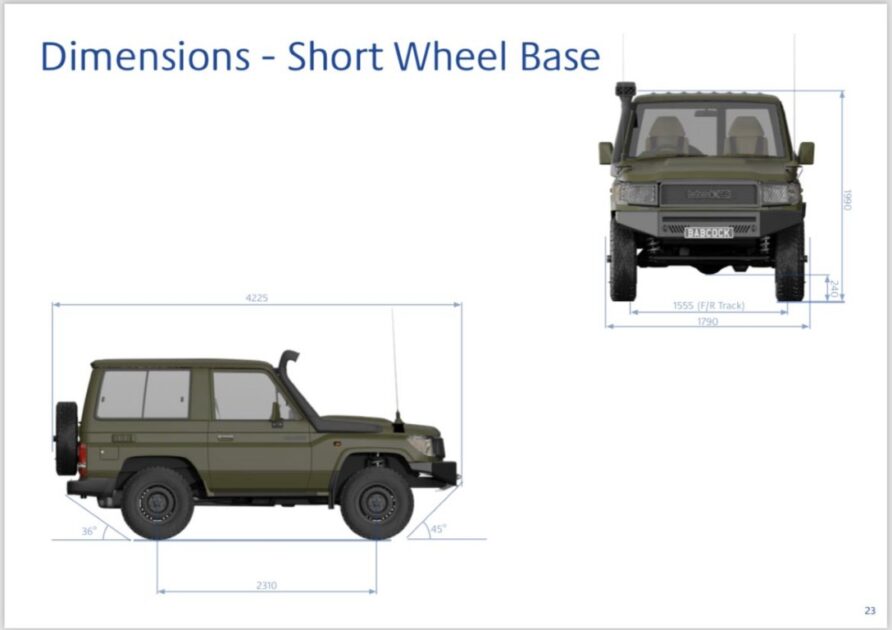
The medium wheelbase would likely be the most common type if selected.
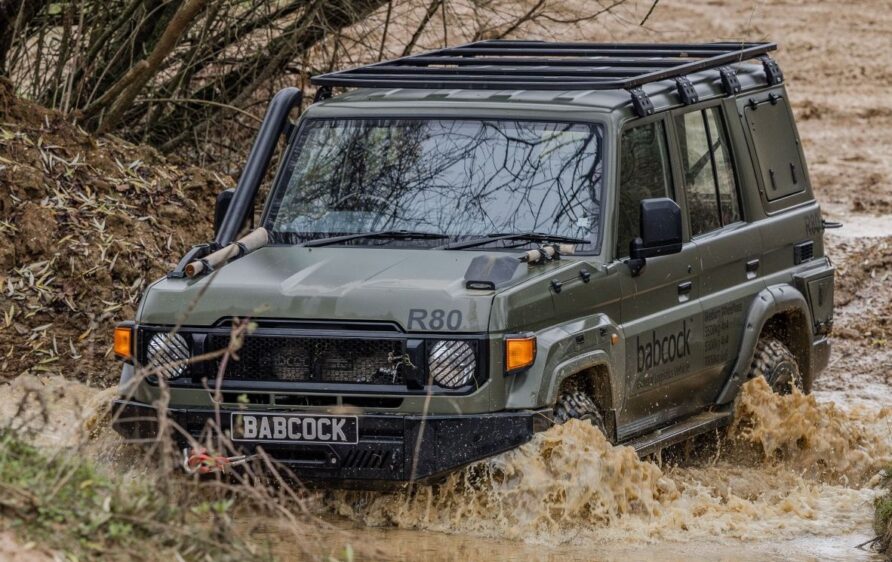
The long wheelbase variant is shown below.
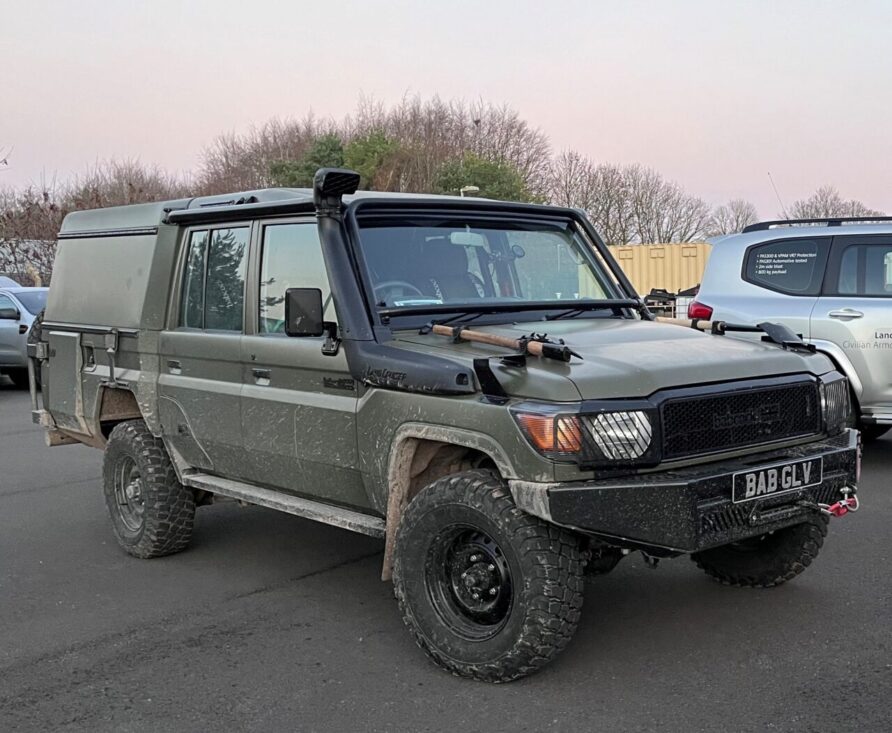
The long wheelbase variant can accommodate 8 seats, or four and a NATO pallet, or seating for systems operators.
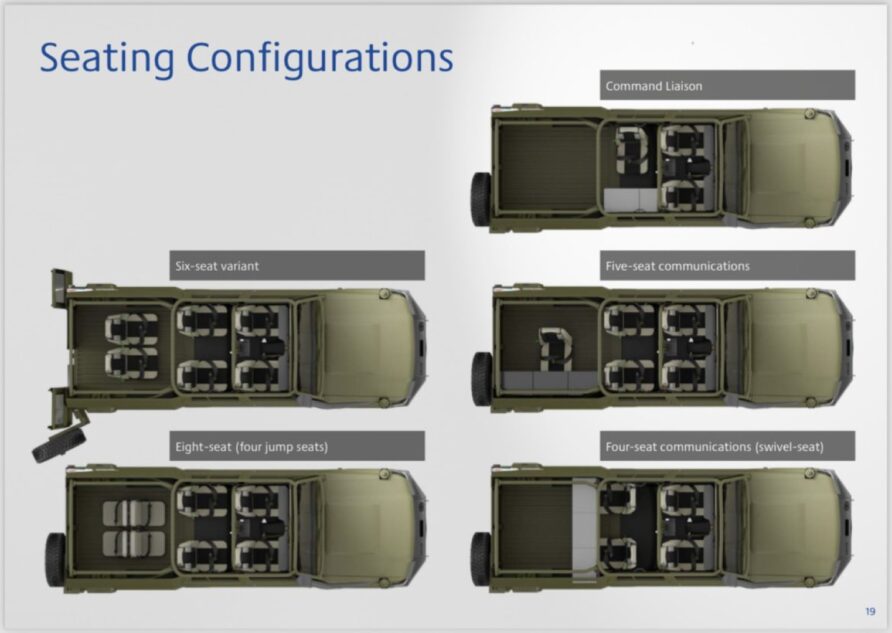
Loading a NATO pallet (the split rear door also allows opening with an attached trailer)

The seats are mounted on rail systems.
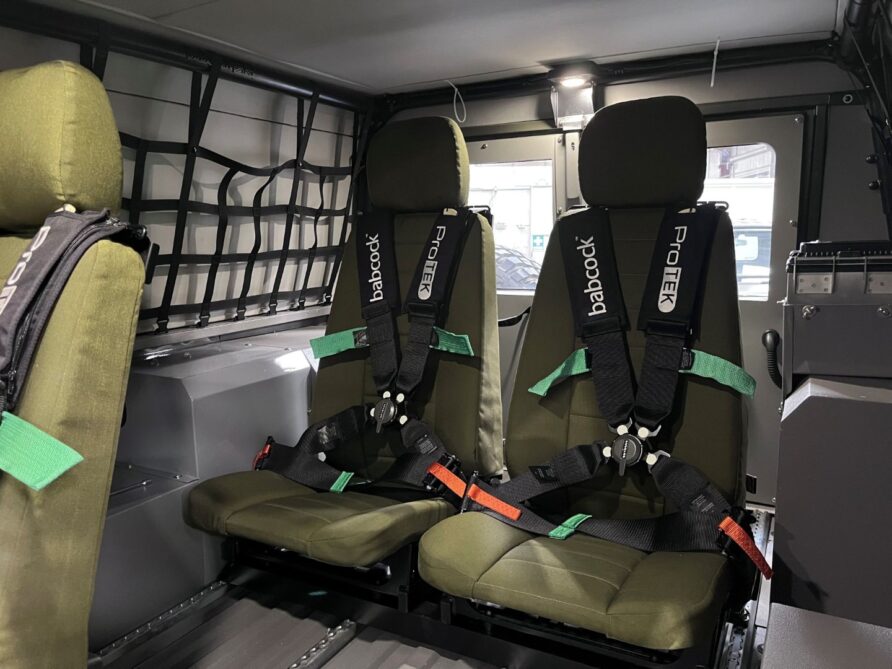
Babcock has also shown a single cab load bed variant that increases the departure angle but adds a very useful load space.
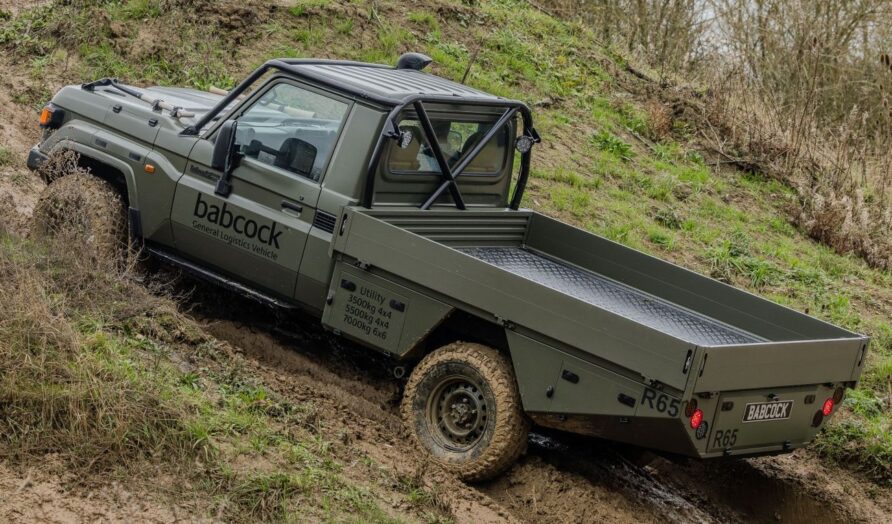
The 6×6 hooklift.
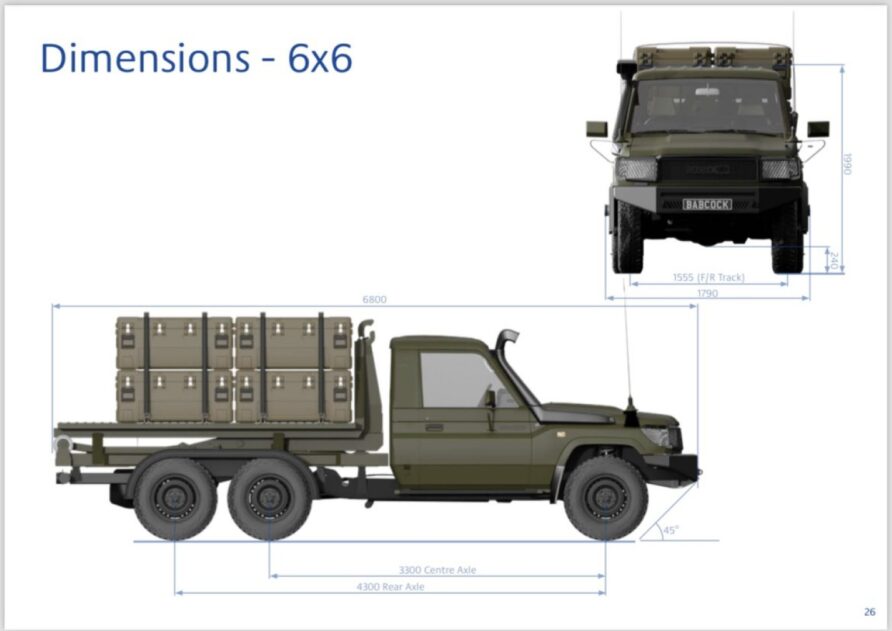
Two short wheelbase variants could fit in a Chinook, or one medium/long wheelbase, although the extra space in a Chinook provides an option for a trailer.
An ambulance variant.
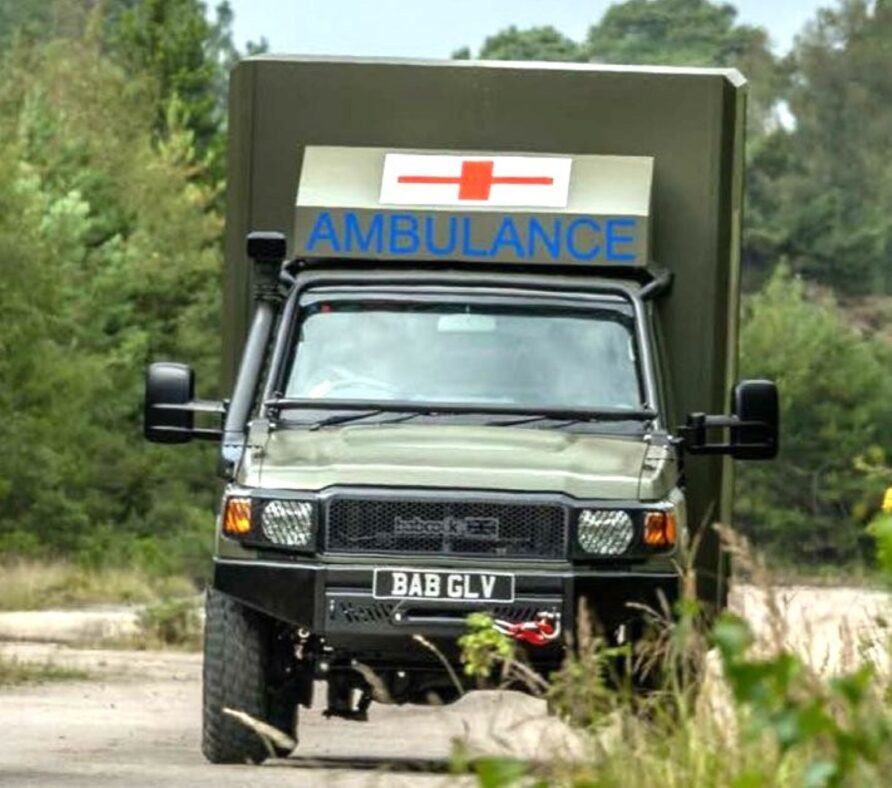
The short, medium, and long wheelbase variants are plated at 3.5 tonnes GVM, but have a design GVM of 4 tonnes (although this requires some vehicle modifications that would increase costs, and could be omitted)
Payloads are 1.6 tonnes (46%), 1.1 tonnes (31%), and 1 tonne (29%) respectively
(percentages based on the 3.5 tonnes for consistency with other vehicles in this post)
The armoured long wheelbase has a GVM of 5.45 tonnes and a payload of 1.45 tonnes (27%), although again, this might reduce slightly in productions.
The 6×6 has a GVM of 6.8 tonnes and a payload of 3.8 tonnes (56%)
Technamm in France are another well-established vehicle integrator with a wide range of 70 series vehicles.
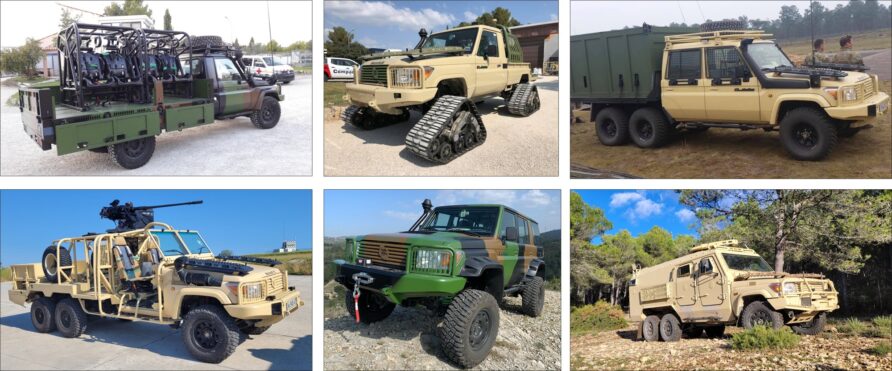
The world is not short of Land Cruiser 70 series options.
Toyota Hilux
Another Toyota, the Hilux is a utility a pickup truck, directly available in the UK from the Toyota dealer network.
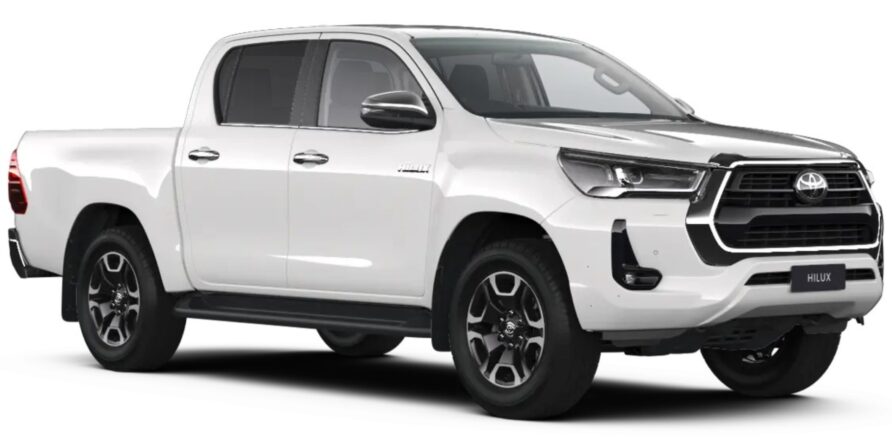
Performance is comparable to its peers like the Ranger and D Max, a payload of approximately a tonne (32%) with a GVM of 3.2 tonnes.
Glomex Military Supplies from the Czech Republic recently won an order for 1,200 modified Toyota Hilux vehicles, and in Finland, something similar using a local integrator called TruckMasters.
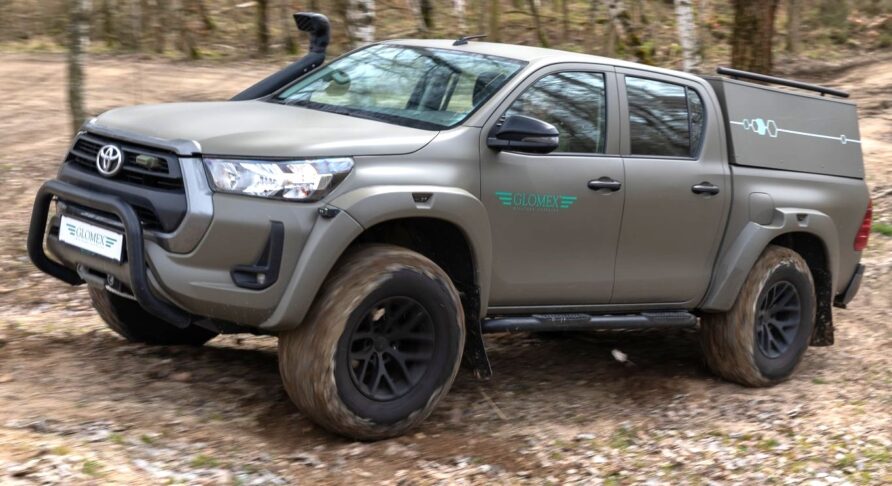
Prospeed have developed a 6×6 variant of the Hilux called the Hiload, replacing the chassis and increasing the GVM to 5.6 tonnes and payload to 3 tonnes (56%)
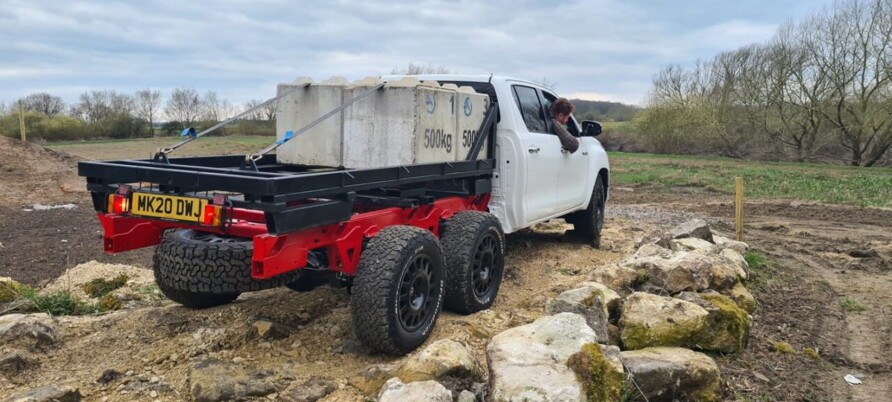
The Hiload has been used across multiple industry sectors, and demonstrated in military configurations.
Several additional concepts have been virtualised.
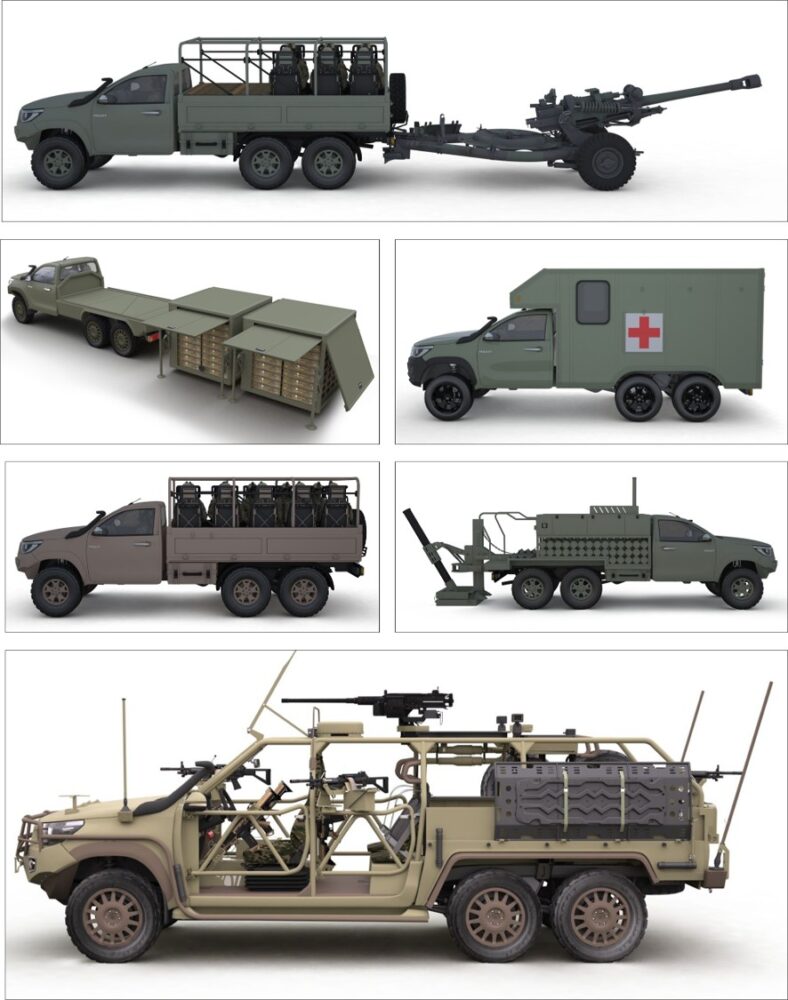
Including a hooklift.
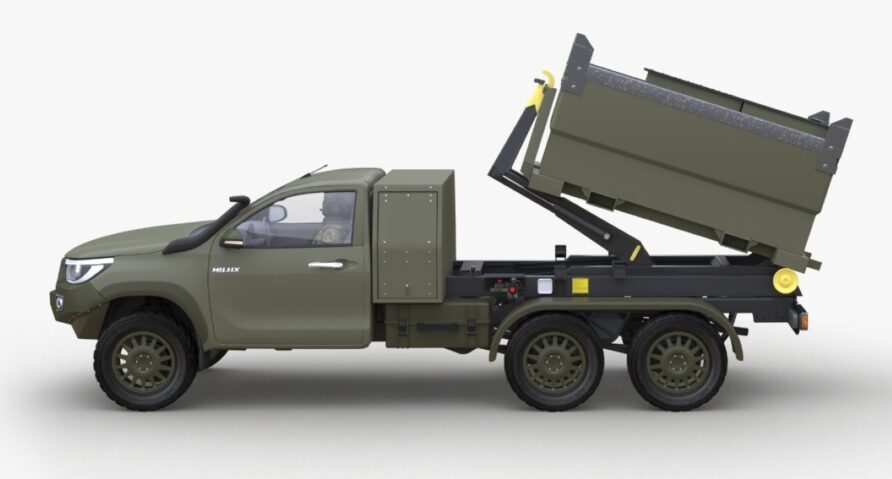
Hiload have also developed a 4×4 Light Mobility Vehicle variant with a GVM of 5.0 tonnes and payload of 2.8 tonnes (56%)
The protection scheme is provided by ACS in Germany (note, the same as used by the Caracal)
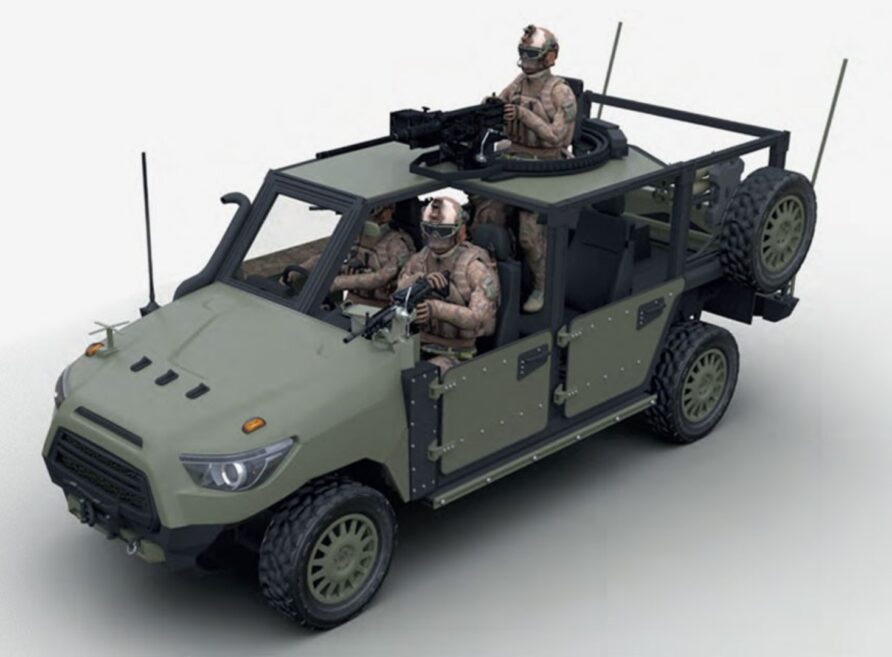
Supacat and Prospeed have partnered for the LMV competition, using ACS as a supplier.
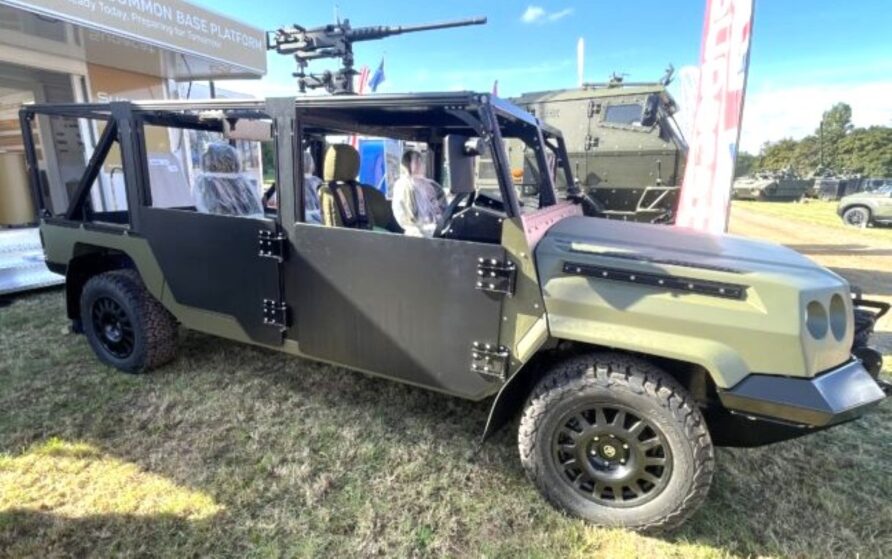
LMV uses Toyota Hilux components, although it might have been fairer to describe this in a separate section.
The EINSA NETÓN is used by the Spanish Army Mando de Operaciones Especiales (MOE), or Special Operations Command.
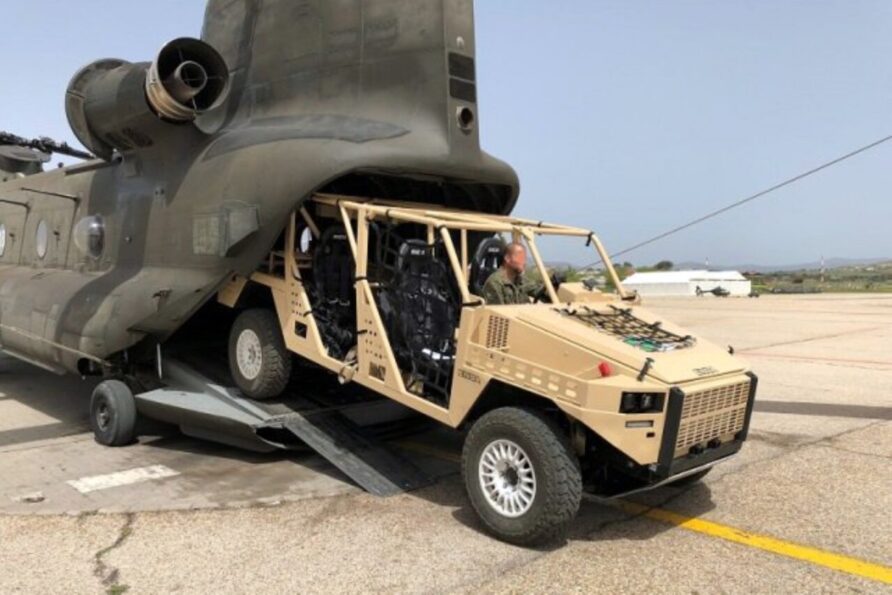
It, too, is based on a Toyota Hilux platform, with EINSA modifying it for special operations use. Twenty-four have been purchased at a cost of approximately £150k each.
Volkswagen Amarok
More or less the same vehicle as the Ford Ranger, included here for completeness
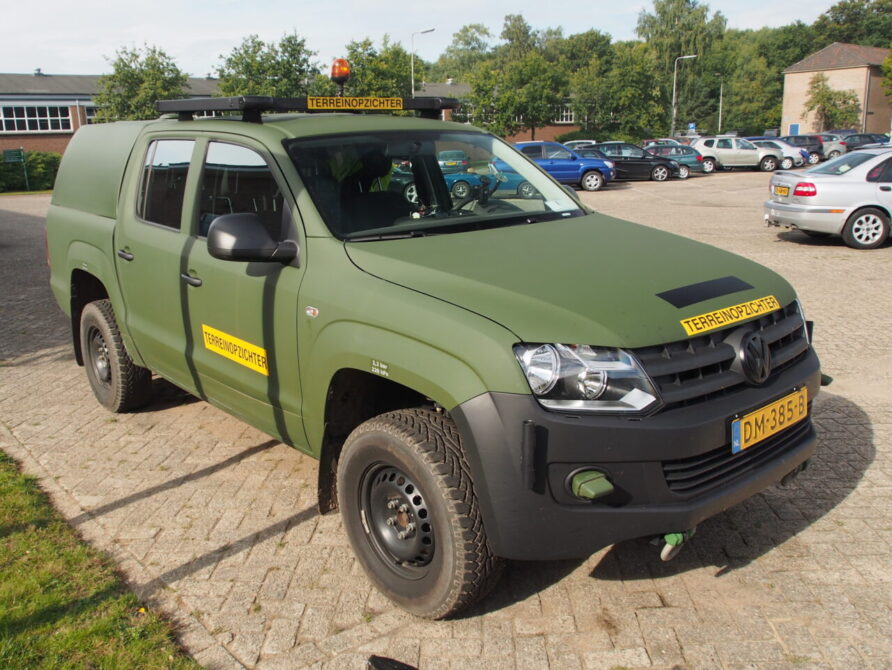
VR-1 Fox
Last but by no means least, the VR-1 Fox from Latvia.
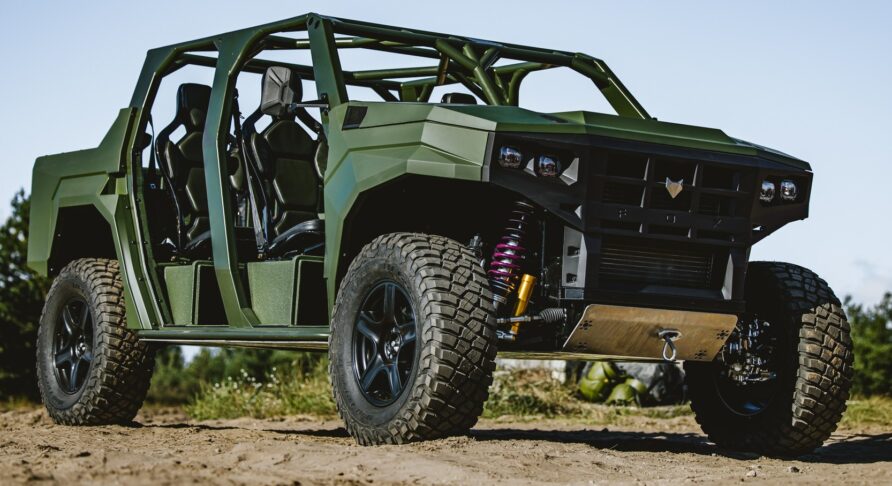
With a GVM of 3 tonnes, and a kerb weight of 1.775 tonnes, it has a payload of 1.23 tonnes (41%)
Other variants are planned.
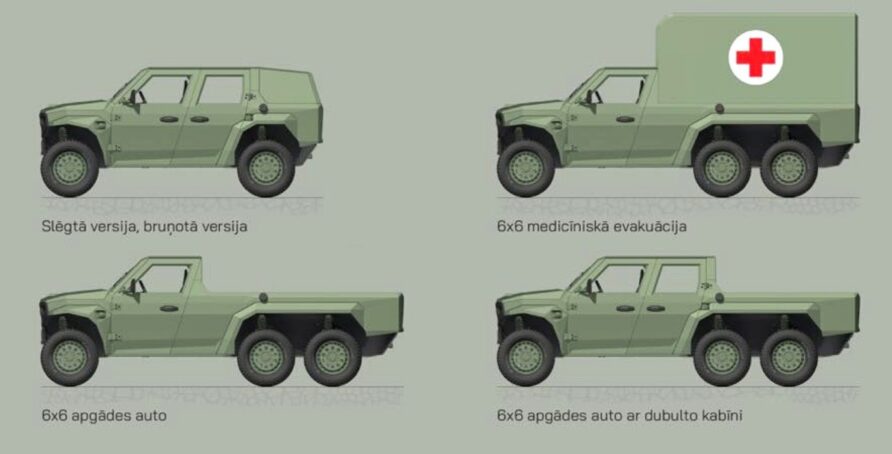
Although it is still early days.
Next and Final Post
In the next and final post, I will have a go at making comparisons between the eclectic collection of vehicles and make a proposal or two.
Discover more from Think Defence
Subscribe to get the latest posts sent to your email.

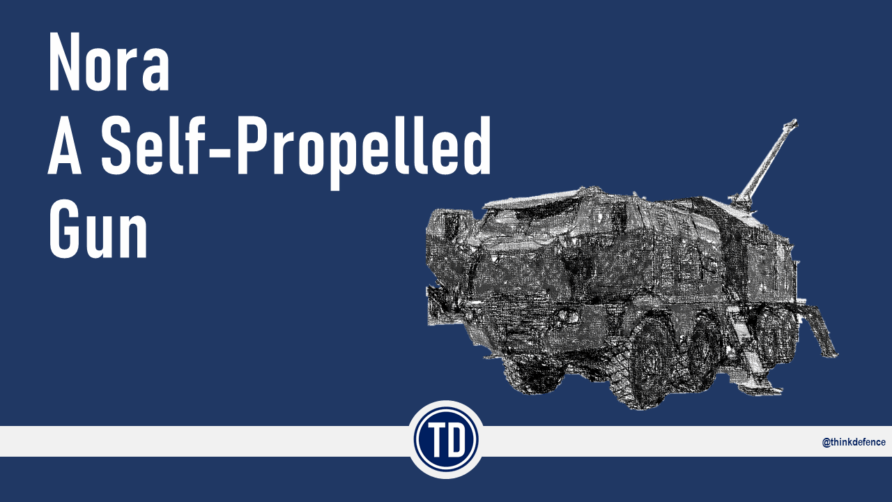
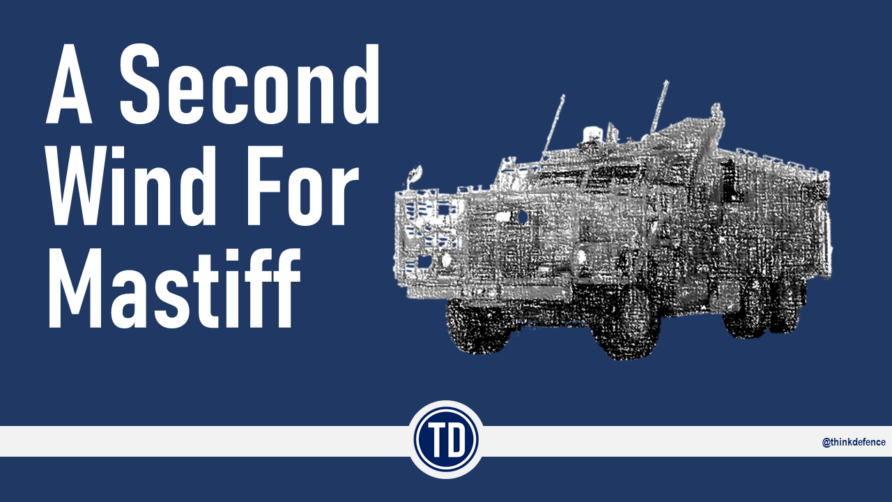
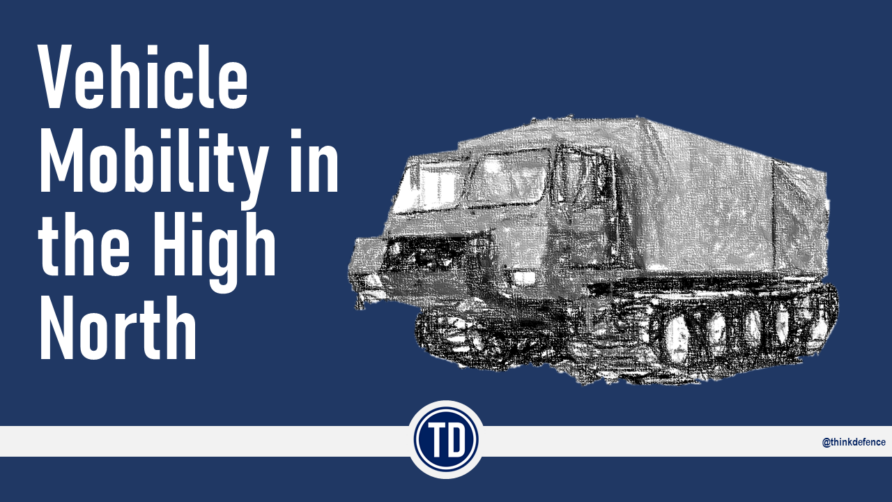
Thank you for some pretty extensive research
Some highly competent vehicles here , guess politics will play a part , but the Land Cruiser should be a front runner .
The various guises aof the Land Cruiser are very impressive indeed and perhaps could be procured in different levels of "ruggedness"….a mildly upgraded version of the already hardy civilian version would surely be perfectly good for Home Defence. The Ford Ranger and Isuzu D-Max also seem very good choices.
Politics will no doubt play a part and it would be interesting if a line could be set up to make the winner here, if the order could be made big enough.
This was a great article though and I really enjoyed reading it.
In an alternative universe Freight Rover and Land Rover came to be one entity and have been producing decent pick-ups with lots of SV options for a few decades now………
In our world? As interesting as some of the offerings from minor makers are I would go with Toyota. A Toyota Hi-Lux fits inside Merlin if I remember rightly. Toyota was also the first major auto-maker to come out to speak the truth about EV.
Regarding Land Cruiser 70 series:
These are dirt-cheap light APCs.
https://svi.co.za/max-3/
Thanks Sven, thats a new one on me, will add to the mix on the next edit